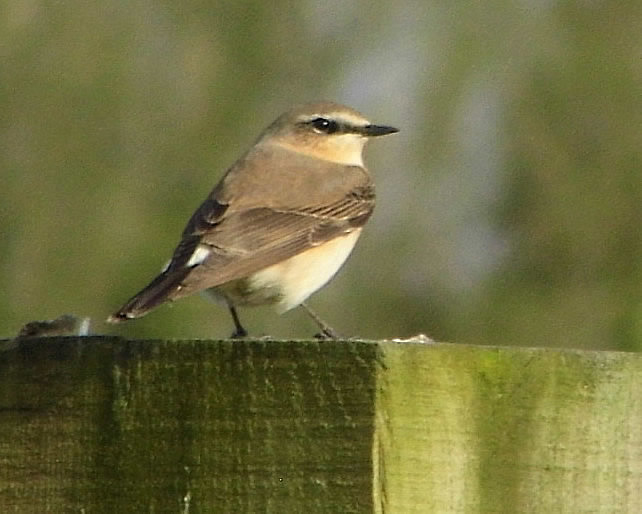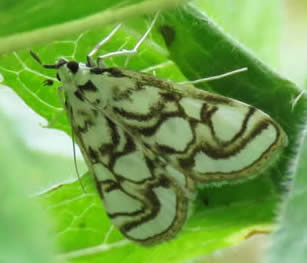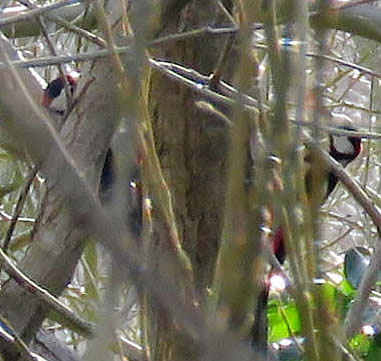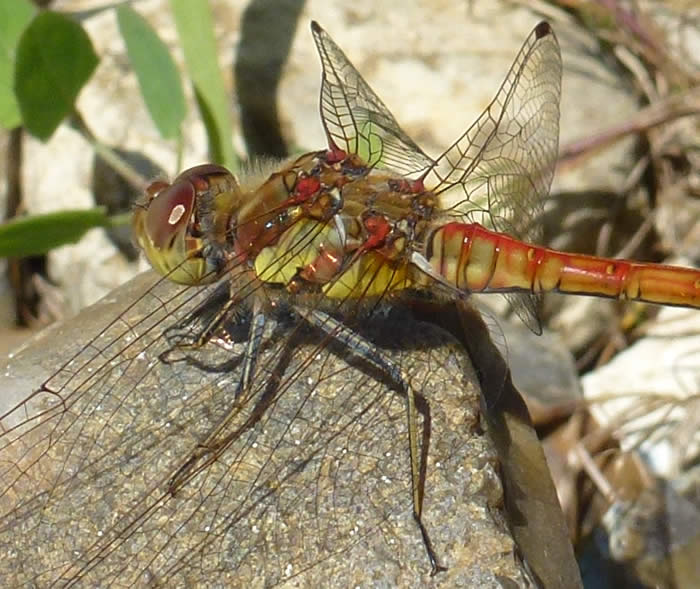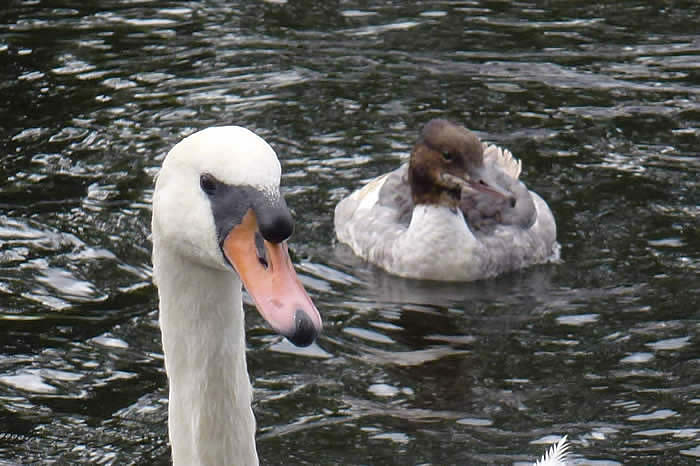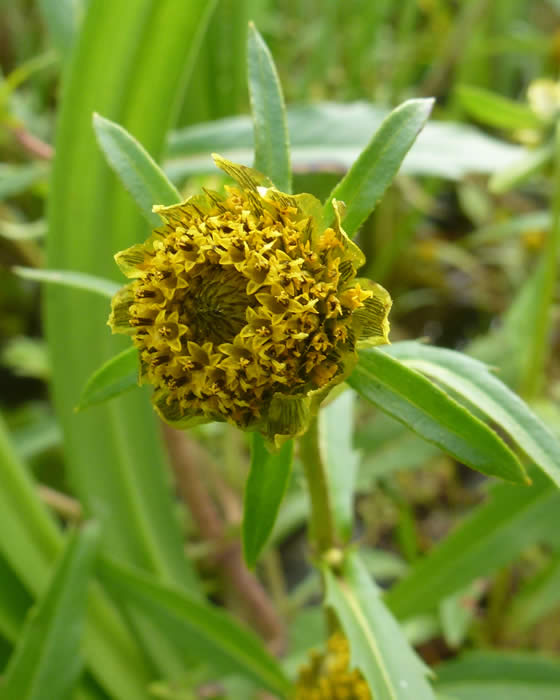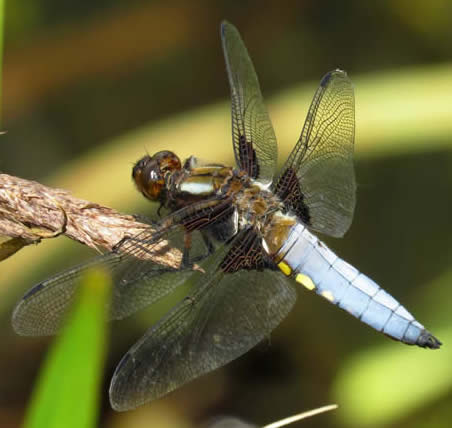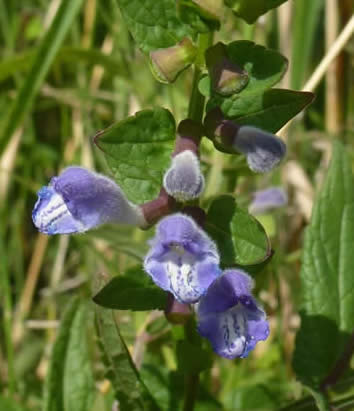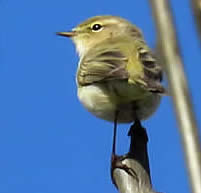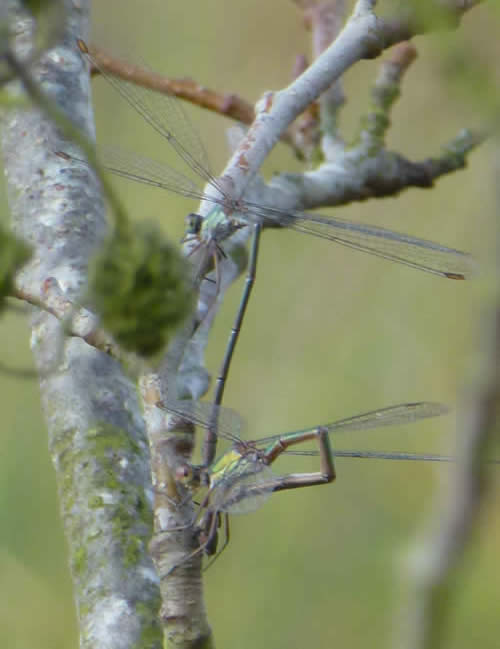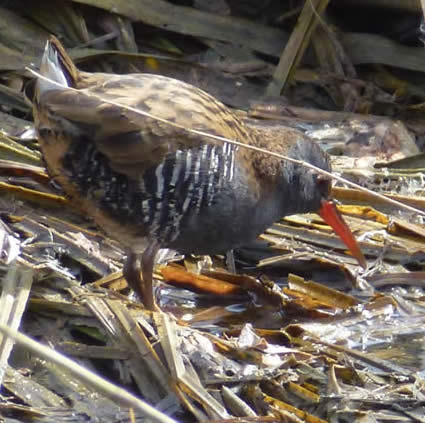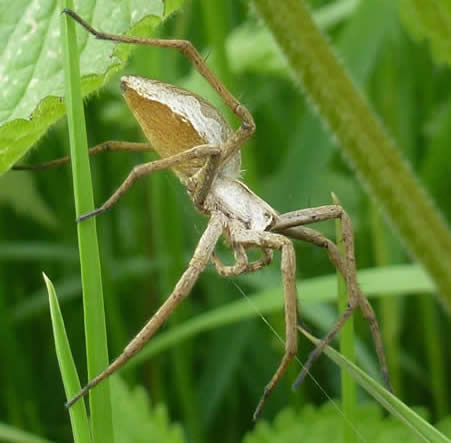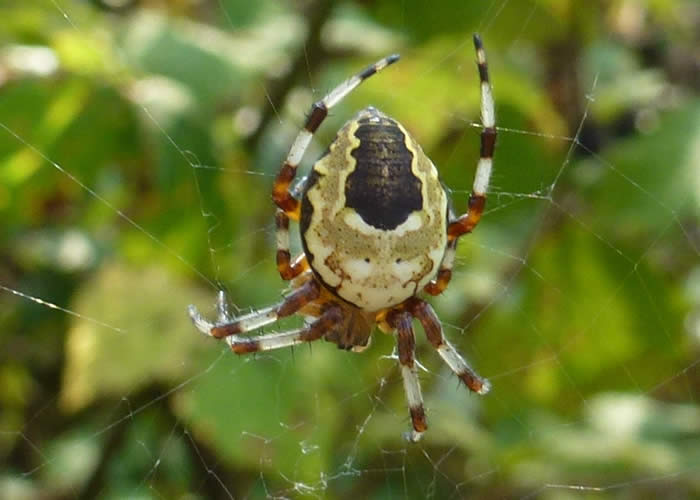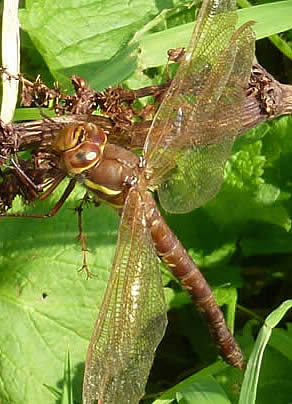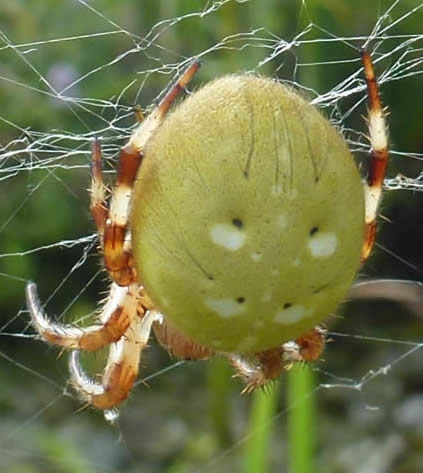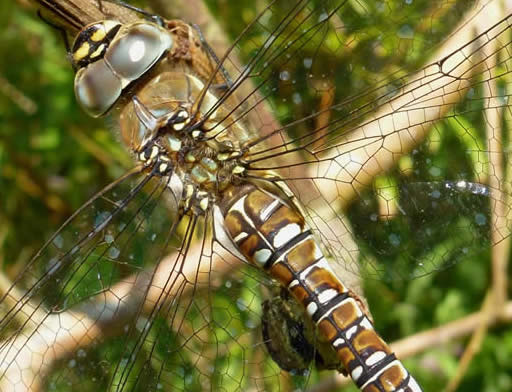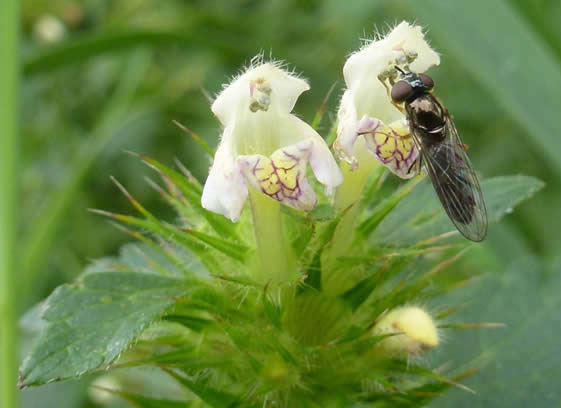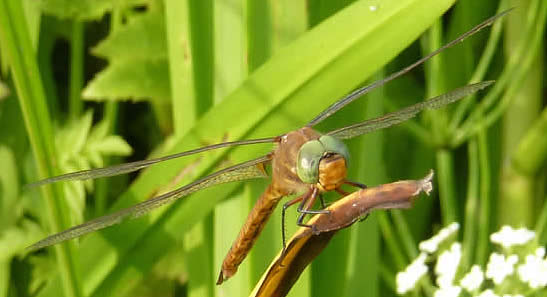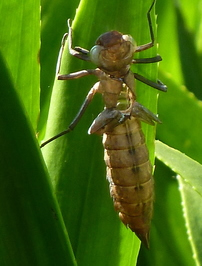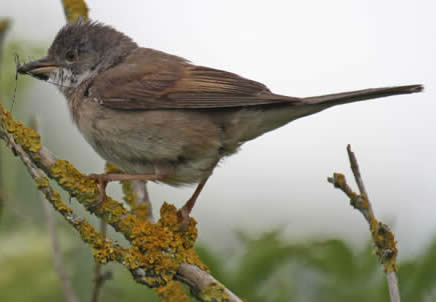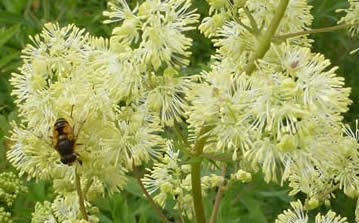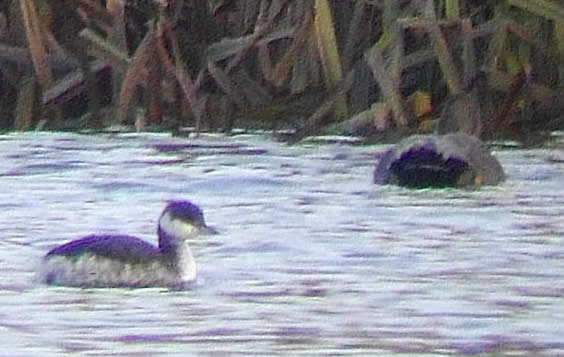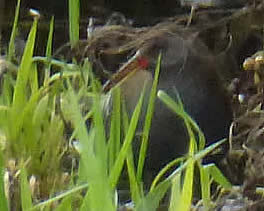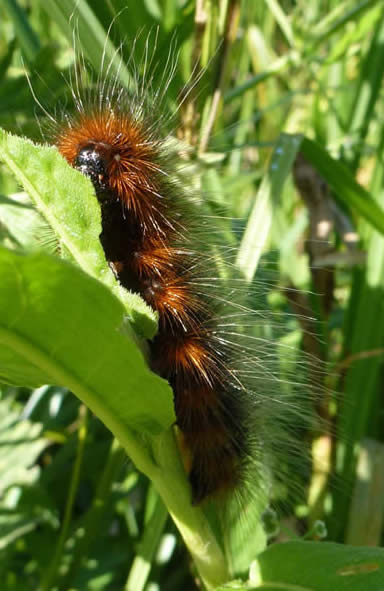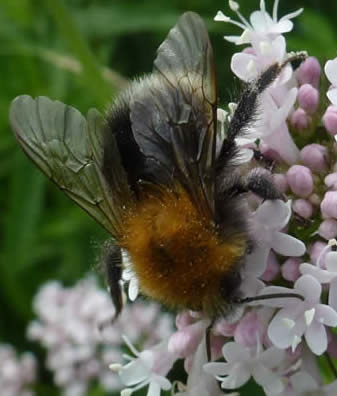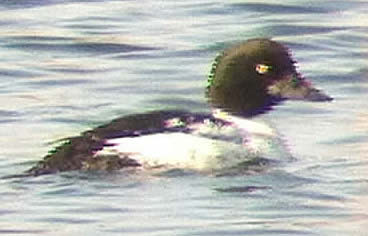Thorpe St Andrew Marshes - archive
Thorpe St Andrew Marshes – often called Thorpe Marshes for short – is the Norfolk Wildlife Trust’s nature reserve on the edge of Norwich, established in 2011.
This page is to hold photos and information that aren't current, such as a month-by-month guide to the reserves and wildlife sightings 2012-21. If you've come to it by chance, please go click onto the main Thorpe Marshes page.
Fungus feature
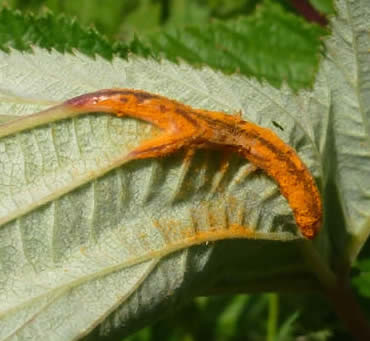
James Emerson found and photographed the blackfoot polypore, left, growing on a willow in the wooded area between Bungalow Lane and the river (29 June). He also found a name for the orange rust growing on meadowsweet: it is Triphragmium ulmariae, and it's near the gate (photo 30 June). Other meadowsweet plants have a white mildew on them, best guess Erysiphe ulmariae. (Meadowsweet is Filipendula ulmariae, so the names seem to link well.)
Spider feature
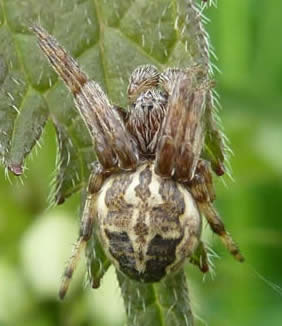

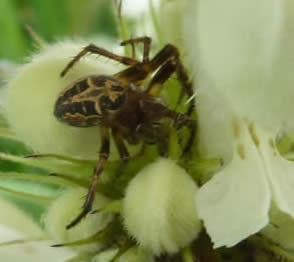
Furrow spider Larinioides cornutus. These spider photographs are from 8 May 2015, from the riverside path. The white deadnettle flowers on the right give an idea of the relatively small size of this species. The fourth (right hand column) is the much larger nursery web spider Pisaura mirabilis. Thanks to Pip Collyer for the IDs. In the right hand column (near top) are more spiders, from autumn 2014.
Thorpe Marshes through the year
November: the focus shifts to wintering birds. Ducks on St Andrews Broad can include gadwalls
often the commonest, though tufted ducks may overtake them later, teal and shoveler, plus snipe and meadow pipits on the grazing marsh. With any luck a stonechat or two will be with us all winter again. There can still be bursts of bird song: Cetti's warbler, robin and wren. Water rails call.
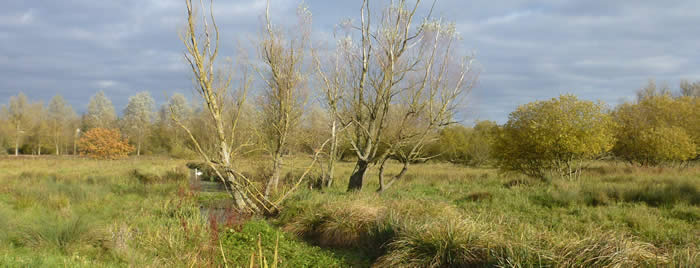
October: an in-between time, as flowers and dragonflies are just the last-lingering types. It's a good time to see caddis flies emerging as moth-like adults, having spent their larval stage underwater in St Andrews Broad. Few winter birds have arrived, but if you're lucky one morning, you might see flocks of redwings and fieldfares moving west along the Yare Valley, having just arrived in the UK from Scandinavia. It's often wet and muddy.
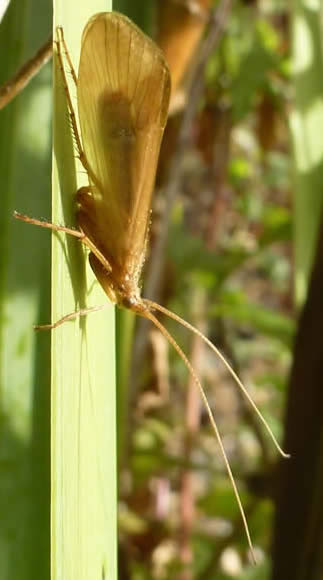
Mists (well, dew) and mellow fruitfulness: dew on a dead dock flower head; guelder rose berries; and a caddis fly (photos 10 Oct).
The caddis is probably Limnephilus flavicornis, a common species found by lakes and ponds throughout Britain. Anglers know the Limnephilus species as 'Cinnamon Sedges'.
September: some of the high summer flowers below are carrying on into early autumn, marsh woundwort and angelica flowers especially. There are still dragonflies, damselflies and a few butterflies on sunny days. Mornings can be wet with dew, of course. Some birds are singing again, notably Cetti's warbler, robin and chiffchaff.
Flowers to look out for in September: marsh woundwort, angelica, orange balsam. Nodding bur marigold - see right.
August: the season of high summer flowers, with pink and purple dominant. Though there are fewer flowers on the grazing marsh, though there are species such as marsh ragwort and square-stalked St Johnswort. Look in ditches for frogbit, orange balsam, fool's watercress and the poisonous lesser water parsnip. Plus butterflies, dragonflies and, with luck, wading birds on passage. It's also the best month to find the scarce red bartsia bee.

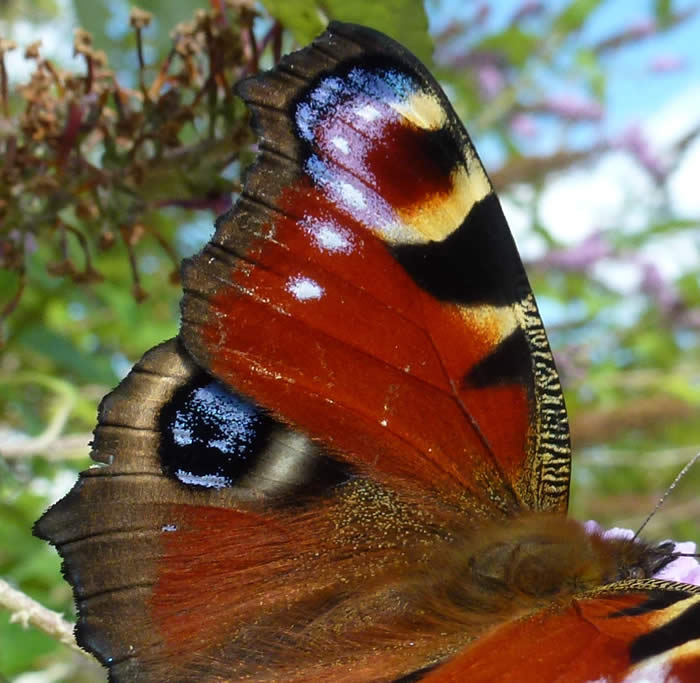
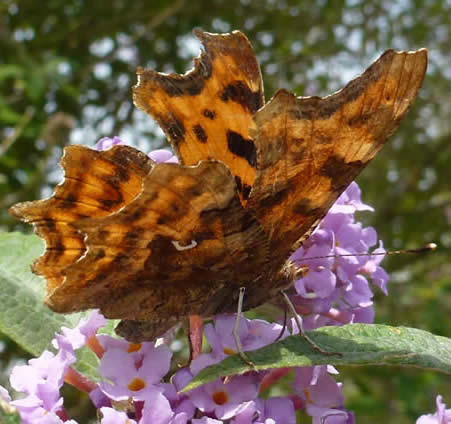
Comma, upper and underside, and a close-up of peacock's wing. 4 August 2013.
Top row: greater willowherb, meadowsweet, purple loosestrife.
Bottom row: marsh woundwort, frogbit in the ditches, rosebay willowherb.
July: bird song is petering out; occasional reed warblers and reed buntings may sing in the first half of July. It's a good month for dragonflies, damselflies and butterflies, when the weather's OK. Water soldiers & frogbit have white flowers in the ditches, and summer flowers like valerian and meadowsweet put on a show.
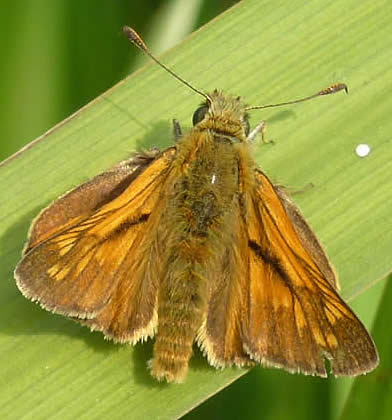
Look out for in July: large skipper butterfly, small tortoiseshell caterpillars on stinging nettles and marsh ragwort.
Flowers showing in early July include meadowsweet, meadow vetchling and valerian.
June: bird song continues, though less so than in May. Usually a good month for dragonflies and damselflies. Not much to see on the Broad: swans with cygnets, great crested grebes, sometimes a common tern fishing. Yellow flag irises are dominant over parts of the grazed marsh.
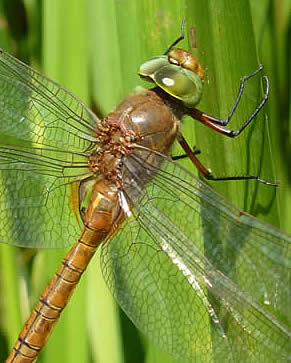
Ragged robin, yellow flag iris and Norfolk hawker, at its most numerous in June.
May: the best month for bird song, with all the warblers in. Cuckoo, marsh harrier, passage birds ... these can all be absent, or nice surprises. Marsh marigolds and lady's smock remain the best flowers in the first half of May; sheets of buttercups and yellow flag irises later. Late this month, a chance of Norfolk hawker. Ducks still appear on the broad, but few and rather sporadically.
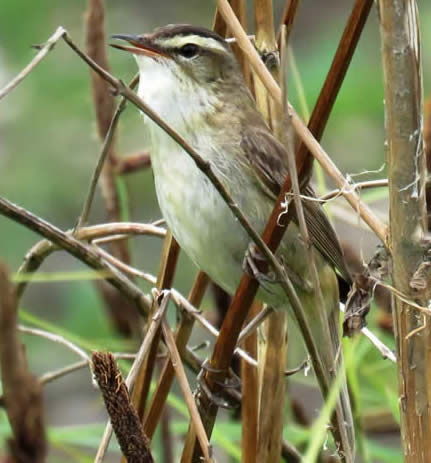
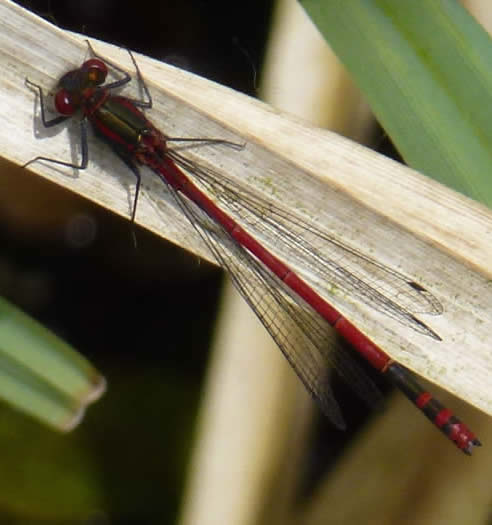
Wildlife in April: lady's smock, sedge warbler (Derek Longe) and Large Red Damselfly.
April: winter wildfowl, tufted ducks especially, are still here in the first half of the month, at least. Chiffchaffs sing and the next migrant warblers to arrive will be willow and sedge warblers. Marsh marigolds and lady's smock are the star flowers later this month. Large Red Damselfly is the first damselfly to emerge, in late April or early May.
March: the first half of the month is still pretty wintry, with wintering ducks still using the Broad. Bird song is increasing, especially on bright days, with the prospect of the chiffchaff in the second half of the month ... and the first spring flowers, namely these below.
Flowers to look for in March: coltsfoot, pussy willow and lesser celandines.
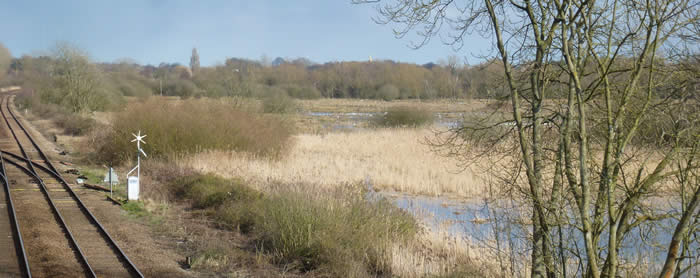
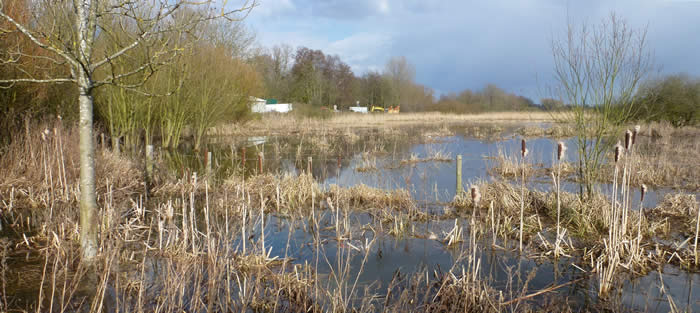
Thorpe Marshes floods, 14 March 2013. Upper: view from the railway bridge. Lower: the marsh by the railway line.
Winter — December to February: the refuge value for birds of the marshes and and especially the broad increases when it's cold. Tufted ducks normally outnumber pochards. Teal and snipe numbers build, but vary, and sometimes a scarcer duck like a goosander or goldeneye appears. Cetti's warblers often sing.
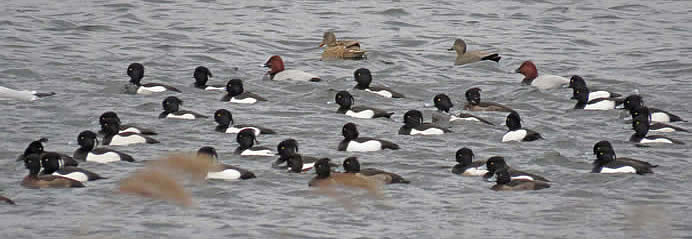
Tufted ducks (mostly), pochards, gadwalls, 24 January 2018 (Derek Longe).
Yellow flag irises, with pink ragged robin for contrast, 31 May.
Left and centre, flowers from April, still out in May: marsh marigold and lady's smock. Right:
early wintercress, also known as intermediate wintercress Barbarea intermedia. Keep an eye out for the first few of some later flowers e.g. water speedwell, water forget-me-not and ragged robin.
Sightings - older ones from 2012 - 2023
2023
19 December, a rather damp guided walk: fungi included at least 20 lumps of yellow brain (=witches' butter), common bonnet, coral spot, the usual jelly ear and King Alfred's cakes. Snipe, heard water rail and Cetti's warbler. A small number of gadwalls, teals, tufted ducks and mallards. Flowers on hogweed and white dead-nettle.
Common bonnet, on a tree near the sign at the entrance; yellow brain on dead ash.
14 December: juvenile hen harrier, seen from riverside path flying over flooded permissive path, disturbed teals, headed east, mobbed by two crows.
12 December, late pm: male goldeneye still there.
10 December: murmuration of c.5,000 starlings at dusk, then flew east (SW).
8 December: Thorpe Marshes: 1 male goldeneye, great white egret flew in from Whitlingham CP direction, little egret on river, 2 little grebes.
5 December: 2 male goldeneyes with tufted ducks and gadwalls on St Andrews Broad. Buzzard.
28 November: water rails calling in three different places, also Cetti's warbler heard; 5 tufted ducks, 8 teals.
23 November: kingfisher, 2 green sandpipers on edge of broad, kestrel.
9 November: 2 green sandpipers flew over then west from St Andrews Broad.
5 November: little egret on flooded path, water rail and Cetti's warbler heard.
3 November: single rook flying over (unusual here, despite being common nearby), buzzard, sparrowhawk, kestrel. No ducks. Cetti's warbler, robin, wren, green woodpecker all heard. Below all by riverside path on morning of cancelled guided walk.
Ruby tiger moth caterpillar; red admiral.
Two views of what seems to be 24-spot ladybird; caddis-fly.
Coral spot fungi on small dead timber.
30 October: 2 x willow emerald damselflies, water rail calling, buzzard over. Not possible to walk round marsh due to high water levels.
22 October: bearded calling from reedbed adjacent to railway line, Called twice, one fleeting view in flight, typical of bearded tit. Skylark over, meadow pipit, single reed bunting (often absent in winter), water rail calling in 3 places, buzzard, kestrel. At last some winter ducks on St Andrews Broad: 46 tufted ducks, 15 gadwalls.
Peacock butterfly, hornet, common carder-bee, migrant hawker, common darter, caddies flies.
Female migrant hawker; jelly ear fungi have sprung into life in the past few days following wet weather.
Caddis-fly on hogweed.
18 October: path through marshes still flooded, though OK with wellies. Several willow emerald damselflies by river, at least four. Migrant hawker, caddis-fly, nursery web spider, harlequin ladybird. Winter plumage great crested grebe, 3 cormorants, 3 mute swans on Broad, no ducks at all. Buzzard.
Two different male willow emerald damselflies, 18 October. Note the colour difference: the left hand image shows an indivual with late-season bronze colouring, the right-hand damselfly is much greener.
17 October: kingfisher over flooded path and heron on it! Migrant hawker, common darter.
Flooded path, 17 October.
3 October: 2 stock doves flying over, plus young bird - see photo. Male stonechat, great spotted woodpecker, water rail called, buzzard, 4 gadwalls.
Very tame young stock dove by a path.
Six British white cattle arrived during September to graze the marshes.
8 September, guided walk: singing Cetti's warbler and chiffchaff. Great spotted woodpecker, plus green woodpecker and nuthatch heard from the other side of the railway line. Migrant hawker, ruddy darter, willow emerald and common blue damselflies ... and lesser emperor, see photo and caption, first record for Thorpe Marshes. Two interesting spiders, see photos below, plus garden spider.
Lesser emperor, Thorpe Marshes, digiscoped: best fit is blue form of female, on which the blue saddle stands out less than on a male (post-event ID from photo.) This is the 23rd species of dragonfly (13 species) or damselfly (10 species) recorded at NWT Thorpe Marshes.
Terrestrial form of amphibious bistort; ivy bee in Whitlingham Lane.

Locust blowfly Stomorhina lunata photographed by Susan Weeks on buddleia.
4-spot orb web spider, Araneus quadratus; marbled orb-weaver spider Araneus marmoreus.
19 August, early evening: red bartsia bee, dozens of small china-mark moths over ditches. Broad: 2 teals, 2 great crested grebes, 2 herons.
Red bartsia bee, 19 August.
8 August, guided walk: 2 kingfishers over river, great spotted woodpecker. Brown hawker, red-eyed damselfly (river), 1 small red-eyed damselfly in Commissioner's Cut, common blue damselfly. Peacock, gatekeeper, green-veined white. Lots of flowers e.g. see photos for August. Red bartsia bee, third year in a row.
Susan Weeks was photographing hoverflies, and says the first two are the more unusual and nice to see: Chrysotoxum verralli, a wasp mimic (photo below); Sericomyia silentis, which favours wetland habitats; Volucella inanis, one of the hornet mimics.
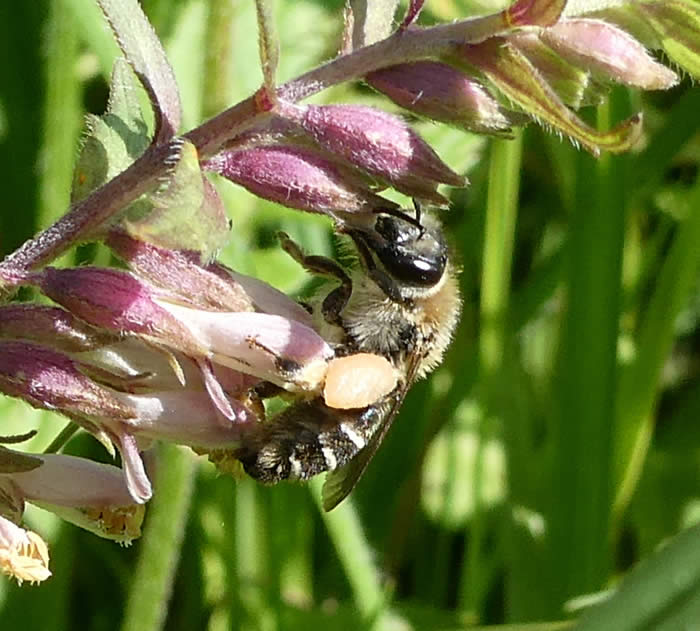
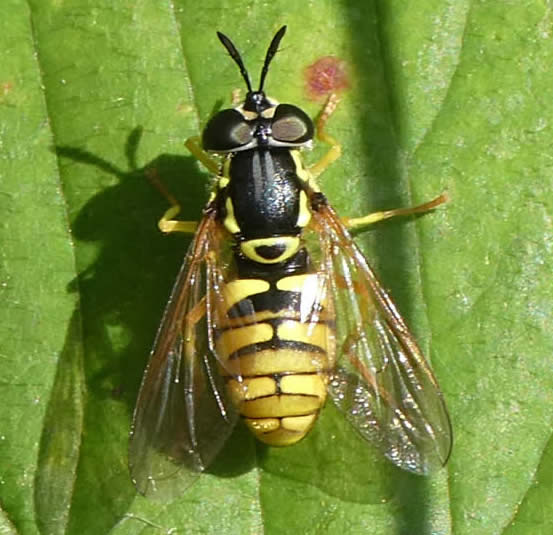
Red bartsia bee; wasp mimic hoverfly Chrysotoxum verralli (Susan Weeks).
29 July: ruddy darter, 4 Norfolk hawkers still on the wing, red-eyed damselfly (river), banded demoiselle. 3 small red-eyed damselflies in Commissioner's Cut (the mooring basin). And this impressively big beetle (also rather clumsy in flight):
Musk beetle Aromia moschata
7 July, guided walk: on Broad, female gadwall with two ducklings, 4 tufted ducks, 8 great crested grebes. Reed bunting, reed warbler, kestrel, common tern.
28 June, afternoon: possible male scarce chaser (probably two) over and perched by one of the ditches dug out last winter, many Norfolk hawkers, black-tailed skimmers on paths, emperor dragonfly. Damselflies: common blue, azure, red-eyed and banded demoiselle on the river. Common tern, 2 great crested grebes, little egret (same place as 2 days ago). Still a little song from whitethroat (Whitlingham Lane) and willow warbler. Ringlet butterfly on riverside path.
26 June, guided walk: singing cuckoo, brief bursts of singing from willow, Cetti's, reed & sedge warbler and chiffchaff, whitethroat seen, little egret, 2 buzzards, kingfisher flying over broad, single great crested grebe, immature cormorant, common tern fishing. Norfolk hawkers. Super mix of wild flowers.
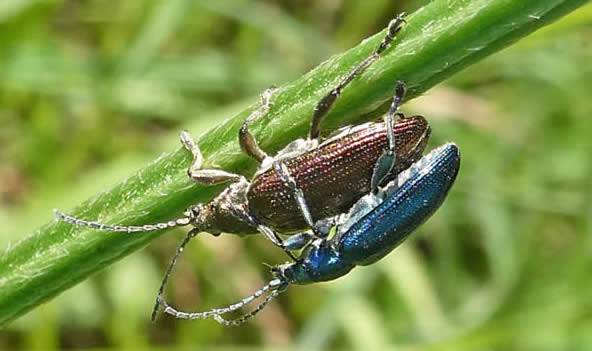
This fascinating photo of two leaf beetles is by Susan Weeks, from Thorpe Marshes on 14 June 2023. Susan writes:
"The different colours led me to an ID of Plateumaris sericea which “shows amazing colour variation” according to beetle guides. It also favours locations near its larval food plant bur-reeds (Sparganium sp.) which seemed right. I put the photo, with my tentative ID, on the Beetles of Britain Facebook page and it was verified by Michael Geiser (Curator of Coleoptera at the Natural History Museum, no less)."
Branched bur-reed grows in ditches at Thorpe Marshes.
12 June: 2 cuckoo, water rail heard, water vole. Broad: 2 adult swans with 3 cygnets.
4 June: male marsh harrier, cuckoo, c.20 sand martins. Lots of dock rust: see photo from May 2022, below.
30 May, evening: barn owl, cuckoo, 60+ swifts over broad (SW).
24 May: 4 stock doves, sparrowhawk, singing reed & willow warblers. Hairy dragonfly, many common blue damselflies; St Mark's flies. Spindle in flower by the cattle corral: several larval tents of spindle ermine moth caterpillars.
10 May, guided walk: 2 cranes flying over, heading west. Buzzard, sparrowhawk, kestrel. Lesser whitethroat singing all morning near railway bridge; also sedge, reed, willow & Cetti's warblers, blackcap, chiffchaff and common whitethroat in field by Whitlingham Lane. Swifts, sand martin, house martin, 2 gadwalls. Many reed buntings on show, no sign of stonechats, Common blue damselflies (tenerals). Butterflies: orange-tip (egg found on garlic mustard), brimstone, small tortoiseshell, red admiral, peacock. Pied shieldbug, whirligig beetles, crab spider Xysticus cristatus (below) and nursery web spiders.
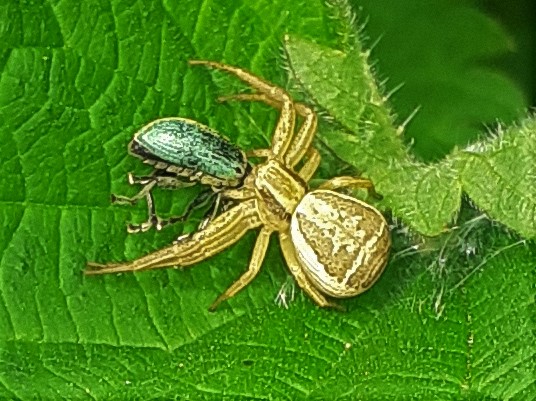

Crab spider Xysticus cristatus. Orange-tip egg on mustard garlic (Ann Greenizan).
Early May, various WhatsApp reports: up to nine species of warbler, cuckoo, barn owl at dusk.
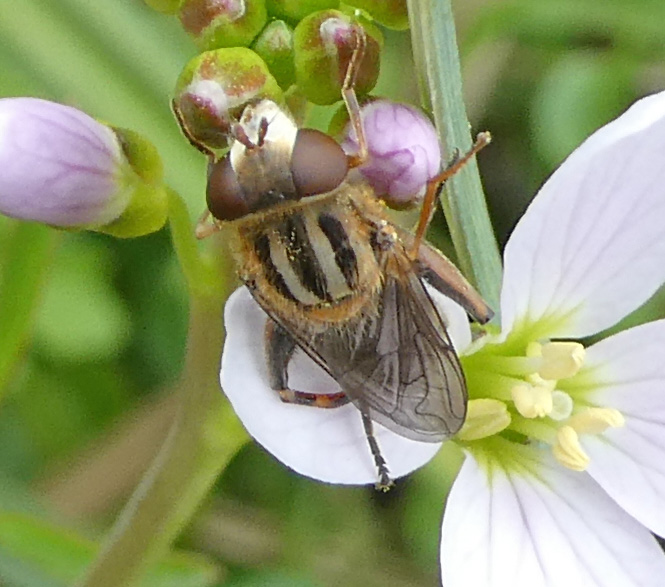

Hoverfly Anasimyia interpuncta photographs and ID by Susan Weeks (also checked by experts) on guided walk, 25 April. It's a wetland species, listed as “Nationally scarce” by Ball & Morris (2014, JNCC Species Status No. 9).
25 April, guided walk: willow warblers (2 singing), grasshopper warbler, many sedge warblers, cuckoo heard. Snatches of reed warbler and whitethroat. Chiffchaff, blackcap and Cetti's warbler make eight warbler species heard today. c 50 house martins, c.50 swallows, 1 sand martin. 3 tufted ducks, 1♂ shoveler. Common tern and 3 unidentified 'commic' terns. Pair of stonechats; 3 buzzards, kestrel, pheasant, reed bunting, 2 collared doves flying over. Hoverfly: see above.
21 April: lots of sedge warblers singing, still wintering tufted ducks, buzzard, marsh marigolds in flower. Grasshopper warbler and cuckoo reported on Norwich WhatsApp group.
6 April: adult kittiwake flying over (also seen at Whitlingham CP). At least 8 male shovelers (18, 11♂+7♀, reported on 5 April). 3 swallows reported.
4 April: peacock butterfly, still 40+ tufted ducks and few gadwalls and teals. Linnets again, in the birches and bramble across the ditch from the riverside path.
31 March, guided walk for the volunteer group: pair of stonechats, chiffchaffs and Cetti's warbler heard, water rail heard, noisy green woodpecker (mostly from across the river), 4 linnets, kingfisher! 3 shovelers (2 ♂, 1♀), gadwalls, teals, tufted ducks, great crested grebe, herons, cormorant. Alder fly, nursery web spider, lady's smock in flower.
A patch of coltsfoot by the riverside path; lady's smock by the river.
30 March, guided walk: pair of stonechats, chiffchaff, reed bunting, Cetti's warbler heard. 1♂ shoveler, 44 tufted ducks, 4 teals, gadwall, mallard, great crested grebe. Sawfly Aglaostigma aucupariaem.
29 March: c.6 sand martins, chiffchaffs singing, water rail calling, Cetti's warbler heard, 2 buzzards. c.6 gadwalls, 1 pochard, c.30 tufted ducks, mallards on territory.
23 March: chiffchaff singing, c.30 tufted ducks. White stork reported over St Andrews Broad on local WhatsApp group (said to be a Dutch-ringed bird). Coltsfoot and lesser celandines in flower.
10 March: single male shoveler and pochard.
Jelly ear fungi looking very smart on the dead elder near the tidal flap.
Flooding by the mooring basin, 10 March.
7 March: pair of stonechats, little egret reported, pheasant, Cetti's warbler. Broad: 4♂ shovelers, 4 coots (a high count, of late), teal still present.
Cherry plum (Prunus cerasifera) flowering in several places.
25 February: siskin singing in Whitlingham Lane. Broad: ♂ goldeneye, c.220 tufted ducks, 2♂ pochards, great grested grebe, little grebe calling. Also calling/singing reed bunting, green woodpecker and Cetti's warbler.
15 February: 3 little grebes on the gravel pit, 2♂ pochards with at least 60 tufted ducks.
10 February, guided walk: buzzard, snipe. 7 shovelers (3 ♂, 4♀), tufted ducks, gadwalls, a few teals.
7 February: 6 pochards (5♂, 1♀) and 4 shovelers (3 ♂, 1♀), c. 110 tufted ducks. A few gadwalls and teals.
5 February: 2 stonechats, broad had 1♂ shoveler, great crested grebe coming into breeding plumage, gadwalls and tufted ducks, the odd teal, heron & cormorant.
3 February: ♀stonechat, 3-4 shovelers (2-3 ♂, 1♀), mistle thrush flying over heading north and over railway line. Handful of gadwalls and tufted ducks; c.15 Canada geese over, flying east.
17 January: count of 143 tufted ducks, mostly males; 30 teals. Both likely to be underestimates especially as teals tuck into the edge of the broad. [Zero pochards or goldeneyes.] Little grebe on broad, ♂ shoveler (♀ hidden, perhaps?) Water rail heard.
14 January: scaup (photo by Stuart White)
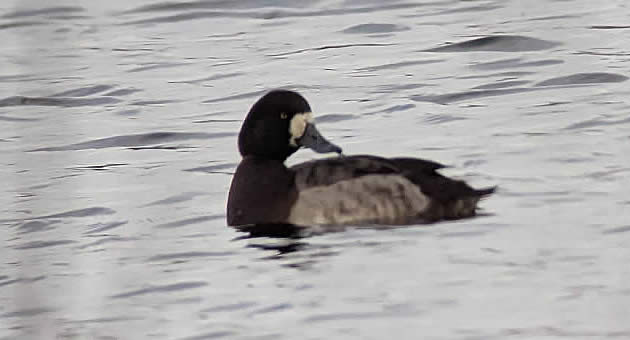
11 January, guided walk: 2 stonechats (♂&♀), male reed bunting, kestrel. Broad: tufted ducks, gadwalls, teals, 2 shovelers, (♂&♀), mallards, cormorants, great crested grebe. 2 little grebes on R Yare tucked into branches on the other side. Muntjac seen well, close to woodland. Cigar galls on reed; sunburst lichen; jelly ear and King Alfred's cake fungi.
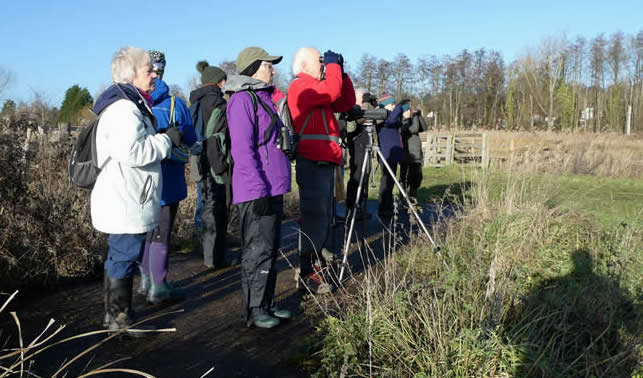
Watching stonechats (Susan Weeks); patterns on a dead ash trunk, digiscoped, likely to be an ash bark beetle Hylesinus sp (there are three species, pinning down which one is tricky).
2022
20 December: stonechat, buzzard, Cetti's warbler. Broad has tufted ducks, gadwalls, teals, 2 shovelers (♂&♀), cormorants, heron, 2 great crested grebes.
2 December, guided walk: 2 stonechats, c.100 pink-footed geese over flying north, snipe, long-tailed tits, heard water rail & Cetti's warbler. Good views of herons. Goldeneyes gone, a few gadwalls and tufted ducks, teal heard.
1 December: 3 goldeneyes still there. 2 stonechats, great spotted woodpecker.
Freshly growing hairy curtain crust, I think, on an ash. Jelly ear and King Alfred's cakes still easy to see, if you know where to look.
29 November: some ducks at last with 3 goldeneyes, 3 tufted ducks, 1 pochard, a few gadwalls. Snipe, siskin & linnet flying over, water rails calling, Cetti's warbler, long-tailed tit.
Ditching work underway, 29 November.
26 November: snipe in 2 places; how many more are hidden on the marsh? Buzzard, Cetti's warbler, late-flowering hogweed. Still a lack of ducks, just the odd gadwall (lots at Whitlingham CP, though).
16 November: water rail in 2 places, Cetti's warbler (both heard), dunnock singing. 2 little grebes, ducks absent today. Male stonechat.
2 November, guided walk: 3 stonechats, kestrel, heard Cetti's warbler, overflying siskin, little grebe, a few gadwalls, kingfisher seen by one group member. Many nursery web spiders sunning themselves on nettle leaves, 2 caddis-flies on a hogweed. Other invertebrates in photos below.
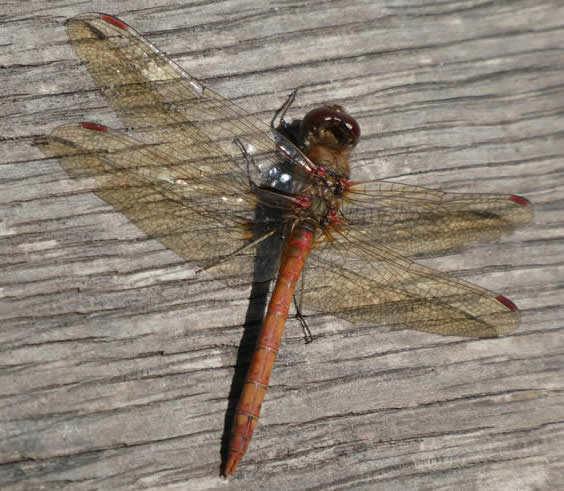
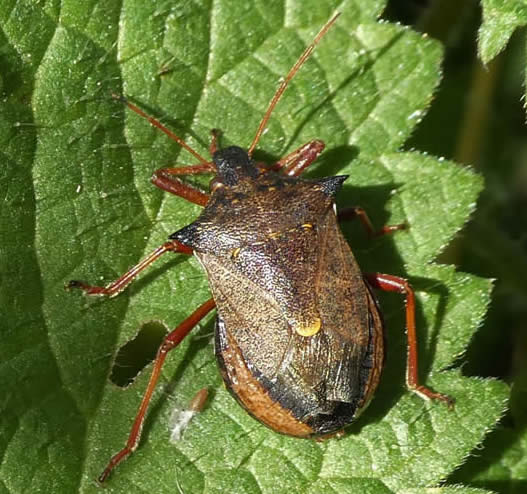
Common darter sunning on a bench, spiked shield bug (Susan Weeks).

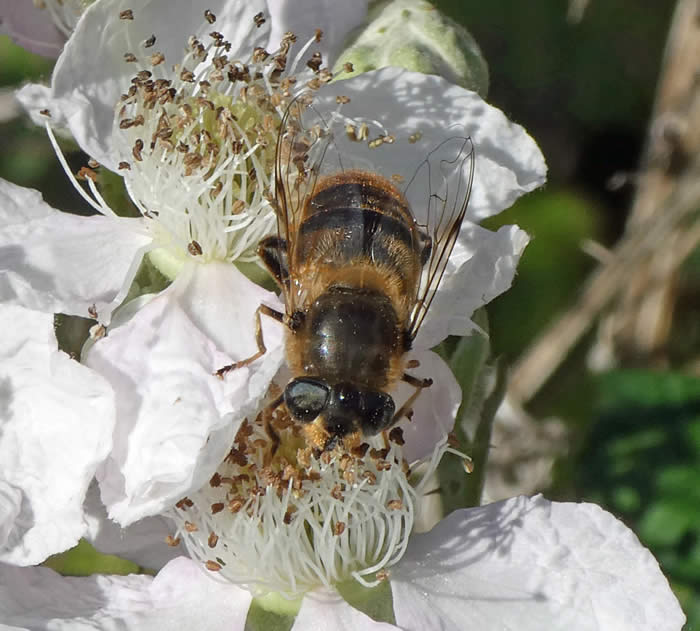
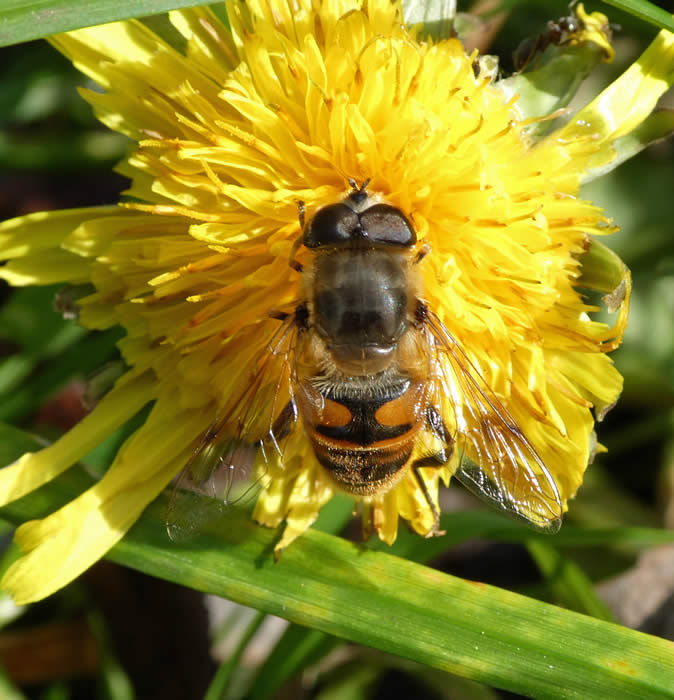
Marmalade hoverfly Episyrphus balteatus, female; hoverfly Eristalis tenax female; hoverfly Eristalis tenax, male (Susan Weeks).
1 November: a quiet morning. Heard Cetti's warbler and water rail, teal on broad.
28 October: 2 male stonechats, heard Cetti's warbler and water rail. Gadwall flock still on broad, also 2 shovelers and teal.
19 October, guided walk: snipe, buzzard mobbed by jackdaws and a crow, kestrel, little egret, extended view of a heron on the main footpath, c.35 gadwalls now on St Andrews Broad, great crested grebe, the usual cormorants. Invertebrates included common carder bees, caddis-flies, nursery web spider and the three species below. Lingering flowers included water mint, hemp agrimony and water chickweed.
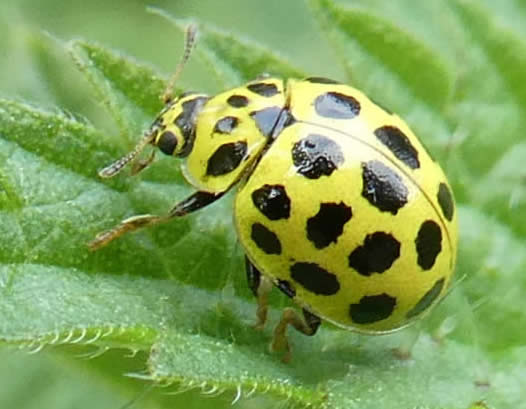
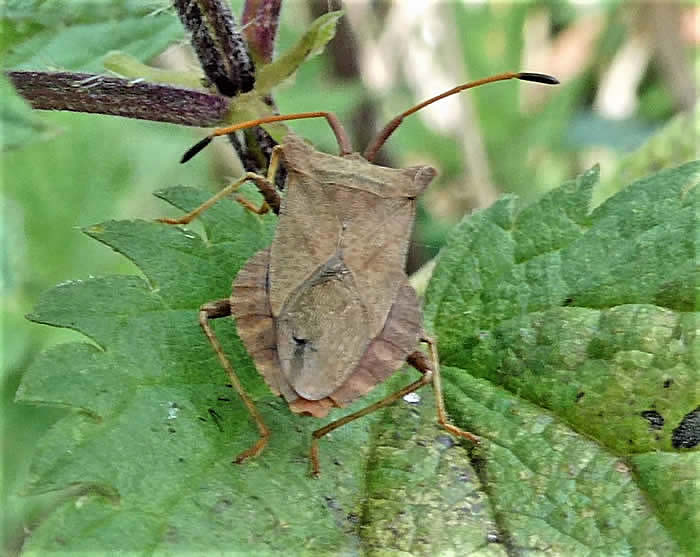

22 spot ladybird Psyllobora vigintiduopunctata; dock bug Coreus marginatus and spiked shieldbug Picromerus bidens (Susan Weeks).
18 October: meadow pipit, stonechat; heard water rail and Cetti's warbler. On broad: 2 little grebes, great crested grebe, cormorants, teals, gadwalls, mallards, coot, moorhen.
NWT's British white cattle; leaves of guelder rose (18 October).
2 October: ivy bee (Whitlingham Lane), migrant hawker, 1♀pochard, water rail and green woodpecker calling.
29 September: water rail calling in two places, Cetti's warbler singing. On the broad: 3 great crested grebes, 1♂ tufted duck, 1♀pochard.
9 September, guided walk: 5 gadwalls, juvenile great crested grebe on the broad. Jelly ear fungus showing again on elder near tidal flap; also sycamore tar spot and King Alfred's cakes. Common blue damselfly, despite some rain. Berries on spindle, guelder rose and woody nightshade.
8 September: 2 buzzards, kingfisher, chiffchaff. Ruddy darter, willow emerald, migrant hawker. Ivy bees on ivy in Whitlingham Lane.
26 August: blackcap eating blackberries, chiffchaffs. Willow emerald damselfly.
Tasteless water-pepper: a big patch on the path by the wood leading to Bungalow Lane.
Some additional records from 18 August, from James Emerson, who took these photos:
Sawfly Tenthredo omissa, on angelica; tortoise shieldbug nymph; water scorpion.
On the water scorpion, James says he was checking a ditch where he noticed in the shallows, scooped it out for a quick look and, "Only then did I realise it had a pondskater in one claw!"
18 August, guided walk for Hickling Broad U3 group: 4 x hanging migrant hawkers from a willow. Black-tailed skimmer, red-eyed damselfly, mating common blue damselflies, banded demoiselle. Red bartsia bees still present; rust fungus on red bartsia is Coleosporium tussilaginis, same as occurs on coltsfoot. Whitethroat, chiffchaff, robin in autumn song, great spotted woodpecker, juvenile stonechat, cormorant, buzzard. Bee wolf - my first for Thorpe Marshes; also recorded in 2021 by James Emerson. Blog here.
Bee wolf on angelica.
Migrant hawker hanging in a willow.
13 August: water rail calling, little egret (broad), hummingbird hawkmoth on buddleia.
5 August: water rail, kingfisher (River Yare), little egret (broad). Red bartsia bee again.
Red bartsia bee again today.
2 August, guided walk: brief view of kingfisher and common sandpiper on river, heron. Dragonflies: emperor, common darter, brown hawker. Damselflies: common blue, red-eyed, banded demoiselle. Hornet hoverflies Volucella zonaria & V. inanis. Flowers: found two more plants of greater water parsnip in flower. Wild carrot and tansy may be new records for the reserve; skullcap by Bungalow Lane; angelica coming into bloom. Red bartsia in profusion: red bartsia bee (more info in blog from 2018) seen with many common carder bees.
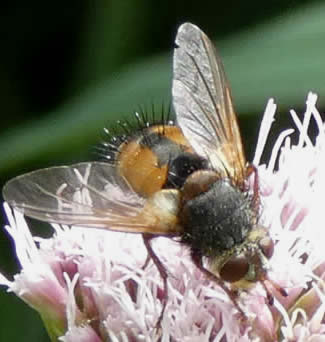
Tachina fera parasitic fly (Susan Weeks); we discussed the bristles on its abdomen (especially) and thorax; square-stemmed St Johnswort (we also saw perforate St Johnswort); dingy footman moth Eilema griseola.
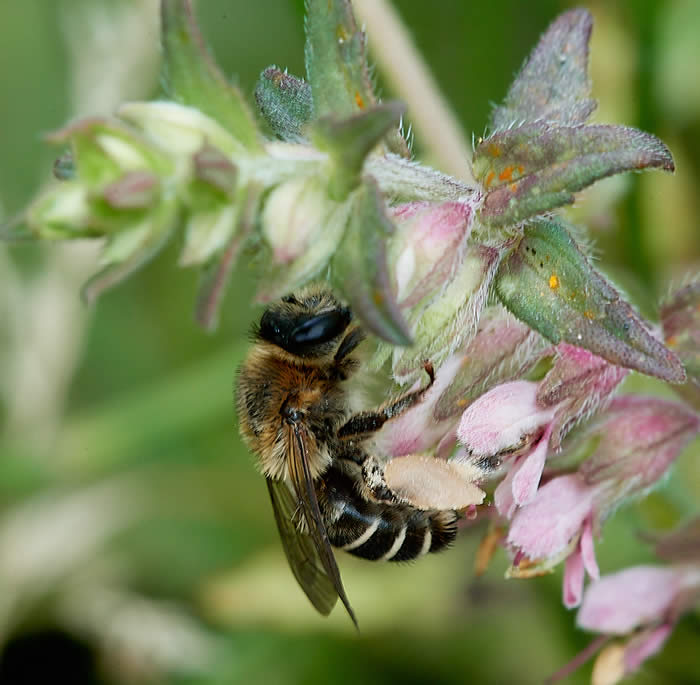

Red bartsia bee Melitta tricincta, courtesy Mike Ball (also on Twitter).
21 July: sand martin, kingfisher on river, two plants of greater water parsnip in flower.
7 July, evening guided walk: at least 2 grasshopper warblers singing.
Red soldier beetles on hogweed, doing what red soldier beetles do.
3 July: still some bird song: sedge & reed warblers, whitethroat, blackcap, chiffchaff, reed bunting. Linnet, buzzard. Four-spotted chaser egg-laying into water. Worth checking buddleia bushes near the bridge for butterflies & bees, comma there this morning.
21 June: 7 lapwings dropped into the flood. Little egret, sparrowhawk, juvenile stonechat. Count of 23 Norfolk hawkers from main circuit. Lots of small tortoishells, red admiral, comma.
10 June: Cuckoo heard 05:00. PM: marsh harrier, stonechat, 16 Norfolk hawkers, azure damselflies. Evening guided walk: sparrowhawk, stonechats, cuckoo, kingfisher. Norfolk hawker; blue-tailed and common blue damselflies. Hairy shieldbug (=sloe shieldbug).
29 May, afternoon: male stonechat, perched buzzard, exceptional view of little egret, thick-thighed flower beetle and soldier beetle below.
Buzzard; Cantharis nigricans, a soldier beetle.
26 May a.m.: cuckoo seen & heard, stonechats, 3rd early marsh orchid. 3 Norfolk hawkers, first of the year.
Two very different fungi today: left, chicken of the woods, Bungalow Lane. right, meadowsweet rust Triphragmium ulmariae.
Evening guided walk: cuckoo, including bubbling female, grasshopper warbler, male marsh harrier, kestrel. Muntjac. Lesser stag beetle (photo, left). |
24 May: 4 stonechats (♂,♀, 2 juveniles), 2 sand martins, male marsh harrier, sparrowhawk. Thick-legged flower beetle reported this morning.
23 May, guided walk: two cuckoos, including female's bubbling call, 2 stonechats, 8 warbler species singing inc. garden warbler. Views of great spotted woodpecker. Orange tip egg on wintercress. Star botanical find: 2 x early marsh orchids by the edge of the path (one had been found by another guided walk over the weekend), in two shades of pink.
Early marsh orchids.
Dock rust Puccinia phragmitis on broad-leaved dock. Life history is curious: first stages on Rumex (dock) species, later stages on Phragmites (reed), hence scientific name.
19 May: c.5 hairy dragonflies, my first red-eyed damselflies and banded demoiselles. Buzzard, 2 stonechats, water rail calling, 2 swallows. Frog swimming in a ditch - quite an unusual sighting here. Brimstone, red admiral, 2 painted ladies. See pictures for more invertebrates.
Spindle ermine moth caterpillars.
Alder fly, with harlequin ladybird; one of today's two painted ladies.
13 May: 2 hairy dragonflies, spindle ermine moth caterpillars. Garden warbler singing. Ragged robin and yellow flag irises coming into flower. Stonechats: 1-2 juveniles, presumably locally fledged, reported since 6 May; today there were three stonechats on show.
6 May, guided walk with Thorpe Marshes volunteer group: water vole, outstanding view of cuckoo, again; only (!) 8 species of warblers; lapwing, 2 stonechats, little egret, marsh harrier. Large red and common blue damselflies. Orange tip butterflies and eggs, brimstones, comma, small white, peacock.
Distant digiscoped cuckoo; drinker moth catepillar.
Red-headed cardinal beetle Pyrochroa serraticornis on cow parsley, long-jawed orbweb spider Tetragnatha sp (extensa? = common stretch spider).
4 May, guided walk: water vole seen! Nine warbler species, today including garden warbler. Cuckoo seen and heard well. Little egret, 1 coot, 3 gadwalls (2♂,1♀), 2 shovelers flying around, 3 stonechats (2♂,1♀). Dozens of grey, teneral common blue damselflies; 2 large red damselflies. Common carder bee, alder fly, pied shield bug, hairy (=sloe) shieldbug. Orange tip butterfly and eggs found on both lady's smock and garlic mustard.
Large red damselfly today, probably recently emerged and with more colour to develop.
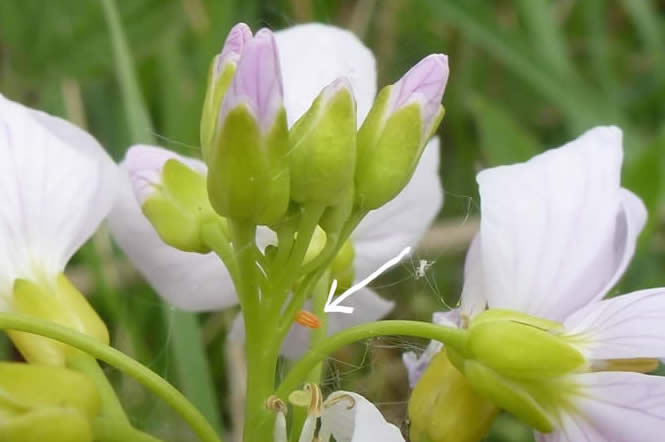
Lady's smock with orange tip egg (arrow); 14 spot ladybird.
Peacock butterfly caterpillars on stinging nettles.
3 May: eight warbler species singing, as for 25 April (+ garden warbler also reported in recent days). Kingfisher, sparrowhawk, swallow. Orange tip butterfly eggs.
25 April: eight warbler species singing: Cetti's, sedge, reed, grasshopper and willow warblers, whitethroat, blackcap, chiffchaff.
23 April: sedge, reed and willow warblers, whitethroat all singing. 6 tufted ducks, 4 great crested grebes.
8 April, guided walk: several buzzards (up to 4), red kite flew west from Whitlingham. 2 stonechats ♀&♂, many reed buntings, oystercatcher flew over. Same ducks + 4 great crested grebes as 8/4. Chinese water deer. Lady's smock in flower near railway bridge. Small tortoiseshell and male orange tip butterflies; pied shieldbug, nursery web spider, common carder bee.

Today's orange tip butterfly (Ann Greenizan).
5 April: little egret, buzzards; shoveler, teal, gadwall, coots, tufted ducks all present; chiffchaff and Cetti's warbler singing. 4 great crested grebes on St Andrews Broad and a 5th on the river.
4 April: sand martin reported by NWT reserves team.
31 March: c.150 redwings flying west (flocks of c.80 and c.70) at 10:30; snipe, oystercatcher, little egret, 2♂ shovelers, teal, gadwall, coots, tufted ducks all present. Chiffchaff and Cetti's warbler singing.
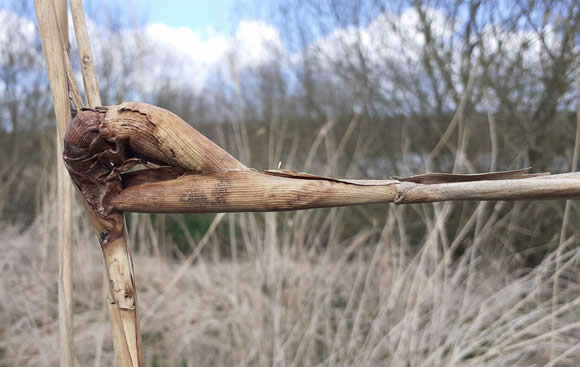
Gall on reed made by the 'corkscrew gall mite' Steneotarsonemus phragmitidis. We also found 10 cigar galls on reeds, then stopped counting.
22 March: ♂ stonechat; buzzard; two great crested grebes on gravel pit.
21 March: shoveler, teal, gadwall, tufted ducks all present p.m. Kingfisher; chiffchaffs singing; meadow pipit. Marsh harrier and stonechats reported a.m. (MB/TB).
7 March: 55 tufted ducks, teal, gadwall, 2 water rails calling. Coltsfoot and lesser celandine beginning to flower, river bank mostly.
26 February: 2 stonechats ♀&♂. 4♂ pochards, ♀goldeneye, little grebe, ♂ shoveler (probably more than 1), gadwalls, tufted ducks.
15 February, rainy guided walk: Chinese water deer, meadow pipit. On St Andrew's Broad: 5 shovelers, 1 ♂ pochard, tufted duck, mallard, gadwall, reduced number of teals on the fringes, cormorants. Black-headed gulls still in high numbers, some gaining dark heads, herring gulls. Fungi: jelly ear on elder and King Alfred's cakes on ash (see photos in December) still easy to see.
12 February: single oystercatcher.
8 February: burst of siskin song from alder, and greenfinch, on marsh side of railway bridge. 2 stonechats ♀&♂, buzzard, 2 snipe. 180 black-headed gulls, 25 herring gulls. Many teal on broad edges, a few tufted ducks and gadwalls.
27 January: c.35 teals (maybe more).
25 January: on the broad, single males of wigeon, pochard and shoveler. 2 coots, mallard, 22 gadwalls, 13 tufted ducks, 14 teals. A few ducks may have been missed, especially teal. Small siskin flock flew through. No stonechat. Muntjac, unusually well away from the wooded edge of the reserve.
12 January, guided walk: great white egret flying west over the railway bridge, c.10:15. Cetti's warblers & 2 water rails heard. Flock of 30 teals plus a few on the broad's edges, 1 male shoveler, tufted ducks and gadwalls. Herons, cormorants. Good views of perched male kestrel and green woodpecker.
11 January: ring-necked parakeet from the reserve, just beyond the railway line. Male reed bunting. A scattering of gadwalls and tufted ducks.
2021
30 December: 2 stonechats, c.20 siskins, 18 teals in flight.
23 December: 50 fieldfares flying west along Yare Valley, c.100 siskins in flock, riverside trees of Whitlingham CP. Influx of ducks: c.250 tufted ducks, 50 gadwalls, 1 teal (at least). Green & great spotted woodpeckers.
17 December, guided walk on a misty morning: flock of goldfinches, flock of c.60 siskins across the river, water rails heard in 3 places, snipe, Cetti's warbler heard, wren singing, bullfinch, heron, cormorants, gadwalls. Surprisingly good day for fungi: jelly ear, King Alfred's cakes, coltsfoot rust (as pictured earlier this month) yellow brain, sycamore tar spot and velvet shank.
Tiny fungi on a stump (ash?), probably velvet shank, early stages of this winter species.
16 December: Chinese water deer. 2 water rails calling, 2 Cetti's warblers singing.
15 December: 2 stonechats. Great crested grebe, 3 tufted ducks.
Coltsfoot rust Coleosporium tussilaginis
14 December: stonechat, reed bunting, green and great spotted wodpeckers. Singing Cetti's warbler and dunnock; water rail called. A few gadwalls.
7 December: 11 tufted ducks, a few gadwalls. Flock of c.60 siskins. Kestrel.
Two fungi, 7 December: jelly ear on elder and King Alfred's cakes on ash.
Flooding, 2 December 2021
29 November: 20 tufted ducks, 13 gadwalls. Water rail and siskin heard.
23 November: two stonechats, male and female. Water rail called; singing Cetti's warbler, robin and wren. 14 gadwalls the only ducks, cormorant. Mixed flock of long-tailed and blue tits. No late dragonfly in the sunshine.
9 November: male stonechat. Willow emerald damselfly, by open ditch opposite eduction area gates. Latest ever record for Thorpe Marshes (previous latest was 6 November 2017). To be expected this warm autumn. Common darters.
Common darter, 9 Nov 2021. Weird background is rubbish from a riverside boat.
3 November, guided walk: several groups of starlings and one redwing flock flying west along the Yare Valley. Cetti's warbler and wren singing. Tufted ducks, gadwalls and mallards on the broad, plus cormorant and heron. Pair of stonechats, great spotted woodpecker. Too misty for insect life. Spindle and guelder rose in fruit, late cow parsley in flower.
2 November: male stonechat, 2 buzzards, 12 tufted ducks. Heard water rail, Cetti's warbler and chiffchaff contact call. Male migrant hawker and several common darters, including two pairs in tandem; several caddis-flies.
30 October: livestock have left, having arrived on 21 September. 2 stonechats, 30 tufted ducks.
19 October: 2 stonechats.
9 October: male stonechat, 3 tufted ducks on the broad. Scores of caddis-flies. Chiffchaff contact call heard again.
5 October, guided walk, dry with occasional sunshine missing early and late rain today: great spotted woodpecker, mistle thrush, Cetti's warbler singing, 3 meadow pipits (first of winter), chiffchaff contact call heard. Lots of caddis-flies when it was sunny. Knot grass moth caterpillar.
Unusual wasp: best fit seems to be tree wasp Dolichovespula sylvestris. Hogweed with caddis-fly, one of the cinnamon sedge types.
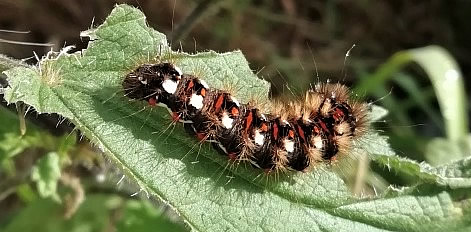
Knot grass moth caterpillar (Neil Rogers). Larval food plants include plantain, dock, knotgrass, bramble, sallows and hawthorn.
1 October: 2 stonechats. Chiffchaff with mixed tit flock.
24 September: water rail walking across the path. Cetti's warbler singing. Willow emeralds, common darters, migrant hawkers.
21 September: NWT cows have arrived.
13 September, guided walk: 2 little egrets, great spotted woodpecker. Painted lady. Migrant hawker, common & ruddy darters, mating pair of willow emeralds. Several ivy bees on ivy in Whitlingham Lane. Lots of flowers, including greater water parsnip in seed, nodding bur marigold and skullcap.
A season of numerous, perfect red admirals: this one (13/9) on ivy in Whitlingham Lane.
4 September: 3 teals (MB).
26 August: count of 13 flowering/seeding plants of greater water parsnip. Migrant hawker, gatekeeper, both a surprise on such a cloudy day.
12 August, NWT guided walk: common lizard on railway bridge step. Common sandpiper, brief view over R Yare. A great show of flowers (like those above). Too overcast for many butterflies or odonata.
9 August: green and great spotted woodpeckers. 5 lapwings, 1 little egret. 12 flowering plants of greater water parsnip, a success from last year's introduction project (see news in right hand column).
5 July: red kite overhead. Stonechats, still some song from sedge, reed and Cetti's warblers and whitethroats. Thick-legged flower beetle. Guided walk for RSPB Norwich Local Group visit.
Red-eyed damselfly on fishing float (Doug Arkell); reed bunting; carrion beetle Oiceoptoma thoracium, all on 5 July.
25 June: male marsh harrier, singing grasshopper warbler, two juvenile stonechats. Meadow-rue and meadowsweet both in flower.
15 June: at least two juvenile stonechats. Norfolk hawkers and black-tailed skimmers in good numbers. Valerian is in flower, as are water soldiers.
6 June: three juvenile stonechats (SW).
4 June: first red-eyed damselflies on vegetation in River Yare. Two pairs of mute swans with cygnets: 2 cygnets on St Andrew's Broad, 3 on the river.
28 May, NWT event: stonechats with two recently fledged young. Now we know why the stonechats have stayed - which is unusual on a marsh. 2 common sandpipers over St Andrew's Broad, 1 lapwing, male marsh harrier. Garden warbler by railway bridge. Large red damselfly.
King Alfred's cakes (fungus) on a dead ash by the river, 24 May
24 May, guided walk: eight warbler species and the ninth (grasshopper warbler) heard by an early arrival. Buzzards, 2 stonechats. Hairy dragonfly, red soldier beetle.
16 May: 2 stonechats still (also yesterday), silent cuckoo, male marsh harrier reported, grasshopper warbler (evening).
6 May, guided walk in the rain: common sandpiper on river, c.50 swallows over St Andrews Broad and perching on dead ashes, swifts, usual warblers including grasshopper warbler.
3 May: red kite over; pair of stonechats, swifts mingling with swallows, grasshopper warblers singing mid-morning.
30 April: sightings of little gull at Whilingham CP and Thorpe Marshes (DL, SW on WhatsApp).
29 April, NWT guided walk: grasshopper warbler singing for the first to arrive; Cetti's, sedge & reed warblers and whitethroats among other warblers. Common terns, 3 hirundine species, kingfisher, still 37 late-staying tufted ducks.
27 April: stonechats still here. Reed warblers singing in two places, ditto grasshopper warbler in the middle of the day. Garden warbler heard (SW).
26 April: male and female stonechat! 7 warbler species: Cetti's warbler in view for a change, whitethroats, sedge warblers, brief burst of grasshopper warbler, willow warbler, chiffchaff, blackcap. 5 common terns, 110 black-headed gulls. 15 swifts, all too briefly - for late April swifts, the Yare Valley is often a good place for sightings. Swallow, house martin. Kingfisher seen mating. Blog here.
Lady's smock with egg of orange tip butterfly - see middle of photo.
25 April: male stonechat; several recent sightings (TB). Big flock (100+) of hirundines, all 3 species, including a lot of house martins.
23 April: 5 grasshopper warblers; hobby (SW). "Little gull drifted across to Whitlingham" (DR on WhatsApp). This is the final little gull sighting in this sequence, so far as I know; that's 25 days at Thorpe Marshes since since first seen on 30 March. How many birds were involved is unknown. Little gulls did not stay overnight at Thorpe: it's likely they left with black-headed gulls and roosted overnight at Breydon Water.
21 April: 3 little gulls, 2 adults, 1 immature. 6 Arctic terns came through but didn't stop (SW).
20 April: 2 adult little gulls reported, now three weeks since the first appeared.
18 April: now 3 little gulls, one adult with a black head and two immatures. Whitethroat, 3 lapwings, oystercatcher.
17 April, dusk: water rail heard, noctules, a single roosting black-headed gull. Little gull reported daily still.
15 April: little gull. 2 cranes over, whitethroat (from info on WhatsApp).
14 April: little gull ...
13 April: little gull still there, now a fortnight since it was first seen. Grasshopper warbler heard this morning (SW).
12 April: little gull, 2 stonechats still here. Sedge warblers singing in two places; willow warblers reported (local WhatsApp group). Swallows, sand & house martins.
10 April: kittiwake, adult! Perhaps the bird that has been at Whitlingham CP. Adult little gull with most of its black head; different bird to the wintry ones seen previously, or a remaining bird coming into spring plumage? Swallows, sand martins, house martin, coming and going; lapwing landed. Lady's smock, marsh marigold in flower.
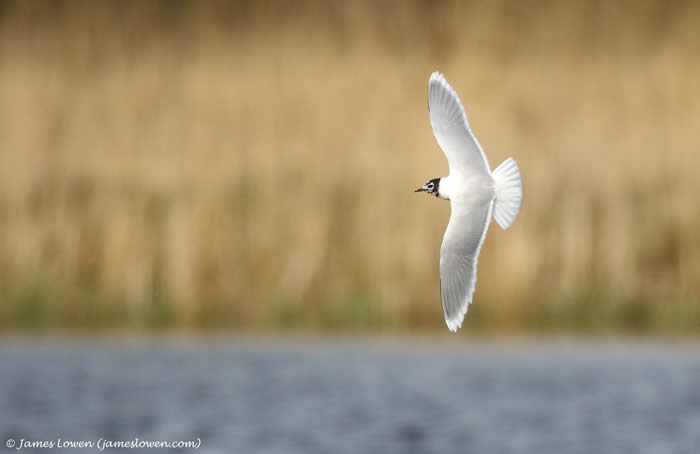
Today's little gull (James Lowen www.jameslowen.com).
9 April: common tern (SW).
7 April: 2 stonechats, little gull (SW).
6 April: 1 little gull, dozens of swallows, viewed from the railway bridge due to flooded paths.
Flooding, 6 April 2021.
5 April: 1 little gull, several swallows and at least one sand martin, two oystercatchers on the 'beach', all viewed from the railway bridge due to paths going under water.
4 April: ♀&♂ stonechats still present, blackcap singing, pair of shovelers and a few teals still around. Evening: crane flew over (SW).
31 March: 3 little gulls. See photo below, cropped from this one on Facebook.
30 March: little gull! Adult moving from winter to spring plumage. Dusky underwings, some dark on hood, a hint of pink on the underside in flight.
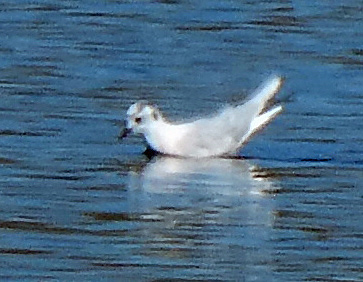
Little gull (Susan Weeks).
About 6 toads in one ditch. Many peacock butterflies, small tortoiseshell, buff-tailed bumblebee, pied shieldbug, Eristalis pertinax hoverfly. 2 stonechats, chiffchaffs, green woodpecker calling, buzzard, 2 lapwings. 2♂ shovelers with tufted ducks, teal, gadwall on broad. Little egret on 'flood'.
Little egret, 30 March 2021.
29 March: stonechat, reed bunting, Cetti's warblers and chiffchaffs singing, pair of linnets, kingfisher on river. Little egret, shoveler, tufted ducks, teal, gadwall on broad. 3 sand martins reported on 27 March. First lady's smock, next to Japanese rose Rosa rugosa by riverside path.
Even the 'muddy corner' is dry now; 29 March 2021.
23 March: 2 oystercatchers, 3 shovelers (1♀,2♂), sparrowhawk. Blackcap song reported (SW). Peregrine over, seen from Thunder Lane.
22 March: chiffchaffs, reed bunting and Cetti's warbler singing; stonechat reported (I missed it). 2 male shovelers.
11 March: 47 tufted ducks, gadwalls, shoveler, teal, mallard, coot, 2 little grebes. Water rail called; chiffchaff contact call. Coltsfoot in flower on riverside path near the houseboat.
9 March, late: 2 barn owls (SW).
4 March: little egret. Tufted ducks, gadwalls, shovelers. Water rail called.
Path improved in previously very muddy SE corner of the circuit around the reserve; still wet though, 4 March 2021.
23 February: 5 shovelers (1♀,4♂), little grebe on St Andrews Broad. Stonechat, 2 reed buntings, Cetti's warbler singing. Barn owl seen early today (TB).
22 February: single crane seen flying west (SW and MB).
17 February: smew has gone (so has the ice). 158 tufted ducks (count by Geoffrey Kelly). 4 shovelers, gadwalls mating, a handful of teals, pochard reported but had gone when I was there. 1 Cetti's warbler singing; 2 reed buntings; single tail-less stonechat; small group of siskins over, by railway bridge. 20 lapwings over, flying SE.
15 February: redhead smew (was previously at Whitlingham); barn owl at dusk (16:55), also reported several times recently (MB); water rail calling.
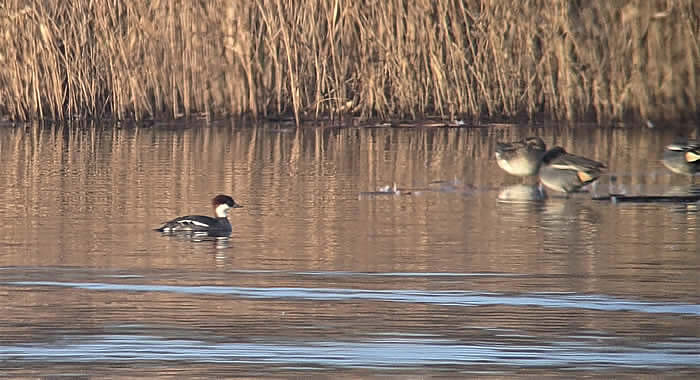
Smew, with teals (Stuart White).
14 February: 22 shovelers (SW)
12 February: no diving ducks with c.98% of the gravel pit's water surface frozen. Group of gadwalls and teals near the viewing point, and ♂ shoveler by opposite shore; 2 stonechats reported.
8 February: great white egret (SW).
Flooded path through the marshes, 1 Feb 2021.
1 February: male siskin in alder by railway bridge. Two shelducks flew over. No egrets.
29 January, morning: great white egret showing well, with little egret. Male goldeneye again.
It won't win any prizes — record shot would be a polite description — but you can just about make out, from left to right, great white egret, little egret and two mute swans.
28 January, late afternoon: great white egret (MB); male goldeneye.
26 January: 3 stonechats (2♀,1♂); first I've seen this year, but then it's largely a matter of chance on timing. Cetti's warbler singing. 3 pochards (1♀,2♂), pair of shovelers, little egret.
25 January: kittiwake reported on Twitter, with photo.
10 November: 6 goldeneyes (2♂) (SW).
17 January: fairly low numbers of waterfowl: 51 tufted ducks, 11 gadwalls, 2♂ pochards, 23 teal (probably more), 2 coots, 2 great crested grebes. 2 herons, 1 little egret.
4 January: tufted ducks, gadwalls, teal & pochards on St Andrews Broad, plus great crested grebe and cormorants. Little to see on the marshes; just mute swans on flooded paths.
2020
Thorpe Marshes under water, Christmas Day 2020.
22 December: flock of pink-footed geese over; green woodpecker; sparrowhawk; ♂ stonechat. 2 water rails heard and Cetti's warblers singing in four places. On broad: 195 tufted ducks (minimum - with diving birds and hidden corners, no doubt more), pochards (12+), teal and gadwall (small numbers), ♂ goldeneye, ♂ shoveler.
18 December, guided walk: kingfisher; ♂ goldeneye; several smart ♂ pochards with the usual tufted ducks and gadwalls; teals.
A few of today's tufted ducks and, top, gadwalls (digiscoped).
13 December: 154 tufted ducks (minimum, as they dive); high numbers are to be expected when Whitlingham CP is busy on a Sunday. 9 pochards, 10 teals, no goldeneyes or shovelers.
11 December: one goldeneye and one male pochard with the tufted ducks.
2 December: down to 2 goldeneyes; probably many of the local wintering ducks (in general) are at Whitlingham today. Flock of c.40 wigeons flying around.
28 November, p.m.: male red-breasted merganser.
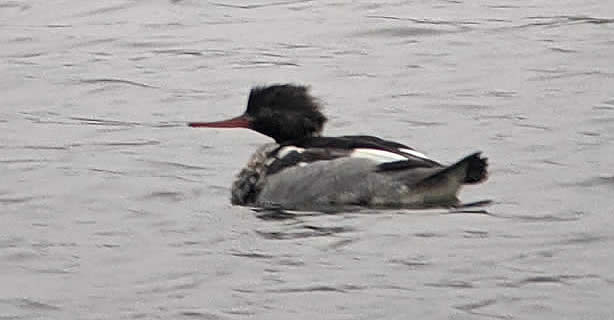
Red-breasted merganser (Stuart White).
24 November, p.m. visit: 5 goldeneyes (2x adult ♂, 2x immature ♂); 3 little grebes; heard water rail. Single ♂ shoveler.
23 November: 5 goldeneyes (3♂), 5 shovelers (2♂), little grebe; tufted ducks, pochards, gadwalls, teals roughly as 21/11. 2 stonechats.
21 November: 95 tufted ducks, 4♂ pochards, 8 goldeneyes, 16 teals, 14 gadwalls, 1♂ shoveler. Chiffchaff, stonechat. Counts by SW.
16 November: an influx of ducks: c.160 tufted ducks, 2♂ pochards, a sprinkling of teals and gadwalls, goldeneye, mallard.
15 November: down to 3 goldeneyes, 2 kingfishers over the gravel pit.
12 November: 8 goldeneyes (SW), which equals the highest count for Thorpe/Whitlingham.
11 November: goldeneyes still present; ♀pochard with the tufted ducks.
10 November: 6 goldeneyes (2♂) (SW).

Goldeneyes (SW).
7 November: 5 goldeneyes (1♂), single teal, 87 tufted ducks (minimum). Reed buntings, 2 stonechats, meadow pipit, Cetti's warblers vocal in the sunshine.
4 November, guided walk: flocks of starlings migrating west along the Yare Valley. Sparrowhawk, buzzard, kestrel. Meadow pipits, Cetti's warbler singing. No sign of the stonechats. 34 tufted ducks - some wintering duck at last! - and a great crested grebe on St Andrews Broad. Late flowers included hogweed, angelica, hemp agrimony, water chickweed and meadowsweet.
A late flowering meadowsweet today.
15 October, guided walk: redwing, stonechat, snipe, meadow pipits, buzzard, kestrel, cormorants. When the sun came out, migrant hawker, common darter and 3 willow emeralds. Dozens of nursery web spiders on nettle leaves by riverside path. Plus these in pictures below and all those pictured for 14 Oct. See blog: Walking again at Thorpe Marshes (Water, Mills and Marshes project).
Spindle fruit, with a drop of rain; dock bug, adult; dock bug, late instar; hairy shieldbug aka sloe shieldbug.
14 October: skylarks over, heading west; an early birder reported redwings and other thrushes first thing. Water rail and Cetti's warbler heard. No sign of stonechats this morning, and still no winter ducks.
Caddis fly on hogweed; jelly ear fungus on elder near 'bridge' over tidal flap; tar spot fungus on sycamore. All 14 October.
7 October: 2 stonechats, chiffchaff, buzzard, kestrel. Lingering flowers include hemp agrimony and meadowsweet. Caddis flies.
1 October: hobby, male marsh harrier.
29 September: 2 stonechats (MB), back for the winter?
21 September: 73 willow emeralds counted (DL).
8 September: as for 4 Sept, plus Chinese water deer.
4 September: willow emerald, migrant hawker, ruddy & common darters.


Ivy bee, hornet hoverfly (both 4 September).
2 September: hobby. Willow emeralds, migrants hawkers, ruddy darter.
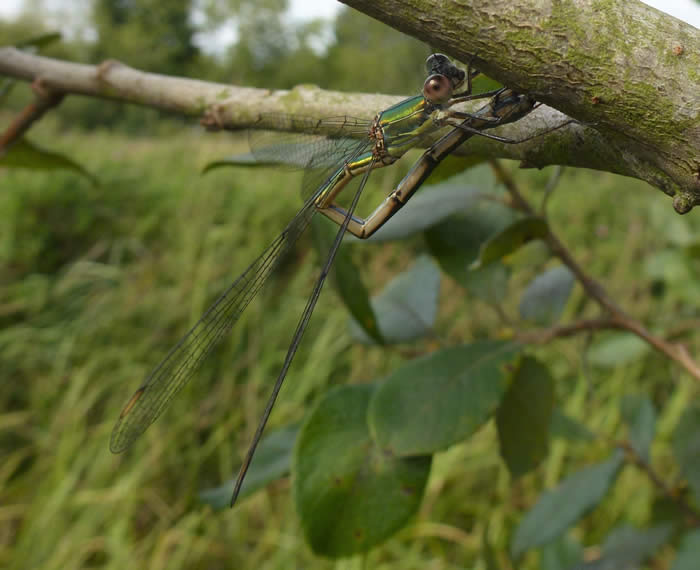
Willow emerald, egg laying into a willow. At least nine this afternoon, all by the permissive path between the education gates and the cattle corral.
19 July: ruddy darter; smartly marked male linnet in song at the big bramble patch.
12 July: grasshopper warbler, 2 oystercatchers (evening).
6 July: water rail chick seen in ditch by the path, also heard.
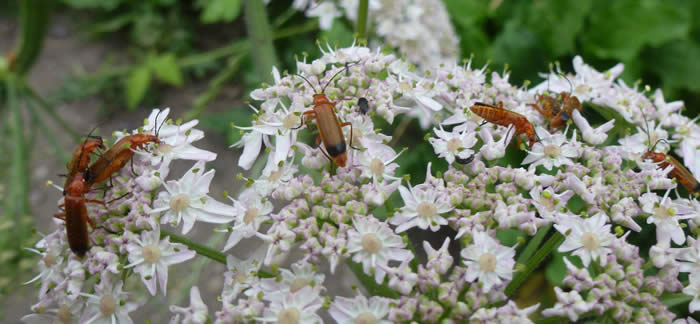
Common red soldier beetles, also known as hogweed bonking beetles, 4 July.
2 July: grasshopper warbler singing. Many black-tailed skimmers: a blue dragonfly landing on a path is likely to be this species.
24 June: 2 grasshopper warblers, evening, one close to the railway bridge.
24 June: emperor dragonflies in 3 places (mentioned as not many so far); first blue-tailed damselfly seen this year.
23 June: greater water parsnip planted in newly cut areas on the edge of ditches (c.28 plants). See photos on Water. Mills & Marshes project on Twitter.
20 June: Savi's warbler reported, thought to be final day. Scarce chaser again, this time within the reserve.
17 June: Savi's warbler seen/heard by many birders today. Male scarce chaser on the edge of the River Yare. Little egret.
Scarce chaser, male in TG2607. Third record this year of species previously unrecorded here. See also gallery of photos of dragonflies and damselflies of NWT Thorpe Marshes on Facebook here, last updated June 2020.
16 June: Savi's warbler still here (according to birders on the reserve).
15 June: scarce chaser (James Lowen via James Emerson).
14 June: variable damselfly (Chris Lansdell, blog). Thought to be last date for corncrake: if you heard it after this date, please contact us.
13 June: Savi's warbler (a.m.), attracting birdwatchers. Cuckoo. Evening/dusk: Savi's warbler singing and showing; 3 grasshopper warblers singing; corncrake heard.
7 June: corncrake & cuckoo calling this morning in the rain (R&JJ).Water rail chick seen (G).
5 June: corncrake calling at 15:00 & 15:30. Water rail and cuckoo heard. Hobby, little egret, male marsh harrier. House martins, a single sand martin, swifts: as usual, aerial feeders present when weather is poorer. Chinese water deer. Emperor dragonfly (first of season): all in a productive walk in a sunny break between rain.
4 June: morning: cuckoo. Lunchtime: lots of house martins in cool conditions over the broad. Evening: corncrake calling between 20:45 & 21:50 (at least), 2 grasshopper warblers reeling.
3 June: hunting hobby, cuckoo calling, grasshopper warbler heard.
1 June: corncrake calling 11.50am up to around 12.20pm (now recorded daily for 14 consecutive days); 71 Norfolk hawkers counted; female or teneral scarce chaser dragonfly (now confirmed, though photos not of publishable quality), new for the nature reserve (DL).
This good-looking fella was by the benches today: thick-legged flower beetle Oedemera nobilis (CD).
30 May: corncrake calling often 16:00 - 16:30. Lapwing reported.
29 May: lapwings absent today. Corncrake still heard daily.
27 May: corncrake calling 15:25 and reports also at other times this afternoon. 2 lapwings - please keep an eye out for any signs of nesting activity e.g. mobbing jackdaws .
26 May: first Norfolk hawkers, hairy dragonfly ovipositing. Large numbers of red-eyed damselflies on branches hanging into the river; azure & common blue damselflies (numerous); banded demoiselles; variable damselfly recorded in much the same place as first record last year. Corncrake called at 15:10; no calling late evening. early part of the night; very vocal again at night (23:52, SW; 05:45 via SW).
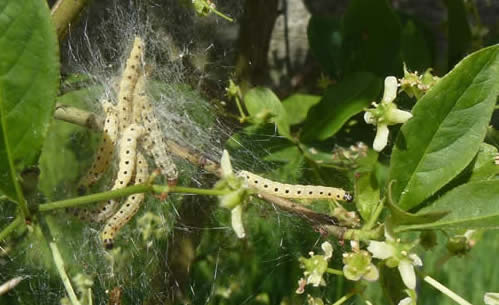
Spindle ermine moth caterpillars Yponomeuta cagnagella.
25 May: corncrake, evening. 24 May: evening and after dark. Now farther east within reserve. Also water rail calling after dark. 23 May: corncrake only heard after dark.
21 May: corncrake heard morning, evening and night. One local resident heard it at 10:00. Up to 12 birdwatchers this evening: I was pleased to see social distancing carried out.
20 May: corncrake heard yesterday evening was again vocal this morning between (at least) 06:00 and 07:30 [recording here]. A bird originally released at Pensthorpe is quite likely its origin, though seeing colour rings is impractical as the bird was (mostly) out of sight. This news is noted here given that (1) news of the bird is on the grapevine (2) the few birdwatchers [4 max] attending were impeccably behaved (e.g. no playback used) (3) the bird is very vocal and conveniently heard from a main path and it is on the other side of ditch.
Cuckoo mobbed by jackdaw. Hairy dragonflies; first four-spotted chasers and banded demoiselles of the season.
Corncrake [coronacrake?] calling in the evening. Birdwatchers are requested to follow social distancing conventions: there were clear failures this evening.
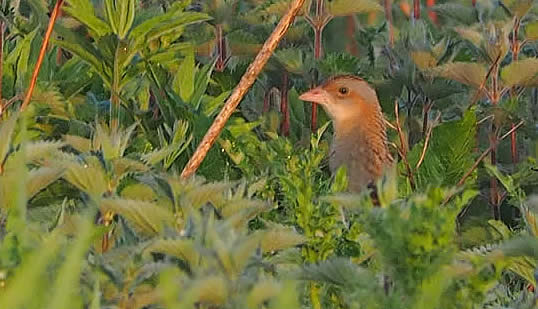
Right place, right time: corncrake at Thorpe Marshes, 20 May (Dave Farrow). See blog: Corncrake at Thorpe Marshes (for Norfolk Wildlife Trust, June 2020)
11 May: in cool, blustery conditions, c.100 martins (c.5 sand martins, the rest house martins) feeding over the broad in the lee of trees at the eastern end.
9 May: lesser whitethroat singing, scrub near bend of riverside path. My tenth warbler of the year. Two grasshopper warblers singing, more reported. Hairy dragonfly, singles in three places. Large red & common blue damselflies. Orange-tip eggs on wintercress.
7 May: hairy dragonfly, a few common blue damselflies. Garden warblers: I've heard one in four different places, though how many there are is less clear.
4 May: nightingale heard from SE corner of reserve (MC via SW; a dog walker).
1 May: 4 swifts with sand & house martin flock; cuckoo calling.
30 April, Whitlingham CP: at least 7 swifts and a hobby with c.100 swallows and martins.
29 April: c.40 hirundines: sand martins, swallows, house martins. These seem to appear when the weather is bad, presumably attracted to feed over the Broad.
27 April: c.30 sand martins, early evening, with them c.3 swallows. Garden warbler singing.
26 April: good view of garden warbler (one of nine warbler species here), oystercatcher, little egret. Pair of great crested grebes. Sparrowhawk in display flight. Cuckoo calling!
25 April: 6 grasshopper warblers (early a.m., SW).
24 April: 5 grasshopper warblers (early a.m.); lesser whitethroat (SW). Cuckoo (AP). Large red damselfly, alder fly, loads of St Mark's flies. At least 46 tufted ducks, numbers having dropped off for a while; ♂ shoveler, ♂ pochard, great crested grebe. Orange-tips mysteriously absent during CD's visit!
22 April: whitethroat; 4 linnets flew through. Pheasant is regular at the moment. Little egret (TN).
20 April: 2 reed warblers singing; snatches (for a 3rd time) of possible garden warbler, but so far not enough song to be sure. 37 tufted ducks.
19 April: reed warbler singing.
17 April: 2 house martins, 4 sand martins, 3 swallows (all minimum figures).
16 April: at least 58 tufted ducks today. Always present at the moment; this is more than usual.
14 April: 2 sand martins over.
13 April, mid-afternoon: c.35 swallows, 1 sand martin, 2 common terns, all of these over the broad. Early morning: ring ouzel (SW - photo on Twitter here).
12 April: gadwalls, tufted ducks, 1 teal (at least) still present. [No date, but about now - common lizard (JD).]
11 April: 2 oystercatchers, 2 lapwings. First lady's smock in flower. Muntjac near viewing point.
9/10 April: 3 singing grasshopper warblers (SW - film on Twitter here). Lots of sedge warblers. Mute swan on nest. Marsh marigold in flower.
8 April: first willow warbler singing, and my first sedge warbler (also reported from two days ago). Possible grasshopper warbler heard (JD) and reported on 6 Apl (SW). Reports of swallows and martins on previous days, but they are not regular. Orange tip butterfly (male), first of the season here (though also in my garden in late March).
5 April: at least 5 Cetti's warblers singing.
3 April: pair of shovelers, kingfisher. White-tailed eagle over, reported (SW)!!!
2 April: water rail called; regular in winter, perhaps staying to breed? Pheasant, kingfisher, later winter ducks still present. Chiffchaffs, of course, but no other spring warblers yet.
26 March: shelduck; still quite a few tufted ducks, teals and gadwalls. Kingfisher on the river. Peacock butterflies, small tortoiseshell. 3 x little gulls reported (SW - @stuart_white73)
24 March: wood mouse, on the riverside path. Presumably these are numerous here but in reality records of small mammals are few and far between, relying on a bit of luck, like today.
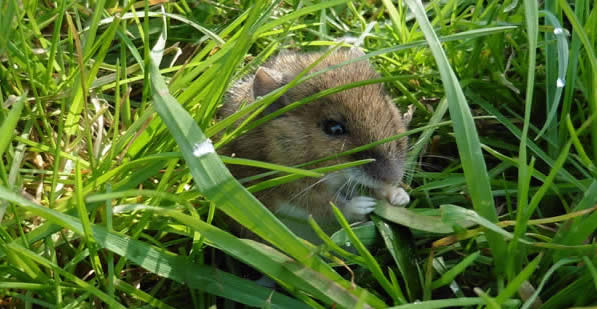
8 March: chiffchaff singing, female stonechat, reed buntings, little egret, 41 tufted ducks, teal, gadwall, great crested grebe in breeding plumage, 2 oystercatchers. Chinese water deer. Lesser celandines and peak time for coltsfoot.
25 February: stonechat and a similar range of other wildlife as on 18 Feb.
18 February, guided walk: excellent view of female stonechat, cormorant in breeding plumage (white thigh patch), little egret seen well, a handful of tufted ducks, teals and gadwall, water rail heard, singing reed bunting and song thrush. Lesser celandine, coltsfoot, cherry plum and deadnettles in flower.
Good views of the female stonechat today, despite windy conditions.
Ivy with clear 'browse line' at Ivy Corner, probably on account of muntjacs.
14 February: 2 pied wagtails flew over, 2 stonechats, pheasant, still low duck numbers. Coltsfoot and cherry plum in flower.
6 February: stonechat, water rail heard, low duck numbers in this mild and sunny weather, bits of bird song e.g. robin, great tit, Cetti's warbler. First Coltsfoot in flower near the river (see 'look out for'). The link is to an old blog dated late March, which shows it's early this year.
29 January: 2 stonechats (♂&♀), sparrowhawk. Wildfowl as follows: 50 tufted ducks, 9 gadwalls, c.8 teal (mostly hidden in vegetation), 3 mallards, 1 great crested grebe, 2 cormorants, 1 moorhen. Fairly typical for a mild spell.
26 January: mild weather continues. Duck numbers still relatively low. Pheasant, ♀ flew in from south of the river.
15 January, guided walk: buzzard, little egret, ♂ stonechat, low numbers of teal, tufted duck and gadwall. Water rail, pheasant & Cetti's warbler heard. 2 song thrushes singing; excellent view of great spotted woodpecker. Jelly ear fungus still easy to see.

Gulls and ducks gathered at the more sheltered western end of St Andrews Broad on 11 January.
9 January: 1♂ wigeon with a few tufted ducks, gadwalls and teal. 2 stonechats (♂&♀), pheasant. Buff-tailed bumblebee on this very mild day.
1 January: c.300 gulls, mostly black-headed, also common, herring, lesser black-back. 2 pochards, several gadwalls; teals gone this morning. Sparrowhawk.
2019
31 December: 1 stonechat, water rail & Cetti's warbler heard, a good sprinkling of teals, tufted ducks and gadwalls.
30 December: 2 stonechats (JE).
20 December: 2 little egrets, stonechat.
17 December, rather wet guided walk: good numbers of teals, other duck numbers still low. Kestrel, 3 snipe, Cetti's warbler, stonechat, mixed tit flock.
13 December during wildfowl count visit: 2 red kites, marsh tit, coal tit, 2 goldcrests and a treecreeper with c35 long-tailed tits in a flock (JL).
11 December: ducks in low numbers: most of the diving ducks absent today. Stonechat, water rail heard.
4 December: 5 little egrets! Stonechat, 3 goldeneyes, vocal teals.
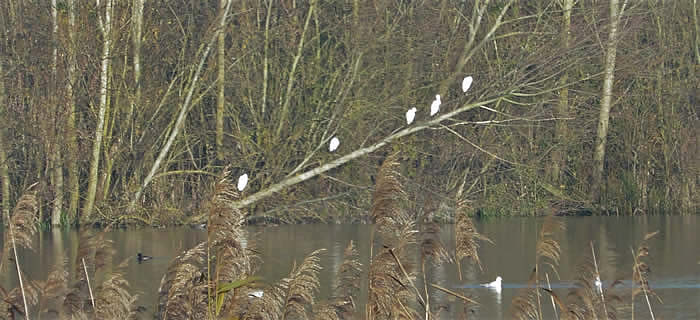
Five little egrets, St Andrews Broad, 4/12. Not the best of photos, but still identifiable.
1 December: water rail vocal near reserve entrance. Stonechat, reed bunting. c.90 tufted ducks, pochards, 5 goldeneyes.
1 December: flooded paths through the marshes, one with a mute swan and heron.
29 November: big flock of pink-footed geese flying over, heading east.
22 November: 187 tufted ducks, 19 pochards, 3 goldeneyes, male stonechat.
16 November: 3 goldeneyes still, stonechat, water rail heard.
15 November: cattle depart.
14 November, very wet guided walk: jelly ear fungus, lots of tufted ducks, 3 goldeneyes still there.
13 November: water rail heard; no sign of stonechat; 3 goldeneyes (2♂, 1♀) [5 goldeneyes recently (MB)].
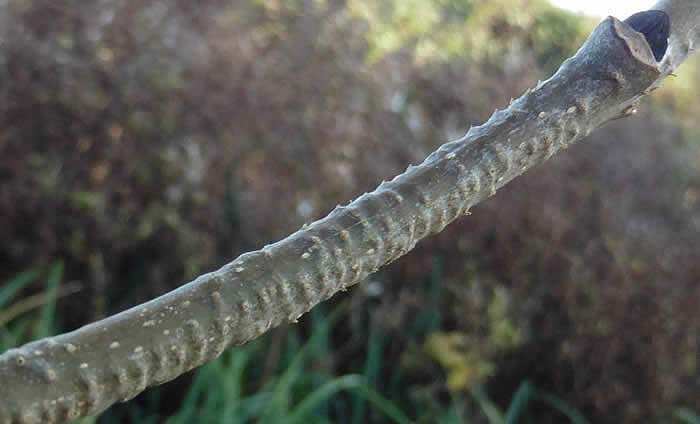
Bare twigs make it easy to look for willow emerald damselfly egg-laying scars: these are on ash.
6 November: stonechat, meadow pipits, water rail heard. Duck numbers still low but a nice variety: gadwall, mallard, teal, tufted duck and 3 goldeneyes.
28 & 29 October: flocks of pink-footed geese flying over. 29 October: 2 goldeneyes in the corner of the Broad.
18 October, guided walk: a small toad (unusual record here). 3 stonechats, rook. Spindle: 3 small bushes with berries discovered. Willow emerald damselfly (photo here on Facebook), migrant hawker (after most people had gone).
Median wasp Dolichovespula media we think; spindle berries.
17 October: willow emerald damselfly, common & ruddy darters. Red admiral. Stonechat, buzzards, meadow pipit, Cetti's warbler singing.
8 October: 3 house martins, 2 stonechats near bramble patch, skylark over; 2 meadow pipits, snipe, Cetti's warbler singing.
30 September: stonechats returned a few days ago (MB).
18 September: cattle arrive.
13 September, guided walk: 4-spot orb web spider (see right), kingfisher, willow emerald damselfly, migrant hawker and common darter dragonflies. Female southern hawker in flight. Ivy bee found in Whitlingham Lane after end of guided walk. Lots of flowers still, such as the September selection above.
Willow emerald, 13 September 2019.
24 August: willow emerald damselfly in three places; migrant hawkers in large numbers, brown hawker, common & ruddy darter. Lots of butterflies, especially painted ladies and red admirals.
6 August, guided walk: sparrowhawk, buzzard, heron, several lapwings, 2 eclipse plumage tufted ducks. Lots of painted ladies, red admirals, peacock, small tortoishell, female common blue butterfly. Common and ruddy darters seen well through the telescope. Small red-eyed damselfly on vegetation in the mooring basin, alongside more numerous red-eyed damseflies. Elephant hawkmoth caterpillar - see below. Square-stalked St John's-wort, haresfoot clover and skullcap among many plants.
Elephant hawkmoth caterpillar walking across the bridge along the marsh track.
1 August: small red-eyed damselfly, still a few Norfolk hawkers, brown hawker egg-laying. Hemp agrimony and other high summer flowers looking very colourful.
29 July: small red-eyed and willow emerald damselflies; common and ruddy darters; last few Norfolk hawkers. Mother-of-pearl moth (DL).
23 July: Norfolk hawkers still on the wing. Marsh vegetation looking lush and colourful.
4 July, guided walk: Norfolk hawkers out late, 3 oystercatchers. Lots of plants including first (of year) marsh woundwort and square-stemmed St John's-wort.
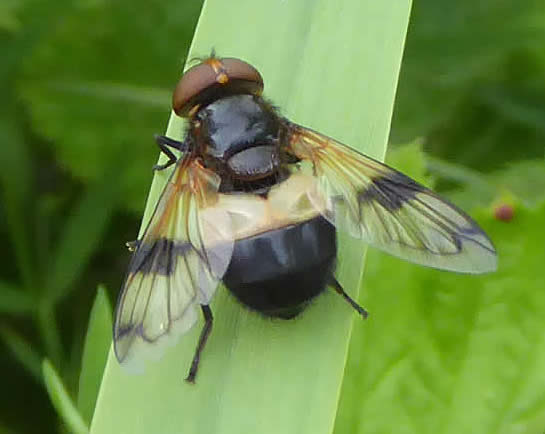 |
Great pied hoverfly Volucella pellucens (Susan Weeks). A good year for them, according to hoverfly enthusiasts. |
Knot Grass Acronicta rumicis moth larva (ID by Derek Longe).
3 July: variable damselfly pair, teneral (just emerged) willow emerald damselfly, marsh harrier (DL).
30 June, Family Fun Day: lots of good views of Norfolk hawkers, four-spotted chasers, reed bunting and more.
29 June: summer flowers coming out e.g. purple loosestrife, meadow-rue, meadowsweet. Birds fairly quiet, a few murmurs from reed warblers and reed buntings. Oystercatcher, lapwing. Butterflies including painted lady, red admiral, small tortoiseshell, small copper. Dragonflies: lots of Norfolk hawkers, four-spotted chaser, emperor, black-tailed skimmer. Second record of variable damselfly for the reserve.
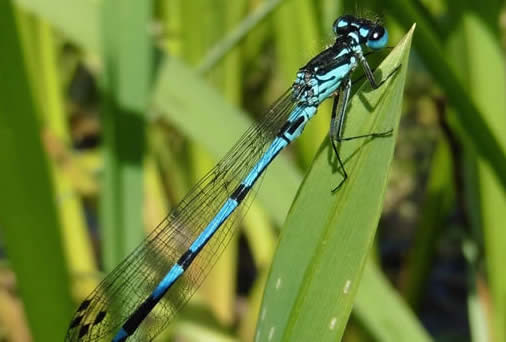
Variable damselfly, 29 June.
14 June: sunshine after the rain: lots of bird song. Linnet at bramble patch. Irises going over, valerian coming into flower.
12 June: nesting lapwings flooded out by recent heavy downpours (MB).
5 June: Norfolk hawkers out in good numbers. Male broad-bodied chaser. Lots of damselflies (as for 24 May). One (and only one) early marsh orchid this year. Counted 15 thick-legged beetles on ox-eye daisies on the track running up to the stile (see photo in 'look out for').
3 June, evening guided walk for South Yare Wildlife Group: a pair of lapwings appears to be nesting. Grasshopper warbler, faintly heard. Reed buntings and reed warblers. Two shelducks flew over. 8 tufted ducks (4 pairs) and gadwall on broad. Mute swans with 6 cygnets.
31 May: garden warbler in tall willow scrub by the riverside path.
24 May: 6 species of odonata: common blue, large red, red-eyed, azure and banded demoiselle damselflies, hairy dragonfly. Clouded border (below) and small china mark moths (DL).
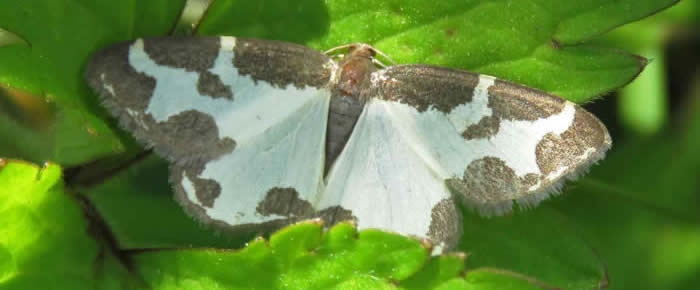
Clouded border moth (Derek Longe).
12 May: nothing new, but it sounded like there's been quite an influx of reed warblers.
8 May, guided walk in the rain: little egret on the 'flood'. At least 100 swallows over the broad, with a few sand martins and house martins. Sedge, reed, willow and Cetti's warblers singing, also whitethroat, chiffchaff and blackcap.
1 May: variable damselfly (male), first record of this species for the reserve (SW). Photos here.
21 April: whitethroat in full song, lots of sedge warblers (c.10), 2 male goldeneyes, 5 ♂ orange tips.
18 April, guided walk: good view of sedge warbler, reed bunting and chiffchaff, willow and grasshopper warblers heard. Butterflies: peacock, orange tip (several males) brimstone, small tortoiseshell, holly blue. Large red damselfly. 4 goldeneyes (2♂+2♀), pair of pochards with tufted ducks, 4 lapwings. Pied shieldbug again, alder flies.
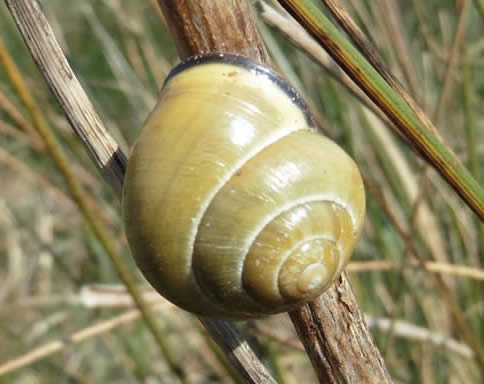
Same species, slightly different look: brown-lipped snails Cepaea nemoralis.
17 April: first orange tip butterfly (male). Several sedge warblers, kingfisher, 2 chinese water deer. 4 goldeneyes (1♂+3♀), 49 tufted ducks, 2 oystercatchers. Grasshopper warbler reported.
15 April: no sign of garganeys. 4 goldeneyes (2♂+2♀), 45 tufted ducks, at least 7 teals. 6 swallows, willow and sedge warbler (heard one of each). Lady's smock coming into flower.
14 April: pair of garganeys, 5 goldeneyes, swallow, little ringed plover and sedge warbler heard. MB/Drew Lyness.
4 April: many ducks have gone, no goldeneyes, though one pochard with remaining tufted ducks, 3+ teal. Lapwing displaying over the water.
29 March, guided walk: 5 buzzards, several singing reed buntings, chiffchaffs in several places. 3 goldeneyes (all females), 2 lapwings. Brimstone, peacock and small tortoiseshell butterflies. Common carder bee.
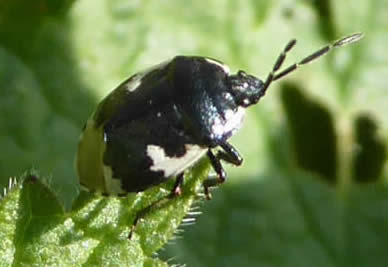
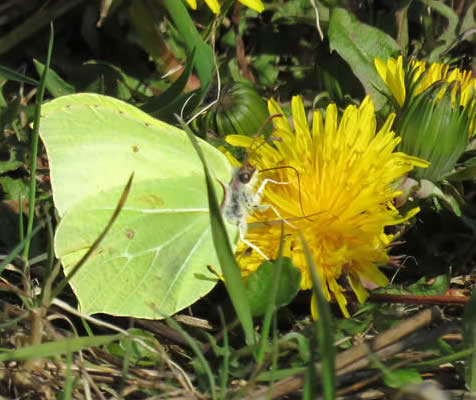
29 March: pied shieldbug Tritomegas bicolor (Susan Weeks); brimstone on dandelion (Derek Longe).
27 March: singing chiffchaffs, song thrush, green woodpecker, linnet (Whitlingham Lane). Buzzard, male shoveler, tufted ducks and gadwalls in fairly good numbers. Marsh marigolds flowering.
22/23 March: little gull (MB)
10 March: 2 little grebes, 2 great crested grebes, 4 goldeneyes (but for how long?), 2 shovelers. No sign of red-crested pochard.
8 March: little grebe, 4 goldeneyes, little egret, 2 shovelers, oystercatcher, kingfisher. Coltsfoot in peak flower on the river bank. Red-crested pochard, male, origin unknown (MB).
2 March: 2 buzzards, 5 goldeneyes, 60 tufted ducks, 2 shovelers, 3 oystercatchers. First marsh marigold in flower and coltsfoot on the river bank.
23 February: 122 tufted ducks, 1 pochard, 2 Canada geese, 3 goldeneyes (2♂+♀), 4 shovelers (2♂,2♀).
22 February: 5 goldeneyes, red kite (MB).
15 February, guided walk: reed buntings singing, buzzard, Chinese water deer. On St Andrews Broad: 2 goldeneyes (♂+♀), 2♂ shovelers, teals, gadwalls, tufted ducks, pochards, mallards, little egret, 2 oystercatchers.
10 February: long-tailed duck, 2♂ goldeneyes, 2 stonechats (MB). 4 little grebes, little egret.
9 February: 4 little egrets (MB).
16 January, guided walk: 7 duck species: imm ♂ goldeneye, tufted ducks. pochards, gadwalls, mallards, teals, 3 ♂ shovelers. Redwings settled in a tree across the river. Hogweed, angelica, shepherd's purse and white dead-nettle in flower.
8 January: little egret on the flood. 3 (possibly 4) goldeneyes.
1 January: 146 tufted ducks (probably more, they kept diving!), 33 pochards, 4 goldeneyes, a scattering of teals and gadwalls.
2018
18 December, guided walk: stonechats, 2 goldeneyes, 2 shovelers. buzzard, sparrowhawk.
13 December: 4 goldeneyes today.
11 December: 2 stonechats, male marsh harrier. Broad: 2 goldeneyes, 1 male shoveler, groups of teal, a few pochards and gadwalls, large numbers of tufted ducks though not counted. Spent time today with two beetle and invertebrate experts, Martin Collier and Steve Lane. See blog: Beetlemania. Finds included pseudoscorpions, mole fleas (the largest species of flea in Great Britain), various ramshorn snails and these:
Paederus riparius a rove beetle in ditch edge vegetation; false ladybird Endomychus coccineus under some bark.
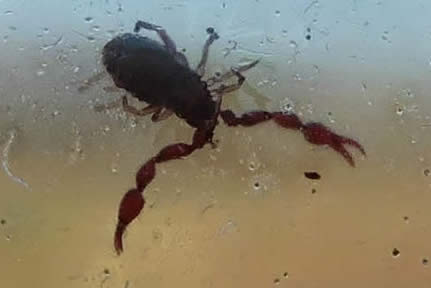
Pseudoscorpion, species unknown (examined in a specimen tube); a tiny harvestman with two white spots Nemostoma bimaculata (on my hand).
3 December: fewer ducks today, just one goldeneye. Little grebe.
30 November: male stonechat. Good morning for winter ducks: 185 tufted ducks, 6 pochards, 4 goldeneyes, 3 teals, 3 gadwalls.
6 November, guided walk: male & female stonechat, several meadow pipits, big flock of goldfinches (c.70). Male shoveler, female tufted duck, 2 gadwalls over but overall a lack of ducks. Two nice bugs - see pictures and captions. Groundsel leaf rust fungus Puccinia lagenophorae found and ID by Roger & Jenny Jones.
Corizus hyoscyami, a scentless plant bug called 'cinnamon bug' or 'black & red squash bug'; hairy shieldbug (aka sloe bug) Dolycoris baccarum. See also blog A Tale of Two Bugs (November 2018);
4 November: low duck numbers, single shoveler, teal, gadwall, 8 tufted ducks. Redpoll. Probable chiffchaff (call and brief & poor view). No sign of the stonechat today.
28 October: 3 goldeneye (2 ♀/imm, 1 imm ♂), 9 shovelers, teals, tufted ducks, gadwall, 7 wigeon flying over. Stonechat ♂ on bramble patch, meadow pipit. Sparrowhawk, kestrel.
27 October: 2 goldeneye, 2 stonechats, little grebe (MB).
19 October: 2 stonechats, good group of meadow pipits. 5 shovelers, teal, tufted ducks, gadwalls, 2 buzzards, snipe. Dark bush cricket and long-winged conehead. Peacock, red admiral. Ivy bee (new record for reserve and the local area) on ivy near railway bridge. Fungi: yellow field cap, brown-edged bonnet. Ruby tiger moth caterpillar and common plume moth. Marsh harrier, curlew and water rail reported.
4 October: still plenty of willow emeralds, common darters and migrant hawkers. Meadow pipit, sparrowhawk; no sign of stonechat. Red admiral, ivy alive with ladybirds, mostly harlequins.
30 September: stonechat reported.
27 September: willow emerald count: 24 seen on reserve, one just off, including several pairs; egg-laying into ash tree seen from railway bridge. Still lots of common darters and migrant hawkers. Snipe, 4♀ shovelers near little group of gadwalls. Hornet, red admiral, peacock, small tortoiseshell. |
26 September: 30 willow emeralds counted by Derek Longe in 4-hour survey, plus 4 just off the reserve.
Unusual perch for a willow emerald, on a wire fence (27 Sept).
13 September, guided walk: Little egret, about 3 snipe, buzzard, sparrowhawk, close views of willow emeralds and mating migrant hawkers (the latter usually dashing past at great speed); very nicely posing long-winged coneheads and dark bush cricket; spider Araneus quadratus. Photos on Facebook here.
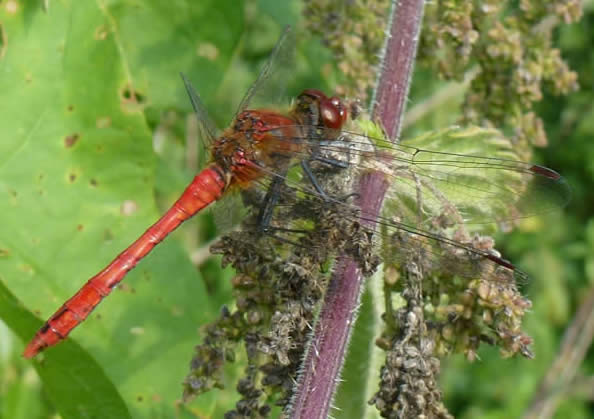
Pictures from 3 September (see them full-size on Facebook here): ruddy darter on nettle, willow emerald damselfly. Little egret still there, 3 tufted ducks.
2 September: little egret. Willow emeralds, common darters, migrant hawkers.
22 August: 10 willow emeralds in 7 places, including three from the railway bridge and one egg-laying pair. 1 red-eyed damselfly on a lily; must be nearly the season's end for these. 2 little egrets, buzzard, green sandpiper with a limp. Couldn't find red bartsia bee again, and the flowers are mostly gone over.
17 August, guided walk: 3 green sandpipers, buzzard, Cetti's warbler heard, quiet for birds. Lots of common darters egg-laying, ruddy darters, migrant hawkers, 2 willow emeralds, red-eyed & common blue damsels. Dark bush cricket. Couldn't find red bartsia bee. Lots of common hemp-nettle by path adjacent to wood that leads to Bungalow Lane.
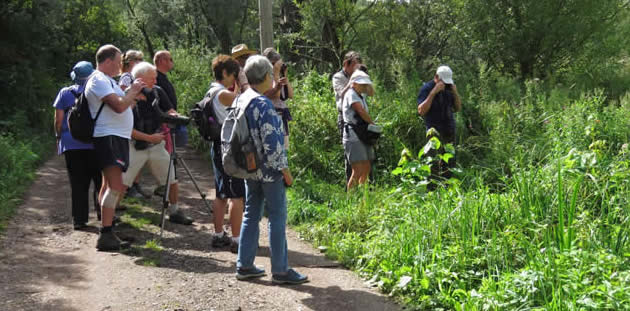
Today's group in Bungalow Lane, watching a willow emerald damselfly..
11 August: lots of summer flowers, not many birds. My first willow emerald damselfly of the year, on ditch parallel with Bungalow Lane. Also red-eyed and common blue damsels. Ruddy darter outnumbering common darter, migrant & brown hawkers. Red bartsia bee: more information on the blog here.
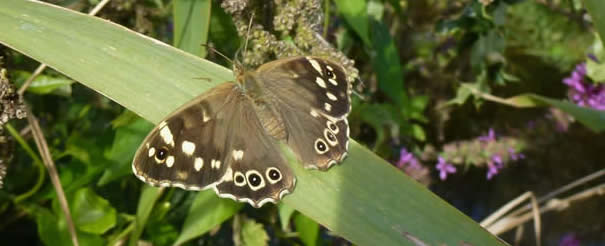
Speckled wood butterfly: usually a species of mixed light and shade in woods or gardens, so a surprise to see perched on a reed today.
29 July, Thorpe Marshes Family Fun Day: 49 attended, which is pretty good on a wet day.
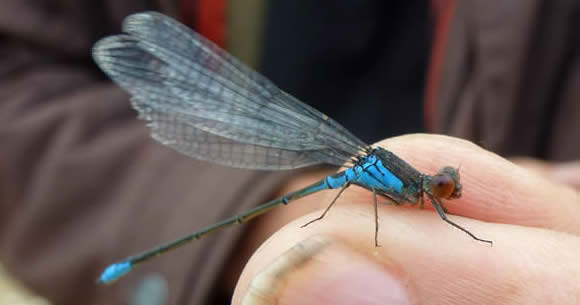
Small red-eyed damselfly found and held by Butterfly Conservation's Andy Brazil, 29 July. Fits into recent pattern of records: singles seen on 4 August in last two years.
23 July: 25 lapwings, 2 oystercatchers. As for 21 July, plus brown hawker, gatekeepers. Peacock and red admiral butterflies on the buddleias by the reserve's entrance.
22 July: reports of a pair of scaup, provenance unknown (no sign 23 July).
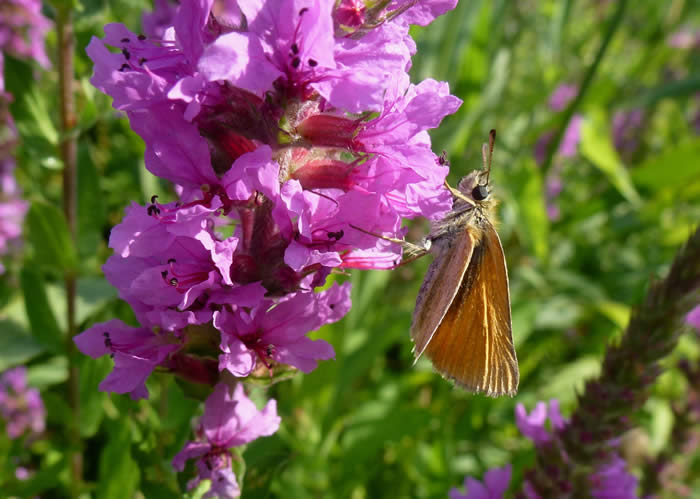
Essex skipper on purple loosestrife, 21 July.
21 July: minimum of 16 lapwings, little egret, grasshopper warbler heard, sparrowhawk. Dragonflies: last few Norfolk hawkers, ruddy & common darter, emperor, black-tailed skimmer. Damselflies: common blue, azure, red-eyed, blue-tailed. Butterflies included painted lady, small & Essex skippers, comma, holly blue. Silver-Y moth.
18 July, evening guided walk: little egret, green sandpiper, grasshopper warbler heard in the distance. Lots of flowers, of course; moths below.

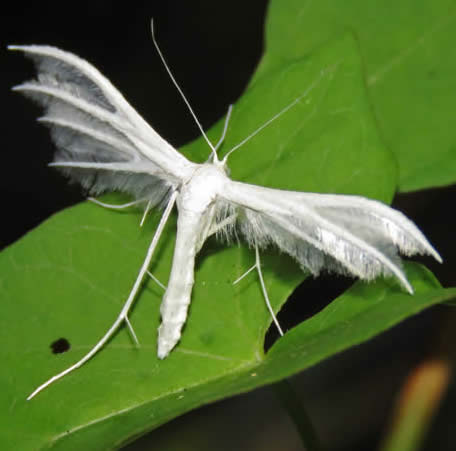
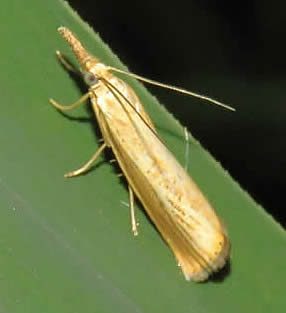
Moths on 18 July 2018: Dingy Footman var stramineola; White Plume Moth; Straw Grass-veneer Agriphila straminella.
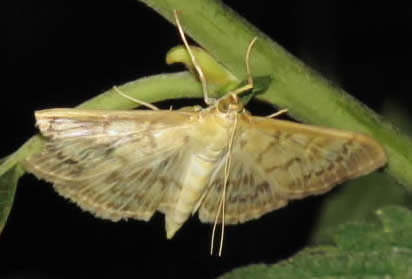
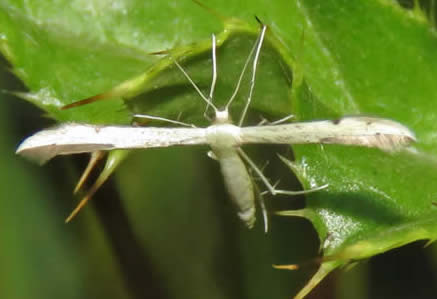
Mother of Pearl; Hemp Agrimony Plume. IDs and photos by Derek Longe.
14 July: butterflies on a hot afternoon included painted lady and ringlet. All (of many) skippers seen well were small skipper. Still a few Norfolk hawkers, plus brown hawker, emperor, black-tailed skimmer, common darter. Group of 10 lapwings on shingle exposed by falling water levels.
5 July, evening: grasshopper, reed and sedge warbler song in bursts. Norfolk hawkers still plentiful but past late June peak. Kingfisher, common tern over river. Swans + 2 cygnets. Lots high summer flowers e.g. meadowsweet, marsh woundwort.
 |
Tufted vetch by the marsh path; cinnabar moth caterpillars on ragwort (5/7).
28 June: 'flood' now dry. Grasshopper warbler singing, common tern. Norfolk hawkers and black-tailed skimmer in good numbers. Butterflies included large skipper, ringlet and meadow brown. Flowers of high summer: meadowsweet, purple loosestrife, marsh woundwort.
20 June: 73 Norfolk hawkers, a record count; large skipper (DL). Also comma, little egret, song thrush in fine voice, grasshopper warbler singing.
18 June, guided walk: hobby, little egret, buzzard, common tern. Good views of heron and reed bunting. Norfolk hawker (+ exuvia) & black-tailed skimmer. Sporadic song of reed, sedge and Cetti's warblers. Swans + 2 cygnets (Polish cygnet has gone). Two tufted ducks loafing (♂+♀); non-breeders or failed breeders? Mullein moth caterpillars on water figwort.
14/15 June: report of grasshopper warbler singing, evenings.
14 June: female gadwall, two male tufted ducks, two lapwings. Anyone seen any signs of any of these species breeding? One or more lapwing has been regular in May and June: non-breeder(s)? Lots of Norfolk hawkers despite windy day, black-tailed skimmer, lots of damselflies (4 species).
9 June: mute swans on the broad have three cygnets, one the white 'Polish' form. Valerian in flower.
6 June: peregrine, count of 5 early marsh orchids (well away from paths and inaccessible without wellies). Dragonflies: broad-bodied chaser inc female egg-laying, emperor, hairy dragonfly, lots of Norfolk hawkers, four-spotted chaser.
29 May, guided walk: 2 herons, 2 kestrels, buzzard, reed & sedge warbler singing, reed buntings. Damsels & dragons as noted for 24 May, with good views of four-spotted chaser especially, and a Norfolk hawker seen. Water vole droppings on a platform; silver-Y moth; orange-tip caterpillar on wintercress. See photos below of a few invertebrates today.
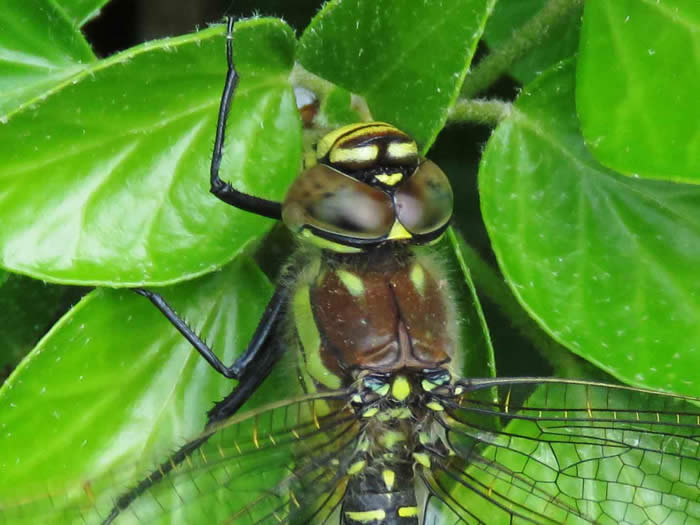
Yellow-tail moth caterpillar on Rosa rugosa (also known as beach rose or Japanese rose); hairy dragonfly close-up (DL).
Norfolk hawker exuvia (shed larval skin), gripping a water soldier. Downlooker snipefly Rhagio scolopaceus: the background colour is a walk participant's jumper. 'Downlooker' refers to how they characteristically look downwards. Non-biting (to humans).
Guelder rose is in flower.
24 May: water vole, common blue butterfly (SW). Damselflies in good numbers: common blue, large red, red-eyed, azure, occasional banded demoiselles. Four-spotted chaser and hairy dragonflies, broad-bodied chaser has been seen.
Red-eyed damselfly, 22 May 2018
7 May: hairy dragonfly, 2 ♂ gadwalls (could ♀♀ be on nests?), oystercatcher, lapwing, common tern.
Female orange-tip nectaring on wintercress, 7 May.
5 May: large red damselfly (DL) while on orange-tip survey.
4 May, evening: cuckoo flying over, also heard from Thunder Lane 5 May 07:00.
27 April, guided walk: grasshopper warbler (perhaps two), mute swan on nest. Pair of gadwalls, two pairs of tufted ducks: could they be staying to nest? Chinese water deer.
|
26 April: lots of bird song including sedge, reed and willow warblers, whitethroat. Oystercatcher, winter ducks gone. Marsh marigolds and lady's smock coming into flower. 21 April: wheatear (James Emerson), photo left. |
7 April: water rail; several peacock butterflies; 118 tufted ducks (perhaps extras from Whitlingham on a warm weekend?); ♂ shoveler still present, but for how long?
4 April: paths flooded in places. Chiffchaff singing; little egret.
29 March, guided walk: chiffchaff singing (but a late year so not the many you'd expect); Cetti's warbler, which had gone quiet; buzzards; fast-flying kingfishers for an alert few.
A few lingering ducks including shovelers, teal and pochard; 2 lapwings. Small tortoiseshell butterflies tempted out by a sunny morning. Coltsfoot, cherry plum (read Wikipedia here about this naturalised shrub) and lesser celandines in flower. Right: small tortoiseshell taking nectar on a willow catkin (DL). |
 |
6 March: female smew on St Andrew's Broad (also here yesterday, from reports, & previously at Whitlingham). 3 wigeons (1♂, 2♀). |
3 March: 2♂ pintails flew round and headed west; ♂ goosander round over the gravel pit and headed west.
2 March: 4 pintails, brown rat (MB). 1 March: 2 redshanks (MB). 28 Feb: 6 wigeons (MB).
27 February: good day for raptors in the snow: marsh harrier, kestrel, buzzard. Good numbers and variety of ducks and gulls on St Andrews Broad, which is about 5% ice.
Snowy conditions today.
19 February, guided walk on a wet morning: stonechat, several singing reed buntings, several snipe. Good selection of wildfowl species: tufted duck, pochard, shoveler, teal, mallard, gadwall, great crested grebe in breeding plumage, coot, moorhen, cormorant. 4 lapwings, 1 oystercatcher.
17 February: chiffchaff, stonechat, ♂ wigeon, 2 little grebes. Recent scrub management work by the ponds.
2 February: 2 wigeons (1♂, 1♀), reed bunting in weak song.
25 January: great black-backed gull, 7 lapwings. kingfisher, stonechat. Duck numbers much reduced from yesterday on a still, sunny and mild day.
24 January, walk with Bure Valley Conservation Group: stonechat, grey wagtail, a few snipe, Cetti's warbler singing. Fungi: oysterling sp on bramble, common jelly spot. Big and jumbled concentrations of ducks mostly sheltering on a windy day at west end of gravel pit: impractical to count while with a group but in the region of 250 tufted ducks, 100 gadwalls, 20 shovelers, 50 pochards, 100 teals. Lapwings, 3 stock doves, c.15 cormorants. 1 of 2 great crested grebes in spring plumage. Unidentified object on the Whitlingham side of the river could be a dead seal.
Tufted ducks (mostly), pochards, gadwalls, 24 January (Derek Longe).
19 January: male stonechat, pochard x ferruginous duck.
17 January: bearded tit seen by one of the guided walk group ( I missed it, again!)
16 January: 18 shovelers, kingfisher.
12 January: noisy great spotted & green woodpeckers on a bright day. 2 x pochard x ferruginous duck hybrids with usual mix of ducks. 2 lapwings.
1 January: great black-backed gull, bearded tit (JL), pochard x ferruginous duck (x 2 reported, JL), 29 shovelers, 4 lapwings, kingfisher.
2017
28 December: little grebe in channel by former shingle spit.

A regular pattern: gulls on 'west bank' and ducks congregate near the former shingle spit.
23 December: little grebe, male stonechat, 6 duck species including 7♂ shovelers.
16 December: male goosander (TB).
13 December: RSPB Strumpshaw Fen volunteers saw bearded tit (there again 22/12, JE), marsh harrier, stonechat, otter signs. NWT guided walk saw 2 buzzards, sparrowhawk & kestrel, so a good day for birds of prey. Good numbers of ducks including teals and shovelers. Mixed siskin & goldfinch flock early on; vocal water rail and Cetti's warbler.
8 December: 16 cormorants, c.50 teal, 6♂ shovelers, stonechat, buzzard.
30 November, with Lowestoft RSPB local group: 2 siskins in alders over railway line, male stonechat, buzzard, 5♂ shovelers.
29 November: male stonechat, goldcrest. At least 50 pochards, many (at least 150) tufted ducks.
24 November: 3 drake goosanders (RC)
17 November: male stonechat. Good day for ducks: 3 wigeon (2♂, 1♀), minimum of 200 tufted ducks, pochard, shoveler, teal, mallard, gadwall. Top count of 14 cormorants (8 on/by gravel pit, 6 overhead).
14 November, guided walk: male stonechat, green sandpiper, several meadow pipits, snipe, sparrowhawk, goldcrest in riverside scrub, water rail. Pochards, tufted ducks, shovelers, gadwalls, great crested grebe, cormorants on gravel pit. Good number of late flowers - details here.
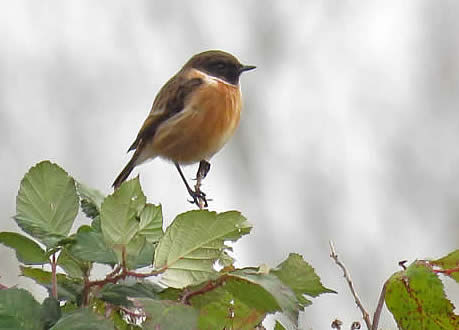
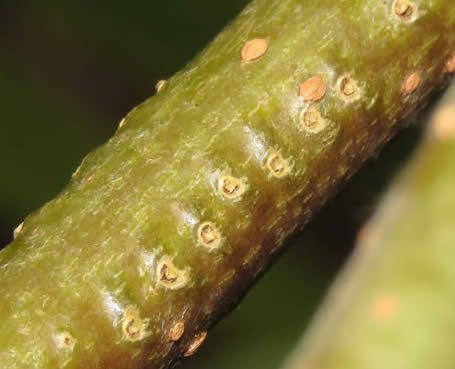
Male stonechat; recent Willow Emerald egg-laying scars (Derek Longe).
10 November: male stonechat, 45 pochards, c.23 shovelers.
6 November: male stonechat, and I hear that the female is being regularly seen but far away near the railway line. Buzzard, pochards, 1 late Migrant Hawker, several Common Darters, red admiral - and my first November Willow Emerald Damselfly.
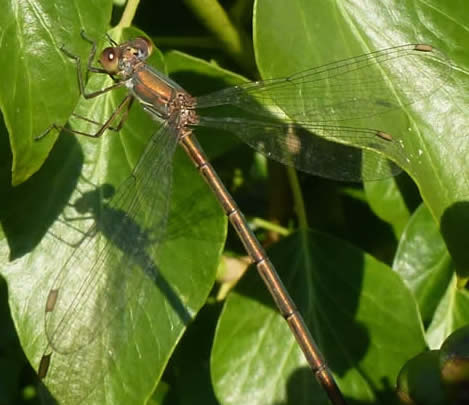
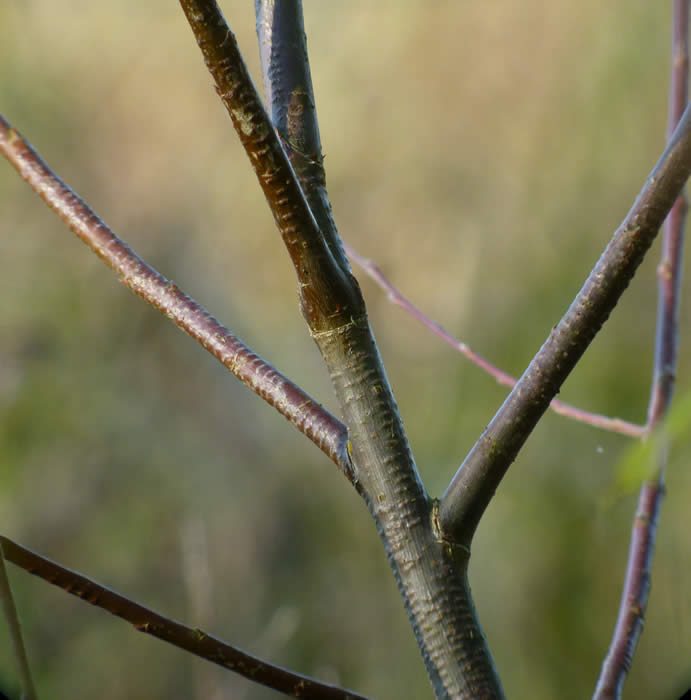
Willow Emerald + shadow on ivy, 6 November 2017; egg laying scars of Willow Emerald, on a willow in the ditch by Bungalow Lane.
3 November: stonechat, shovelers, goldcrest in riverside trees, Common Darters. Searched and failed to find Willow Emerald on a warm afternoon, so looks like their season has finished.
31 October: male stonechat. Good numbers of winter ducks: 2 goldeneye, 19 pochards, 157 tufted ducks, c.70 gadwall, 4 male shovelers, 2-3 wigeon.
Tufted ducks and pochards, 31 October.
27 October: c.70 tufted ducks, 6 shovelers, a few gadwalls, 3 redpolls.
23 October: Willow Emeralds, minimum of 4, on ditch by Bungalow Lane.
22 October: 28 gadwalls, 1 wigeon, c.25 tufted ducks. No sign of the stonechat.
16 October, guided walk, Indian summer weather: stonechat, meadow pipit, redpoll & skylark over. 16 shovelers, gadwalls, tufted ducks. 3 x Willow Emeralds, Common Darters and Migrant Hawkers. Water chickweed and meadowsweet in flower.

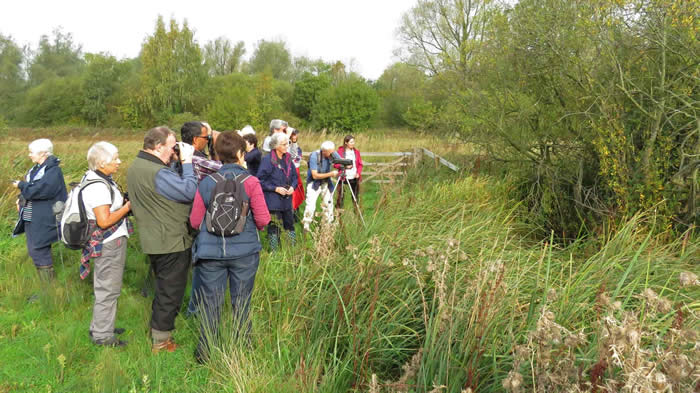
Ruby Tiger Moth caterpillar; the group searches for scars created by egg-laying Willow Emerald damselflies.
15 October: Stonechat - male on the bramble patch. Back for the winter? 60 tufted ducks, 60 lapwings, water rail calling. 1 Willow Emerald - last of the season? Lots of caddis flies on hogweed blooms.
11 October: single Ruddy Darter. Buzzard, bullfinch. 1 wigeon, 14 shovelers, 41 gadwall, 26 tufted ducks.
6 October: in a brief warm spell Willow Emeralds (2), Common Darters and Migrant Hawkers still present. 75 gadwalls a high count for autumn.
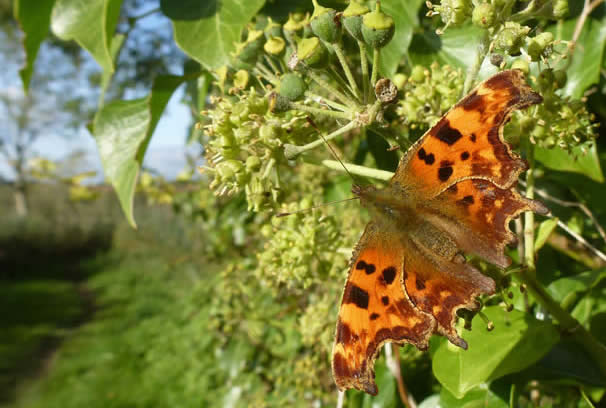
Comma, 'ivy corner', 6 October.
28 September, afternoon: Willow Emeralds (11 counted today), Common Darters and Migrant Hawkers all very obvious in a sunny spell. 19 tufted ducks and 10 coots are good numbers for autumn: they seem to be benefitting from low disturbance levels.
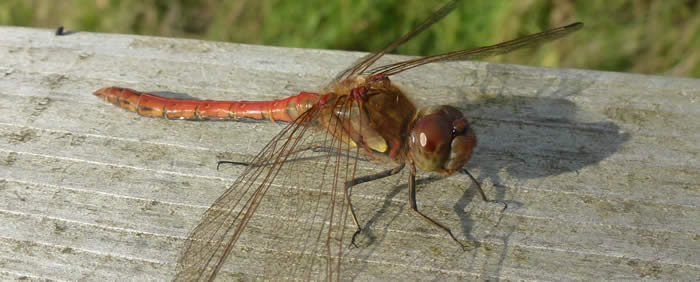
Common Darter, 28 September: they like the warmth of wooden gates and fences.
22 September: minimum of seven Willow Emeralds over ditch by former shingle spit. 88 lapwings.
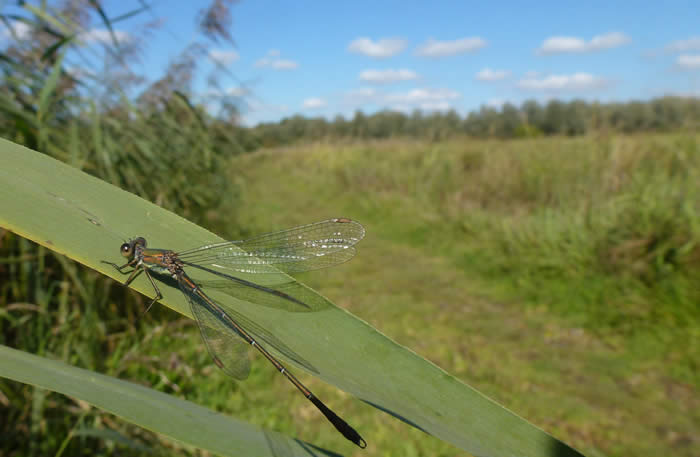
Willow Emerald damselfly, showing why this species is called a 'spreadwing'.
20 September: hobby. Recent report of otter (MB).
16 September, guided walk: peregrine, little egret. On Broad: 58 lapwings, gadwalls, tufted ducks and mallards. 5 white cattle, recently arrived.
1 September: whinchat (MB).
28 August: a water vole scampers across a ditch on a carpet of frogbit. Willow Emeralds from railway bridge.
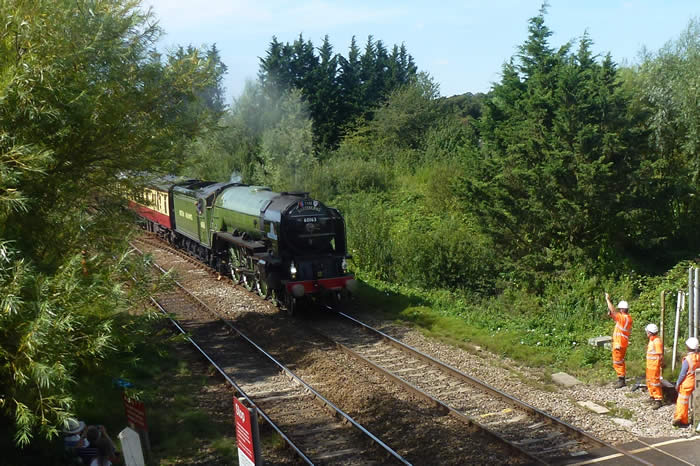
Bank holiday Monday: a crowd gathers on the railway bridge to see the Tornado steam train replica on its way to Great Yarmouth.
25 August: warm day, good for dragonflies: lots of Migrant Hawkers, many Brown Hawkers, Common and Ruddy Darters. 3 Red-eyed Damselflies on lilies in river - they'll soon be gone. Big lapwing flock on shingle.
24 August: 2 teals on 'flood' - sign of autumn.
23 August: Willow Emeralds galore: a count of 27 Willow Emerald Damselflies by Derek Longe. Afternoon is the best time to see them.

Willow Emerald Damselfly on purple loosestrife (DL)
4 August, guided walk: a colourful variety of flowers, including all those pictured above. 37 lapwings and 4 oystercatchers on the gravel bank.
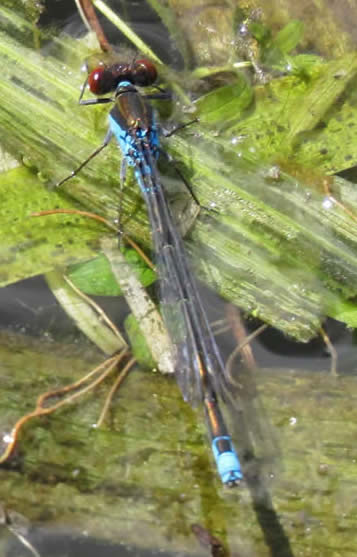
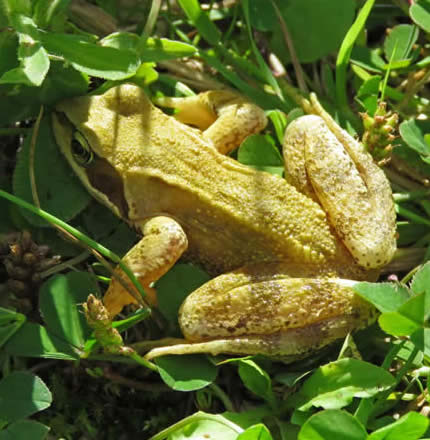
Small Red-eyed Damselfly on floating vegetation at the mooring basin and common frog (Derek Longe) were both notable records. This Ruddy Darter (right) allowed very good telescope views while perched on a plantain, despite the wind.
19 July, guided walk, evening: 2 x Willow Emerald Damselflies, kingfishers, late-flying Norfolk hawkers.
A Willow Emerald Damselfly lands on ... Derek Longe's paper in Atropos about egg-laying choices for Willow Emeralds (DL). See also Derek's NWT blog.
17 July, guided walk for RSPB Norwich local group: common redstart, juvenile, open area by mooring basin. Lapwing flock still present, oystercatcher too. Notable plants: arrowhead and marsh sowthistle. Full report here.
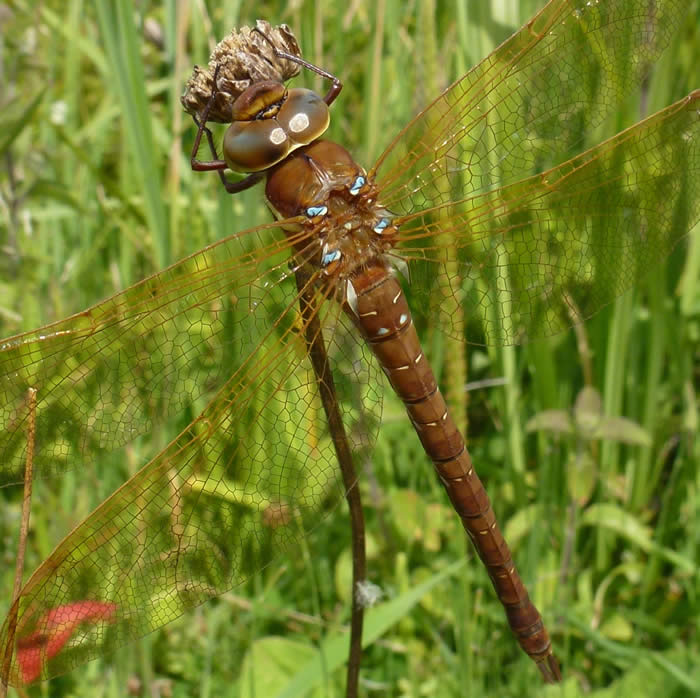
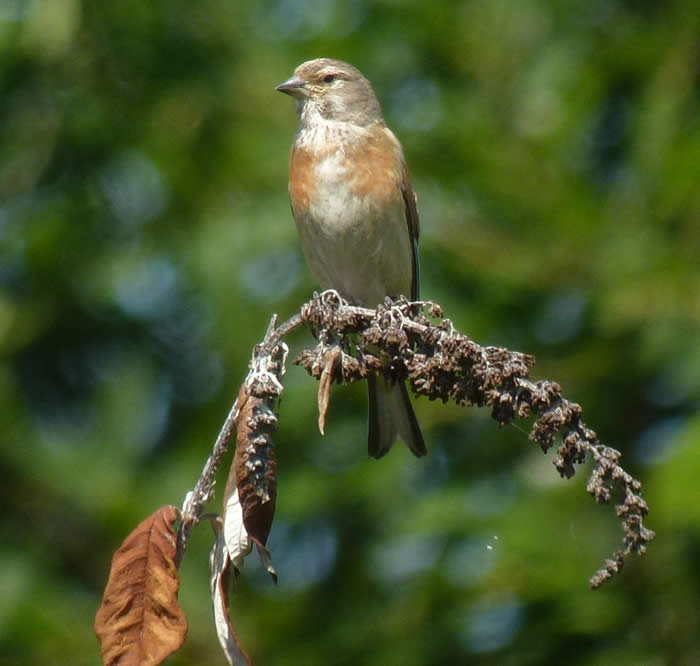
Excellent views of Brown Hawker and linnet on today's walk.
12 July: Ruddy and common darters. Orange balsam in flower, also square-stalked St John's-wort.
Close encounter with a young kingfisher. Not quite as close as this looks - the photo is zoomed and cropped.
7 July: black-tailed godwit (below), from early afternoon until it flew south with lapwings (37 in total) at 18:27. 53 Norfolk hawkers on survey (DL); brown hawkers and ruddy darters (DL). Grasshopper warbler.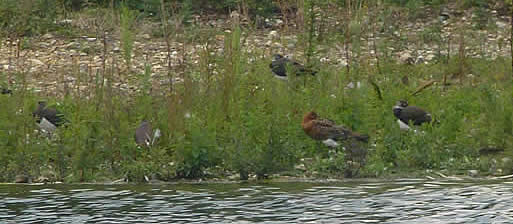
6 July, evening: grasshopper warblers (2) still singing, though muted. Cinnabar moth caterpillar found on marsh ragwort as well as even more on common ragwort.
2 July: 51 Norfolk hawkers on survey transect.
Small skipper; cinnabar moth caterpillars; a tatty looking ringlet, all 2 July.
27 June, another guided walk, in the rain: grasshopper warbler still singing. Ragwort has cinnabar moth caterpillars.
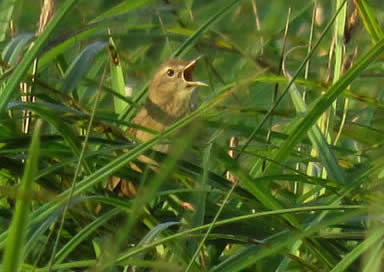 |
22 June, NWT guided walk: good view of grasshopper warbler singing (left, photo by Derek Longe). Norfolk hawkers. 21 June: at least six Four-spotted Chasers. Large skipper. |
15 June: male marsh harrier.
14 June: count of 35 Norfolk Hawkers (SW).
4 June: female Broad-bodied Chaser a highlight in six species of dragonflies: others were Hairy, Norfolk Hawker, Emperor, Four-spotted Chaser and Black-tailed Skimmer. 5 damselfly species including many Red-eyed Damselflies on ditches, not just the river lily pads. 3 lapwings, 2 oystercatchers, 1 common tern. Skullcap in flower.
1 June: Norfolk Hawkers out in force; marsh harrier (DL).
31 May: early marsh orchid; clouds of damselflies; lots of bird song.
26 May, guided walk: little ringed plover, lots of singing warblers, little egret. 6 damselfly species (as 25 May). Hairy dragonfly and four-spotted chaser (below). Common blue butterflies.
25 May: lapwing, 2 oystercatchers. Hairy Hawkers and 6 damselfly species: Common Blue, Azure, Blue-tailed, Large Red, Red-eyed and Banded Agrion. Yellow flag irises looking superb.
13 May: hobby (DL). Also recent reports of sanderling and whinchat.
10 May: sunshine at last. First Common Blue Damselfly, common sandpiper, buzzard.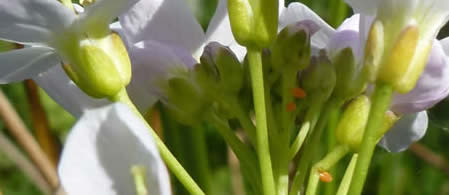
Orange-tip butterfly eggs on lady's smock.
9 May, evening: grasshopper and willow warblers. Great crested grebe chick or chicks hatched and on parent's back.
28 April, guided walk: water vole, 2 swifts, house martins and swallows.
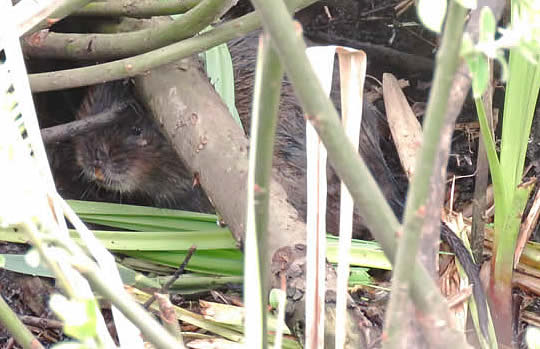 |
Seven warblers: grasshopper warbler heard distantly; sedge, Cetti's & reed warblers, whitethroat seen well, chiffchaff & blackcap. Orange-tip egg on a lady's smock. Water vole (Derek Longe). |
16 April: little egret, 3 buzzards, sparrowhawk, grasshopper warbler.
11 April: common scoter and jack snipe photographed (RC).
8 April: sedge warblers (2) singing, redshank, male marsh harrier (flushed snipe), buzzard over, little egret. Great crested grebe still on nest; brood of (semi-domestic?) mallards. Several small tortoiseshells. Blackcap, chiffchaffs, linnets, reed buntings, Cetti's warbler. Shovelers gone, tufted duck numbers declining, pair of teal still, gadwall present.
3 April: marsh marigolds in flower. 92 tufted ducks, but gadwall down to one, pair of shovelers still present, 3 little grebes. 6 lapwings, 2 oystercatchers.
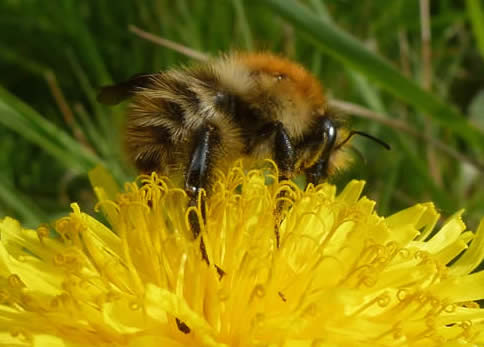
Sunshine brings out bees and butterflies. Common carder bee on dandelion; peacock butterfly.
29 March, guided walk: chiffchaffs, Cetti's warblers, great crested grebe on nest, little egret, 2 male shovelers, first lady's smock in flower, buzzards.
26 March: chiffchaffs singing, green woodpecker, grey wagtail.
8 March: lesser celandines flowering.
7 March: stonechat and little egret still there; oystercatchers displaying, male shoveler. Coltfoot coming into flower - see old Coltsfoot at Thorpe Marshes blog here.
21 February: 3 little grebes, little egret, oystercatcher (2 yesterday).
17 February, guided walk: little egret, 2 stonechats, 1 male shoveler, water rail heard, 2 reed buntings singing, 150 lapwings over.
10 February: black-necked grebe, present since about 1 February.

Black-necked grebe with tufted ducks, 10 Feb (Derek Longe).
24 January: 95% ice cover on the Broad, with ducks (including male pochard) concentrated in the 5%.
19 January: 90% ice cover on the Broad. A few ducks on the far side (from the viewing area) only.

Canada geese, seen on the guided walk on 16 January (Derek Longe).
 |
16 January, guided walk: Left: Chinese water deer on the broad's edge, from the viewing area (Derek Longe). |
Reserve under water, 14 January. Left, from the footbridge. Right: from just over the footbridge, looking along the path towards the mooring basin.
5 January: 2 stonechats. Routine numbers of gadwall/teal/tufted ducks on the Broad. Water rail seen rather than heard, for a change.
2016
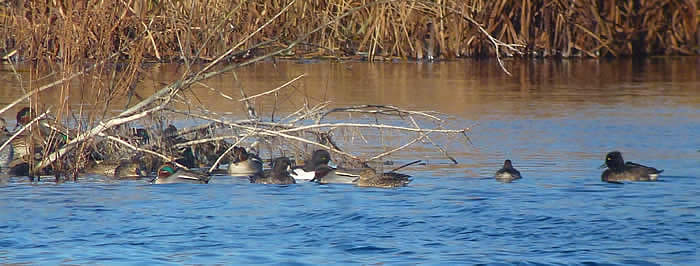
Teals and tufted ducks on the broad, 26 December.
31 December: chiffchaff!
25 December: 4 male shovelers & 52 gadwalls on the Broad; 2 stonechats.
20 December: 2 stonechats, 2 male wigeons on the Broad.
16 December: 2 stonechats, 3 pochard, 1 wigeon, c.345 black-headed gulls. Fungi on edge of wood including velvet shank and jelly ear.
14 December, guided walk: 2 stonechats, water rail, great spotted woodpecker, lots of tufted ducks & gadwalls, 2 shovelers, 2 lapwings.
12 December: 2 stonechats, 190 tufted ducks, 3 lapwings.
7 December: 1 stonechat, 92 tufted ducks, lower numbers of gadwall, mallard and teal.
2 December: female marsh harrier; 2 stonechats, 2 male shovelers on the Broad. Duck numbers seem to be building. 2-3 Chinese water deer.
29 November: 2 stonechats still there this frosty morning, today near the big bramble patch. Wildfowl etc as yesterday.
28 November: 2 stonechats are back, on marsh around flood. Seems to be lots of wrens this bright, frosty morning, and Cetti's warblers singing. Ducks as for 26th Nov; snipe, lapwing.
26 November: a handful of gadwalls, tufted duck and teals.
22 November: peregrine! Most of the duck have gone.
18 November: big arrival of ducks, 220 tufted ducks, 41 gadwalls, 6 teal, 2 pochard, 2 shovelers. Found Willow Emerald egg-laying scars on ash.
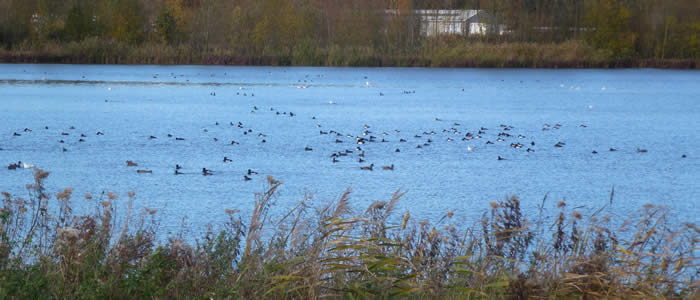
Ducks on St Andrews Broad, the gravel pit, 18 November 2016.
11 November, guided walk: 8 snipe flying, another 7 settled; lapwing, 10 gadwalls, sparrowhawk. Dark bush cricket, Small Stag's Horn fungi, drinker moth caterpillar, various late flowers.

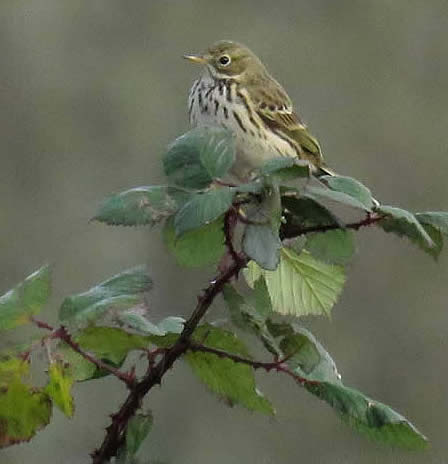
Small Stag's Horn (Calocera cornea); meadow pipit (Derek Longe); dark bush cricket. More photos on Facebook here.
9 November: 4 teal. (No velvet scoter, reported yesterday at Whitlingham.)
30 October: female marsh harrier; 6 snipe; water rails calling in 3 places. [Recent reports again of stonechats and yellow-browed warbler.]
24 October, guided walk: snipe, lapwing, c.8 redwings over, 4+ meadow pipits. Water shrew found dead - ID confirmed later after checking photo. Water shrew (Susan Weeks). Note black-and-white appearance and white ear tuft. |
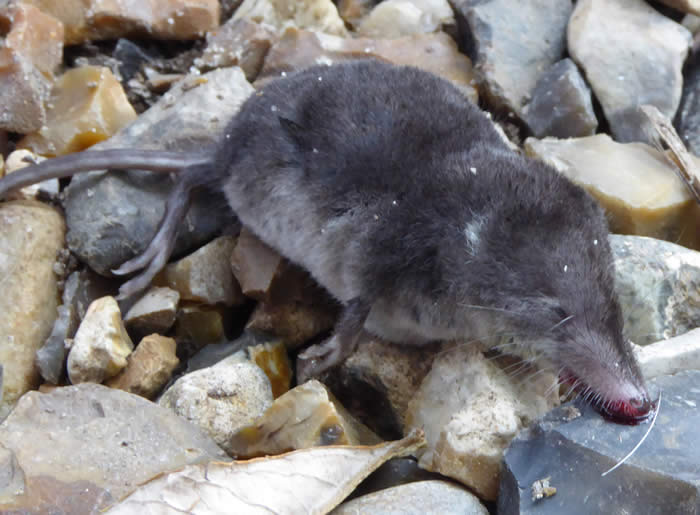 |
22 October: stonechat, male, around big bramble patch. 6 Common Darters warming themselves on one fence, with more elsewhere, including in the ivy corner. Lapwing, snipe, water rail called.
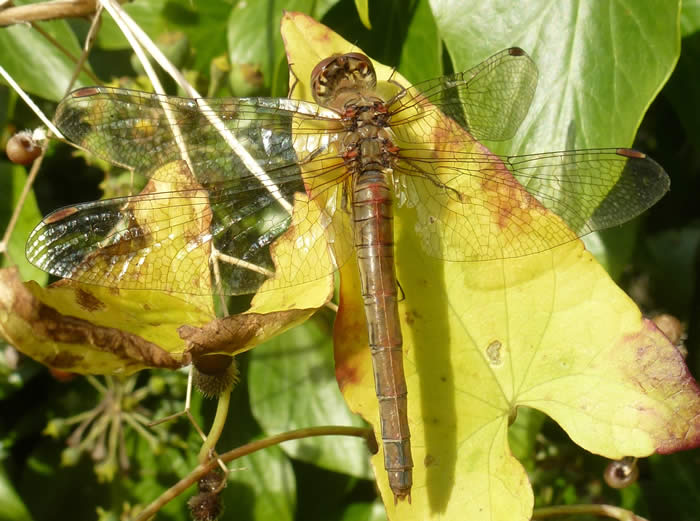
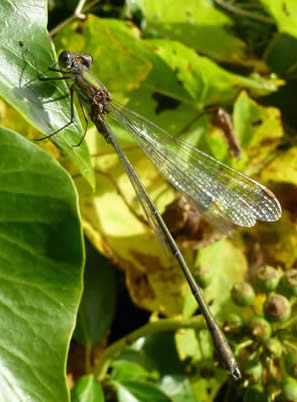
Common Darter and Willow Emerald on ivy, 20 October. 'Dragons and a damsel on ivy' photos on Facebook here.
20 October: bearded tits again, 1 seen; yellow-browed warbler, hawfinch over (MC). Willow Emerald on ivy, Common Darter (CD).
17 October: 2 bearded tits reported (MC).
11 October: snipe and redwing, signs of autumn. Water rail heard, several Cetti's warblers singing. Common Darters still egg-laying; Migrant Hawker; couldn't find a Willow Emerald.
Ichneumon wasp on hogweed, 11 October: best guess is Amblyjoppa proteusfemale.
21 September, a.m.: Willow Emerald, Migrant and Brown Hawkers, Common Darters. Green woodpecker, little egret, 1 lapwing, water rail heard, Cetti's warbler and chiffchaff singing. p.m. 31 Willow Emeralds counted (DL).
13 September: 2 Willow Emeralds from railway bridge. 2 common sandpipers by St Andrews Broad.
8 September: c.20 Willow Emeralds (DL).
7 September: 6 x Willow Emeralds - without checking Bungalow Lane area.Nodding bur marigold (see right) very obvious, especially around flood area. 4 linnets over, 2 tufted ducks. Several Common Blue Damselflies looked like they'd recently emerged. Brown and Migrant Hawkers.
30 August: common sandpiper, lapwing, Willow Emeralds again.
26 August: minimum of 6, probably 8 Willow Emerald Damselflies at eastern end of the reserve. Also count of 12 today - DL. Ditch running parallel to Bungalow Lane seems to be the best place to see them.
23 August: 4 male Ruddy Darters holding territory, many Brown Hawkers and c.20 Migrant Hawkers, 2 tatty-looking Black-tailed Skimmers, Common Blue Damselfly. Common blue butterfly and other regular species. 2 little egrets in flight; c.21 lapwings on the west beach, a group (probably a family) of tufted ducks with them. Also 4 x Willow Emerald Damselflies (SW) at eastern end of the reserve.
5 August: Common and Ruddy Darters; 2-3 Norfolk Hawkers, perhaps the season's last; Brown Hawker now the commonest dragonfly. Reed warbler feeding two large youngsters. Failed to find yesterday's either of Thursday's Red-eyed Damsel species. Arrowhead in flower. Chinese water deer.
4 August, guided walk: Lots of wonderful high summer flowers. Spear-leaved orache noted.

Angelica with Black and Yellow Longhorn Beetle Rutpela maculata (formerly Strangalia maculata)
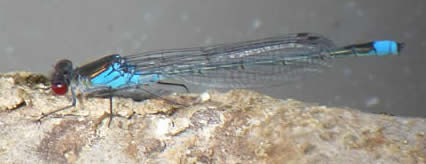

Big news was after most the group had left: Small Red-eyed Damselfly (right), the 20th odonata species (dragonflies and damselflies) for the reserve. It's a species rapidly colonising the UK following its first appearance in 1999. Interestingly this male was in a ditch, characteristically on surface vegetation, namely some blanket weed, close to a male (Large) Red-eyed Damselfly (left), that was perched on a stick. Both photos were digiscoped.
3 August, evening walk with Norwich Bat Group: little egret. Five bat species: Daubenton's seen welll over the river and a clear sound record of Nathusius's pipistrelle. Noctules seen, soprano pipistrelles seen and heard well, less distinct sound record of common pipistrelle.
|
31 July: Beautiful China-mark moth; Emerald Damselfly; painted lady (DL). Beautiful China-mark moth Nymphula nitidulata (Derek Longe). The third China-mark species of micro-moth seen here, after Brown and Small. Larval foodplants bur-reed, yellow water lily and others. |
23 July, on the flood: 1 snipe, 1 water rail (did they breed? Yes, as young were seen in the last week on July). Emperor dragonfly.
18 July: small copper, 3 big juvenile gadwalls, kingfisher, Brown Hawker, a late Large Red Damselfly. Gatekeeper, Ruddy Darter (SW).
Black-tailed Skimmers on show today, and still lots of Norfolk Hawkers.
15 July: 31 Norfolk Hawkers, Four-spotted Chaser, Brown Hawker, Common Darter (last two first of the summer). Commas looking to egg lay on nettles by riverside path. Little Egret and at least 10 lapwings (DL).
14 July: little egret, male Broad-boded Chaser, Chinese water deer. Buttonweed confirmed by the flood.
8 July, guided walk: grasshopper warbler, tufted duck with ducklings, Norfolk hawkers and more.
7 July, guided walk with CIEEM: two startling invertebrates, below. Also grasshopper warbler singing.
Crab spider Misumena vatia on a marsh ragwort; mullein moth caterpillar, but don't be fooled by the dock, it's actually on a figwort stem, one of its food plants.
4 July: ringlets, 38 Norfolk hawkers, black-tailed skimmers (SW).
2 July, with Society for the History of Natural History: large skipper, comma, grasshopper warbler singing.
30 June: meadow brown, mute swan with 5 cygnets, one a white 'Polish' type, tufted duck female with c.7 small ducklings, grasshopper warbler singing. Count of 22 male Oedemera nobilis, the Thick-Legged Flower Beetle - right, on valerian. |
28 June: count of 40 Norfolk Hawkers (DL).
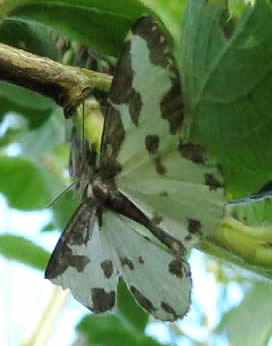 |
20 June, evening, guided walk: kingfisher, clouded border moth, some evening dragonflies, good view of sedge warbler and reed bunting. Clouded border (Derek Longe) 16 June: Broad-bodied Chaser male, 32 Norfolk Hawkers (DL/SW). |
14 June, RSPB Norwich local group: hobby, male marsh harrier, common tern, willow warbler (and other warblers) singing.
12 June: 3 early marsh orchids found.
7 June: 2 x Norfolk Hawkers (SW)
6 June: four-spotted chaser, painted lady, diamond-backed moth - there seems to be a mini-invasion of these (DL/MC)
30 May: 2 common terns, c.30 house martins, 16 Canada geese. Ragged robin in flower.
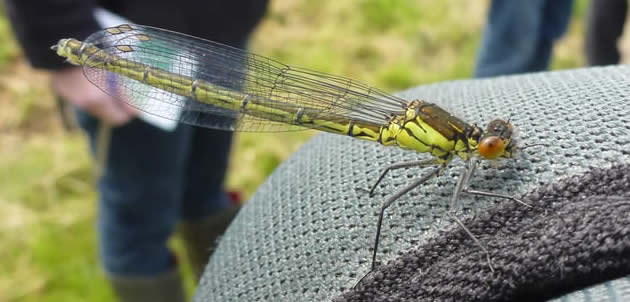
Red-eyed Damselfly, immature, on telescope 23 May 2016 ... see Trapped!
23 May, guided walk: 5 species of damselfly, including Large Red-eyed. Hairy Dragonflies mating. Lots of singing warblers. Harlequin ladybirds and many larvae.
22 May: 2 hobbies, male marsh harrier and egg-laying Hairy Dragonfly.
17/18 May: gadwall with chicks, peregrine (RC). 17/19 May: 4 x species of damselflies (DL, SW)
10 May: cuckoo, heard from home, dawn.
5 May: lesser whitethroat, reed warbler. Orange-tips, green-veined white. Large Red Damselfly (DL). Garden warbler (MC). 6 gadwalls: will last winter's management encourage them to nest?
24 April, evening: c.70 hirundines (c.60 swallows, 10 sand martins) over Broad. 2 green sandpipers, common sandpiper. "Possible but frustratingly distant pale phase booted eagle" I wrote ... but later shown to be buzzard. Pale buzzard, photo by Drew Lyness |
 |
21 April: 7 warbler species, including grasshopper warbler. Common sandpiper.
19 April: first whitethroat, 1 grasshopper warbler (08:30), lots of sedge warblers, willow warbler and more.
18 April, dusk: 3 grasshopper warblers singing, 1 of which just off reserve to E. 46 tufted ducks. 3 noctules over river, 3 over west marsh. Several snipe (c.6).
13 April: 3 little ringed plovers, 3 green sandpipers, oystercatcher, 3 lapwings. Sedge warbler and blackcap singing; 8 lesser black-backed gulls. First lady's smock flower.
10 April: loud water rail and pair of gadwalls on extended flood: late winter birds or staying this year? Time will tell. 22 hirundines (c. 8 house martins, c.14 swallows), also sand martin. 51 tufted ducks still, 2 oystercatchers, 1 lapwing, great crested grebes displaying on Broad.
5 April: garden bumblebee, hairy-footed flower bee and smooth newts (JE).
4/5 April: sedge warbler, willow warbler, house & sand martins, swallows (RC).
30 March, guided walk: chiffchaffs, lapwing, gadwall, teal, tufted ducks. Flea beetles, small tortoiseshell, 7-spot ladybird. Marsh marigolds, coltsfoot, alexanders.
27 March: common scoter! Also 2 oystercatchers, weasel. Right: common scoter on St Andrews Broad, with black-headed gull. 25 March: chiffchaffs and reed buntings singing. Lapwing and 4 oystercatchers. Two kingfishers flying around. 28 tufted ducks, just 2 teal. Coltsfoot still looks good. |
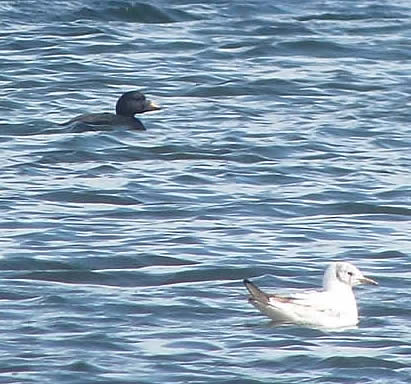 |
11 March: 60 tufted ducks, male shoveler, siskin over. Coltsfoot by the river looks great.
24 February: 2 oystercatchers - a sign of spring?
|
19 February, guided walk: 2 male shovelers, Chinese water deer, scarlet elf cup & yellow brain fungi. Left: 2 male great spotted woodpeckers tussling (Derek Longe). Cormorant confirmed as sinensis subspecies - below, with gadwalls. |
12 February: lots of bird song first thing, reed bunting on territory. Low numbers of ducks. Scarlet elf cup by path from Bungalow Lane. 11 February: 58 lapwings (SW). Pintail x domestic mallard at River Green - see News, right. 3 February: firecrest reported near the river: wonderful picture on Twitter. |
25 January: probable brimstone on Yarmouth Road, little egret, 10 cormorants, 8 lapwings.
Influx of ducks from Whitlingham CP: 218 tufted ducks (minimum), 51 pochards, 44 gadwalls, 1 shoveler, 1 goldeneye, 47 teal. Also Aythya hybrid (pochard x ferruginous duck) on the broad (MC) - reference photo on Yare Valley Wildlife website here.
21 January: 5 woodcocks at dusk, barn owl disturbed a jack snipe (MC).
18 January, guided walk: at least 2 Chinese water deer, 2 buzzards.
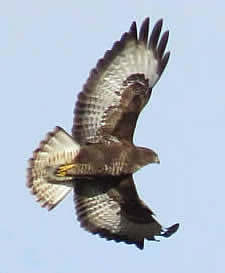
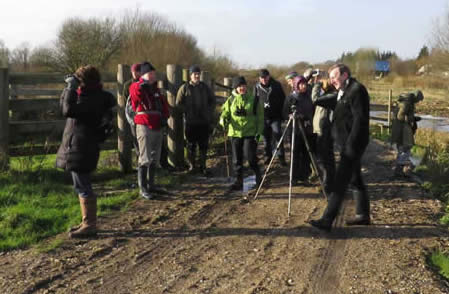
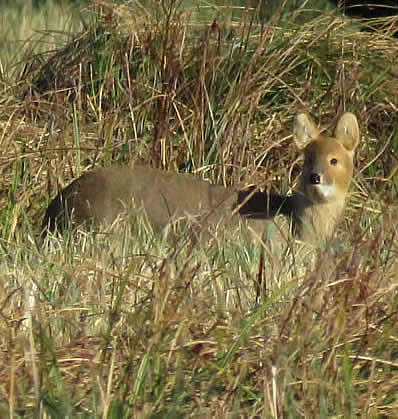
Buzzard, guided walk group, Chinese water deer (photos, 18 Jan, Derek Longe).
13 January: weasel on Bungalow Lane. 33 pochards (again!). 8 January, dusk: night heron heard (MC). 4 & 6 January: barn owl at dusk (MC). |
2015
28 December: tufted duck 60, pochard 33. Lesser celandine and meadowsweet in flower! 2 Chinese water deer - an increasingly routine sighting.
22 December: shelduck, tufted duck 50. Excavated edges on the Broad popular for loafing gulls, including 47 herring gulls, also 3 lapwing. Kingfisher over new ponds. Another small tree with Willow Emerald egg-laying scars discovered.
11 December, on guided walk: weasel high in dead vegetation hunting a harvest mouse (identified from photos). Mild weather so still flowers: hogweed, cow parsley, angelica, white dead-nettle, perennial daisy, bramble, ivy-leaved toadflax and hedge mustard. Teals, gadwalls, tufted ducks, 2 herons. Several fungi including velvet shank, jelly ear and blushing bracket.
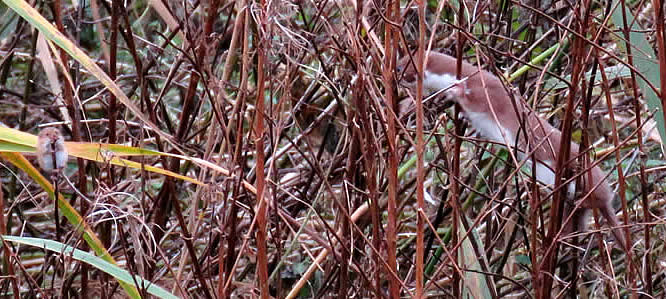
Weasel and harvest mouse (Derek Longe)
2 December: warm weather, a common carder-bee feeding in a white-dead-nettle flower and other insects on late-flowering hogweed. 8 meadow pipits.
28 November: male goosander flew over the broad, heading west.
25 November: green sandpiper, lapwing, snipe. 2 goldeneyes.
22 November: 4 goldeneyes, 15 teal. Grey wagtail, kingfisher, 2 redpolls. Snow!
20 November: 5 goldeneyes flew off, and 3 wigeons arrived. One pochard with the tufted ducks. Water rails squealing and Cetti's warblers singing.
4 November, on guided walk: 8 whooper swans flying over (several times, photo by Derek Longe below), 40+ snipe, 10 tufted ducks, single wigeon and shoveler females, sparrowhawk. Plus 31 flower species, listed here.

1 November: comma butterfly, goldcrest, tufted ducks, snipe, still lots of caddis-flies.
29 October: comma butterfly, female goldeneye, redwings and skylarks over, several meadow pipits.

Autumn colours on guelder rose, with excavator behind.
23 October, guided walk: redpolls, redwings and skylarks over. Little egret.
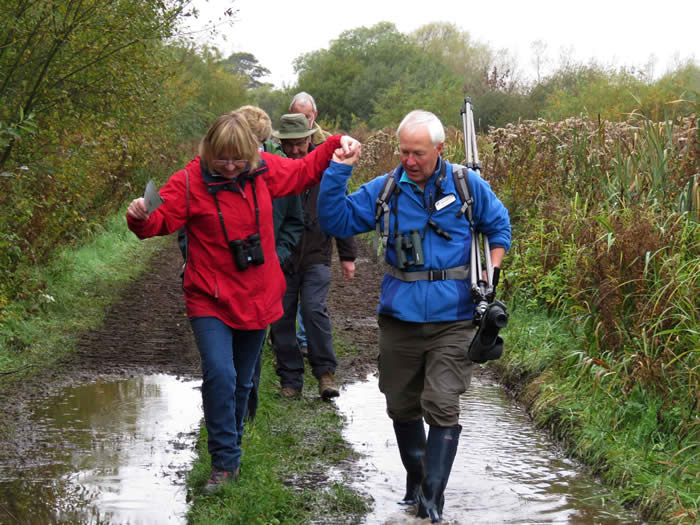
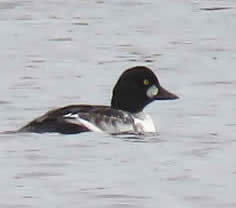
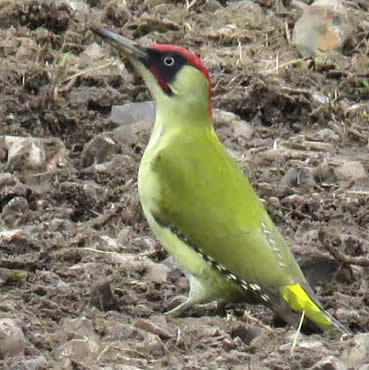
Challenging conditions; male goldeneye; green woodpecker, all on guided walk today. Photos by Derek Longe.
22 October: 2 redpolls, 3 redwings over, water rail heard, hornet, caddis flies, Migrant Hawker. Diggers hard at work.
October sightings, various dates: 21 October, caddies flies showing (DL); 17 October, red-legged partridge (JE); 15 October, goldeneye, green sandpiper, water pipit, brambling over, 18 skylarks over, 173 redwings over (MC); 11 October, short-eared owl, ring ouzel (MC).
30 September: kingfisher on the river. Management work is underway.
Cutting the marsh by the railway line where c20 years ago early marsh orchids were in good numbers before they disappeared as coarser vegetation took over. Let's hope this does the trick. More information here.
20 September, Willow Emerald update: 10 found by Derek Longe. I saw 3, but also found an additional five sets of egg-laying scars to the two known previously. Also Common Darter, Migrant & Brown Hawkers. 5 gadwalls.
18 September: Southern Hawker. 3 snipe (minimum), flew when a buzzard came near.
11 September: 2 male Willow Emerald damselflies. Tip: look for them on a sunny, sheltered spot, on branches or other vegetation over a ditch.
10 September: 3 curlews, 2 marsh harriers, c15 gadwalls, 30-40 teals, 3 snipe (IH). Water rail called, 2 buzzards, sparrowhawk, 2 tufted ducks, 2 chiffchaffs. 3 Willow Emeralds and lots of Migrant Hawkers. Also Common Darter, Common Blue Damselfly on river. Butterflies included holly blue and speckled wood.
Willow Emerald. Egg-laying? But not in tandem, yet a strange pose. And a pair of Migrant Hawkers.
4 September: a cool and grey morning for the monthly walk. Groups of feeding house martins and swallows. Lesser marsh grasshopper. Plenty of flowers still - those above and more, including skullcap still out.
1 September: Brown Hawker and Common Darter. Cetti's warbler singing. Nodding bur marigold in flower (right). Recent reports of Migrant Hawker, Willow Emerald Damselfly and Roesell's bush-cricket.
23 August: windy, but still very tame Ruddy and Common Darters, plus Red-eyed (still) and Common Blue damselflies. Several harlequin ladybirds. Angelica attracting wasps and hoverflies. Holly blue.
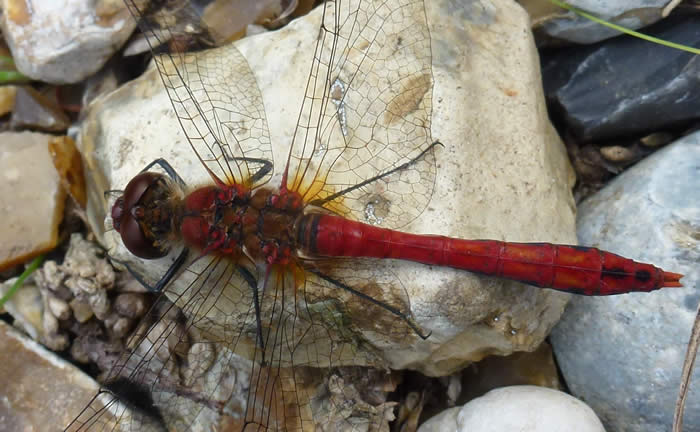
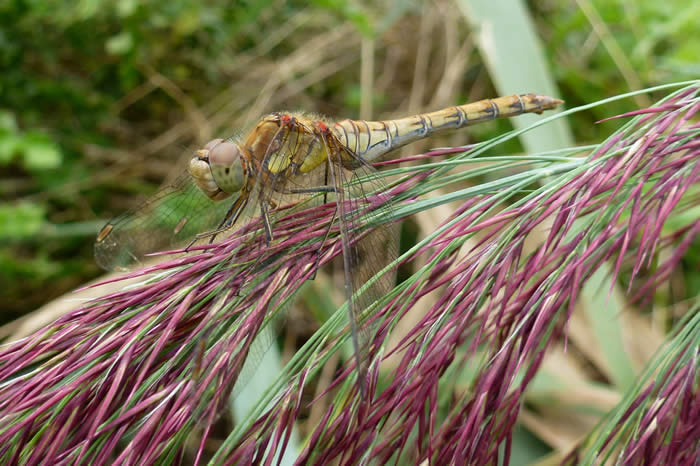
Ruddy darter: note the narrow waist and the black legs can be seen well against the pale stone. Common Darter on a reed.
16 August: common lizard, ruddy darter, green-veined whites and other usual butterflies, female tufted duck. Flowers in fine colour still.
Orange balsam against the river.
3 August, guided walk: 2 grey herons; large numbers of greylags (2 family parties?) on Broad. Goosander at River Green - see right. Flowers at their high summer best in the ungrazed areas, especially. Dragonflies: Brown Hawker, Emperor, Four-spotted Chaser, Black-tailed Skimmer, Common Darter (Ruddy Darter yesterday, SW).
Damselflies: Common Emerald (male), Common Blue, Red-eyed, Banded Demoiselle. Butterflies included small skipper, green-veined white, comma and peacocks. Skullcap sawfly larva Athalia scutellariae. Photo (right) and ID thanks to Derek Longe. |
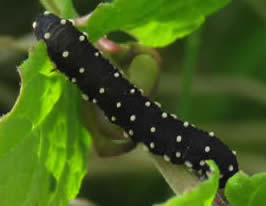 |
1 August: 9 tufted ducks and 1 pochard came and went. Reed warbler singing. Lots of flowers of high summer (as above); also skullcap (left) and the unusual white-flowered form of greater willowherb. |
16 July: a good day for butterflies, with 10 species including small skippers, ringlets and green-veined white. The buddleia near the bridge is flowering attracting commas and others. Too early in the day for Norfolk Hawkers (18 in the afternoon, SW). Emperor and Brown Hawker dragonflies. 12 lapwings, pheasant family, common tern.
10 July, on guided walk: still lots of Norfolk Hawkers, 3 common terns. Flowers included celery-leaved buttercup and square-stalked St Johnswort. Fungi: buttercup rust and Dryad’s Saddle on a fallen poplar Polyporus squamosus (left) |
30 June: 46 Norfolk Hawkers counted on a survey (SW).
18 June: 2 oystercatchers, some bird song still. Five species of damselflies, including Blue-tailed. Lots of celery-leaved buttercup around the now dry flood. Large skipper and painted lady: there's talk of an invasion year for the latter, though it won't be as dramatic as 2009.
7 June: 2 little egrets, 2 oystercatchers, lapwing. Willow warbler (and others) still singing well. Norfolk Hawkers and Hairy Dragonflies. Early marsh orchid - just the one.
27 May: at least 18 Red-eyed Damselflies on lilies in the river (+ 4 other damsel species, as below, and Hairy Dragonflies). Little ringed plover, 3 lapwings, garden warbler. Yellow flag irises looking gorgeous (below).
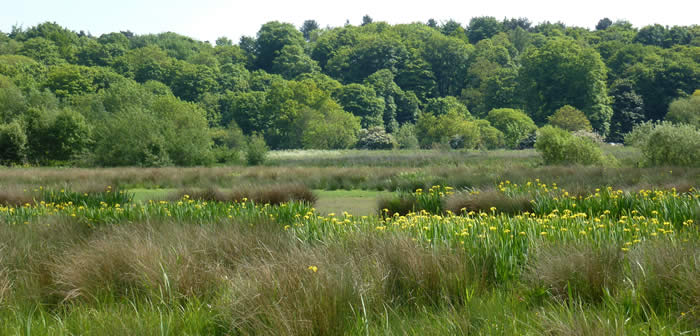
23 May: little egret, buzzard, nightingale nearby here (RC).
21 May: Banded Agrions emerging, by the river. Also Large Red Damselfly and Hairy Dragonfly. Also 'reed beetles': see picture, right. Plus (on 20/5) Azure and Red-eyed Damselflies (SW).
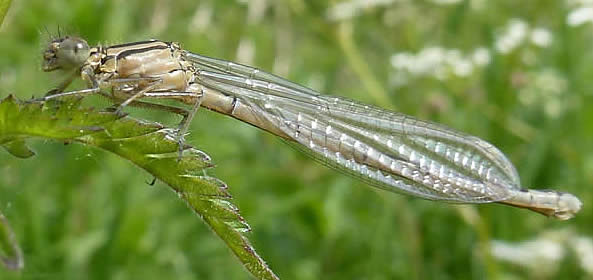
Scores of Common Blue Damselflies around: many are blue, but lots are straw-coloured immatures.
18 May: about 20 house martins, two pairs of great crested grebes on a rather wet guided walk.
17 May, dusk: two nightingales singing just east of the reserve.
11 May: orange-tip transect - 16 males, 13 females. Green-veined white. Damselflies: Common Blues, and Large Reds, also one distant dragonfly (Hairy?). 2 gadwalls, 3 lapwings, 6 stock doves.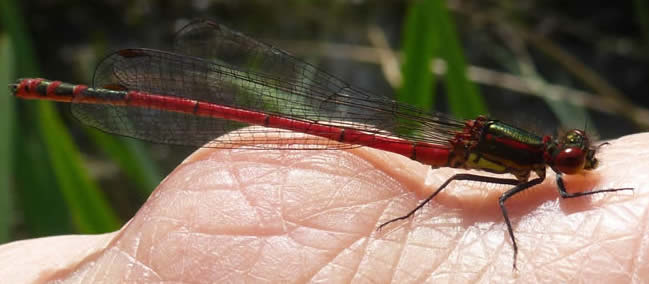
Large Red Damselfly: the pink mountains are my knuckles. I was creeping up on it, and it landed on me.
10 May, evening: nightingale heard from the mooring basin area over in Whitlingham Country Park. Common sandpiper, 2 common terns, cuckoo. Chinese water deer.
4 May: nightingale singing still, just off the reserve. Hobby, female cuckoo with bubbling call, 2 little ringed plovers (RC).
3 May: otter!
2 May: cattle are back on the marshes today, mostly shorthorns, one red poll. Definitely two garden warblers in riverside scrub, with blackcap and whitethroat. Left: egg-laying scars of Willow Emerald Damselfly, photographed today. Full size picture here. 30 April, with Rackheath WI: nightingale heard, 8 species of warblers, cuckoo. |
29 April, late afternoon - nightingale in Bungalow Lane. Photo, right, by Ricky Cleverley. 29 April, morning guided walk: cuckoo, garden warbler, buzzard, swallows and house martins. Eggs of orange-tip, egg-laying scars of Willow Emerald Damselfly. SpiderLarinioides cornutus. |
 |
29 April, continued: 3-spined stickleback 'nest'.-Photo, left, by Derek Longe. 27 April: first damselfly: a Large Red (JH). Broods of Canada goose and mallard on the broad and two teal - surely they'll go soon? |
24 April: orange-tip butterflies, and an orange-tip egg on ladies smock (right). 23 April: 7 swifts in Yare Valley, also seen yesterday evening. Lots of warblers in song, including willow warblers, scarce last year. |
 |
22 April ... various dates and observers in previous week: reed warbler, nightingale in Bungalow Lane (gone now), green and common sandpipers, little ringed plover, orange-tip and green-veined white butterflies, alder fly.
11 April: sedge warbler in full song (also reported 10/4), first lady's smock flowers, Chinese water deer. Passage waders reported in last few days including green & common sandpipers, little ringed plover and greenshank (MC).
5 April: first marsh marigolds in flower, near mooring basin.
2 April: red kite (MB), also swallow yesterday (TB), coal tit.
31 March, on a blustery guided walk: chiffchaffs, reed buntings, buzzard, tufted ducks, 4 oystercatchers, small tortoiseshell, scarlet elf cup fungi.
29 March: very vocal chiffchaff, a visit that was supposed to be between showers ...
26 March: Chinese water deer flushed a jack snipe; recent report of barn owl at dusk (MB). Duck numbers declining.
20 March: kingfisher over the Broad; sunshine (once the eclipse had finished) brought out small tortoiseshells; flowers as above, especially a nice display of coltsfoot by the riverside footpath.
19 March: four (later 5) displaying oystercatchers, though they are unlikely to nest - much the same happened last March.
Last week (various dates): firecrest, woodcock, up to 5 oystercatchers, ringed plover, curlew, whimbrel, bittern seen flying over (17/3) and first butterflies on sunny days.
5 March: great crested grebes displaying (JH).
4 March: dunlin on gravel bank (MC).
1 March: 3 oystercatchers - 2 displaying.
20 February: on guided walk: chiffchaff, reed bunting singing, oystercatcher. Later: barn owl at dusk flushed a jack snipe; 3 water rails heard, chiffchaff, 2 x Chinese water deer (MC).
Two colourful fungi this morning: scarlet elf cup (L) and velvet shank (R).
19 February: at least 3 reed buntings, including one singing. Also: merlin, woodcock, jack snipe, 3 bullfinches (RC) - quite a morning!
16 February: jack snipe and marsh harrier (JE).
6 February: buzzard, 19 lapwings. Mediterranean gull still at River Green.
2 February: unusual count of 29 herring gulls. Similar duck and lapwing numbers, though pochards down to 3 and no shovelers.
30 January: 22 pochards; 3 shovelers; 87 gadwalls; 100+ teal; 20 coots; 20 lapwings; c250 black-headed gulls and 2 herring gulls (JH).

Ducks concentrated on the unfrozen part of St Andrews Broad, 23 January 2014.
22 January: record count of teal - 257. Also, 121 gadwalls, 28 tufted ducks, 11 coots, male pochard. (JH) Broad mostly frozen.
19 January: 3 wigeon (1 male). Fungi on guided walk: Velvet Shank, Hairy Curtain Crust, Oyster Mushroom, Blushing Bracket, Southern Bracket, Yellow Brain (left) & Smoky Bracket. |
18 January: 120 gadwall, single male shoveler and female pochard.
15 January: 10 lapwings, 99 gadwalls, 91 teal; 38 tufted ducks and 1 little grebe on the Broad.
4 January: kingfisher on river; 2 water rails calling; male bullfinch; redwing. Counts (minimum, probably more) of 69 gadwalls, 17 teal and 21 tufted ducks, but goldeneyes gone.
2014
29 December: 2 goldeneyes, 8 lapwings, gadwall and tufted duck numbers building.
27 December: 4 shovelers, 1 male wigeon, 4 lapwings, 1 goldeneye.
23 December: 2 goldeneyes; other winter duck numbers building up, namely 30 gadwalls, 35 tufted ducks, a few teal and 2 coots. Dead swan on the marshes.
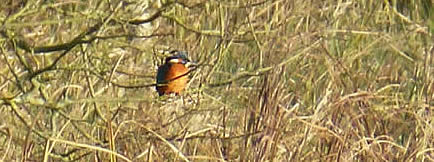
15 December: kingfisher on a ditch (distant shot, above), Chinese water deer, goldeneye, lots of snipe, song thrush eating guelder rose berries.
11 December, on guided walk: goldeneye, 2 wigeons, gadwall, tufted duck, teal. Water rail heard. Lots of snipe: c.40, probably lots more, 4 lapwings.
5 December: water rail showed. Tufted ducks, gadwalls, little grebe on pit.
26 November: redwing, goldcrest, grey wagtail, vocal water rails again.
 |
24 November: c.25 snipe, water rail vocal, green woodpecker. Heron, tufted duck, gadwall and cormorants on the broad. Crocodile in the River Yare. Or it might be a log. |
24 November: c.25 snipe, water rail vocal, green woodpecker.
19 November: goldeneye has gone. Feeling wintry. A red admiral reported. Last few caddis flies around: this one on hogweed probably Limnephilus lunatus, with the half-moon shape at the wing end. |
18 November: goldeneye still there, with 7 tufted ducks and a little grebe.
15 November: female goldeneye reported, on the Broad.
10 November: on guided walk, some 30 species of flowers found (list here). c20 snipe, 6 meadow pipits on the marsh. Hoverflies (as below), common carder bee, nursery web spider. |
Today's warmth brought out Common Darters, this one sunbathing, others in tandem and egg-laying (10 November 2014). Seen again on 12 Nov but not since.
4 November: Common Darters still egg-laying. Every hogweed flower seems to have a hoverfly and/or a caddis fly. Teals, snipe, Migrant Hawker.
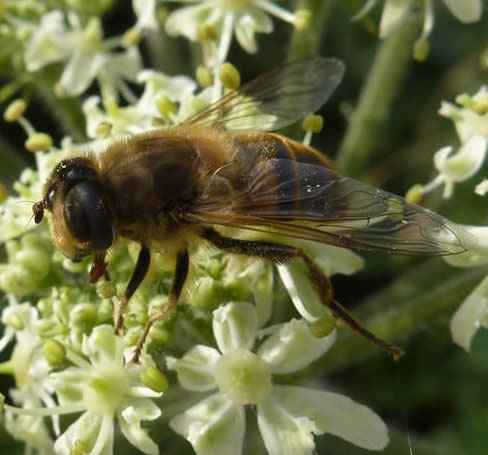
Three November hoverflies on hogweed: marmalade fly Episyrphus balteatus; Syrphus ribesii; Eristalis tenax (not to scale) . . . unless anyone can come up with better IDs?
1 November: Common Darter, 3 stock doves but not many birds, plenty of last lingering flowers and insects.
24 October, on guided walk: long-winged conehead, caddis flies, hornets, common carder bees. Little egret (2 sightings), snipe, water rail heard, c.120 teal, 5 shovelers, Cetti's warbler singing. All without going across the flooded marshes. Nursery web spider Pisaura mirabilis, 24 October. |
 |
23 October: marsh paths still under water (pics below), but riverside footpath OK. Water rail heard x 2, c.100 teal, 4 shoveler over, lots of snipe.
22 October: reserve flooded in the wake of hurricane Gonzalo.
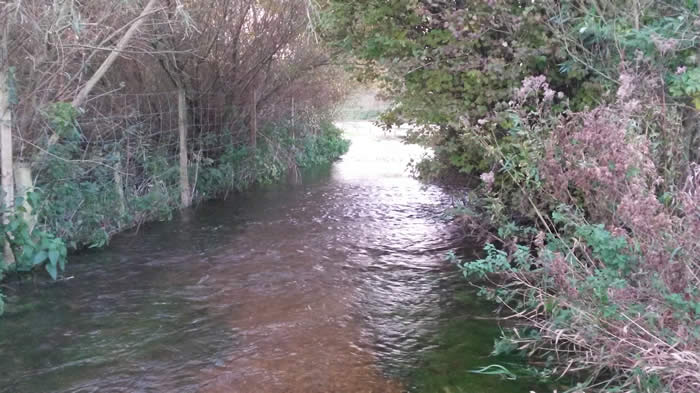
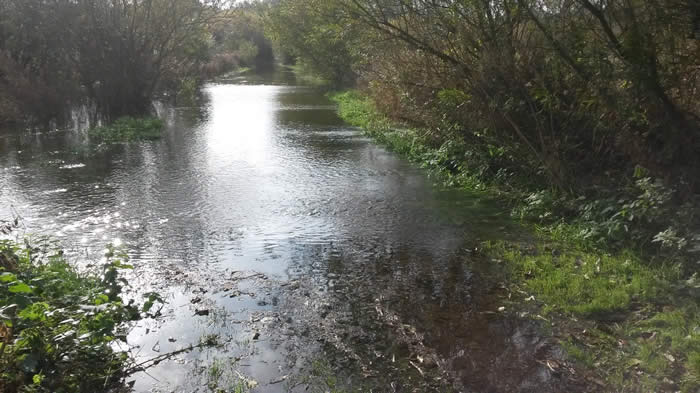
Photos by Jeremy Halls
17 October: 3 Willow Emeralds, again including a mating pair, but in a different area. Common & Ruddy Darter, Migrant Hawker. 3 buzzards over the wood, c. 30 teal, lots of snipe and several meadow pipits.
3 October: 5 Willow Emeralds, including a mating pair (right). Common Darter & Migrant Hawker also egg-laying. Buzzard, kestrel, sparrowhawk, 4 snipe (minimum); Chinese water deer. Frog - surprisingly scarce, I find.
30 September, with BESL team: long-winged conehead and dark bush cricket; otter spraint; great view of a buzzard. Several kingfisher sightings on the river. Common & Ruddy Darters and Migrant Hawkers. Common lizard reported.
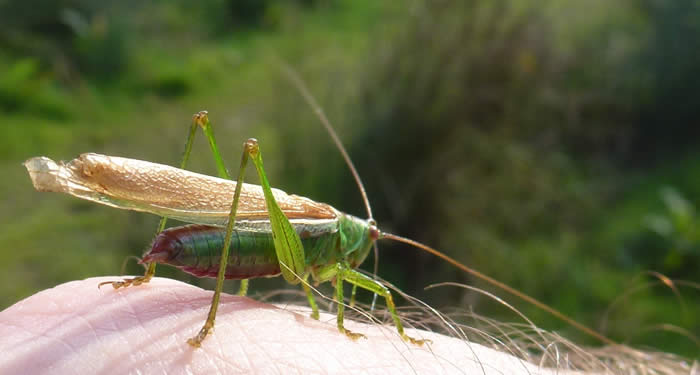
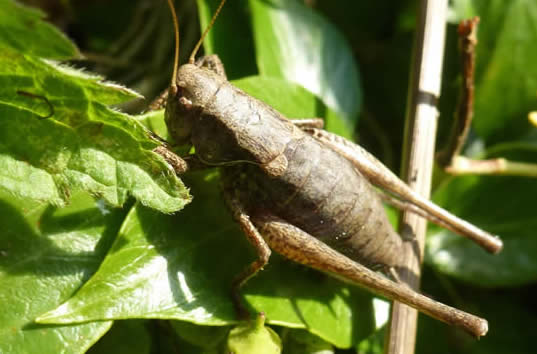
Long-winged conehead and dark bush cricket; the latter also has long antennae but cropped from this photo.
27 September: Ruddy Darter and other late dragonflies still showing.
26 September: Cetti's warbler & chiffchaff singing. Snipe. Whinchat reported.
 |
18 September: Willow Emerald (my first ... another photo, left, also see NWT Blog). Ruddy and Common Darters in tandem, Migrant and Brown Hawkers. 17 September: whinchat. Also 2 green sandpipers and first snipe reported. |
16 September: Willow Emerald Damselfly! New species for the reserve, though I missed it. It's recently colonised the UK but is already known from Strumpshaw Fen and west of Norwich, so we were looking and hoping to find it. Also lots of Migrant Hawkers, 14 lapwings and skullcap (photo in July, below). Right: Willow Emerald Damselfly (Susan Weeks) |
5 September: on guided walk, 4 dragonfly species (as 3 Sept) and lots of 4-spot orb web spiders Araneus quadratus (and a male garden/cross spider, ID after looking at photos); nodding bur marigold, both with and without flower 'rays'. Old lady moth, dead on railway bridge.
3 September: at least 10 male Ruddy Darters, similar numbers of Brown Hawkers (right) and 20+ Migrant Hawkers. Also common darter. Orb web spider.

Male Ruddy Darter, 3 September - landed on my hand!
19 August: blackcap and chiffchaffs with mixed tit flock (long-tailed, blue, great). Late summer swallow - migrants? - especially with the cattle. A few Brown & Migrant Hawkers, but chilly and they soon disappeared.
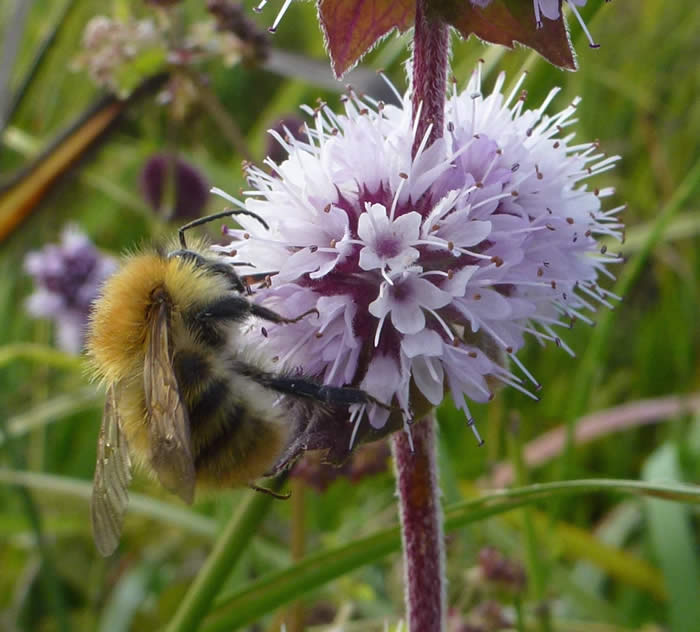
Red bartsia; water mint with common carder bee. Both 19 Aug (see NWT blog).
12 August: guided walk, again blustery. Lots of house martins and several swifts. Water boatmen; 3 darter species. 3 damsels: Banded Agrion, Red-eyed and Common Blue (right, in tandem, digiscoped). 9 August: windy morning, but still 6 dragonfly species. Migrant Hawkers the most common: some emerging females, I think. Brown & Southern hawker, Black-tailed Skimmer and both Common & Ruddy darters. No Norfolk Hawkers gone. Lots of pink and purple flowers - as in photo selection above, also red bartsia. |
2 August: a selection of invertebrates found and photographed by James Emerson.
Dock Bug, late instar (they go through several stages); Dingy Footman moth; Spotted Longhorn Beetle Rutpela maculata.
23 July: a bit windy but still five species of dragonflies (Norfolk & Brown Hawkers, Emperor, 4-spot Chaser and Black-tailed Skimmer) and six of damselflies (Emerald, Common Blue, Azure, Red-eyed, Blue-tailed, Banded Agrion). Must be missing some dragons: no sign of the Ruddy Darters of last week, nor the Common Darter and Southern Hawker that have been in my garden up the road. Skullcap, right, on a ditch edge near the stile a nice find - I don't remember seeing this for a while. |
16 July: great morning for dragonflies and damselflies, five species of each. Dragons: Emperor, Brown Hawker (newly on the wing), Norfolk Hawkers (plenty, but fewer), 4-spot Chaser; Ruddy Darters just out. Damsels: Common Blue, Azure, Banded Agrion, Red-eyed and at least 4 powder blue & green male Emeralds. Also small skipper and many other butterflies.
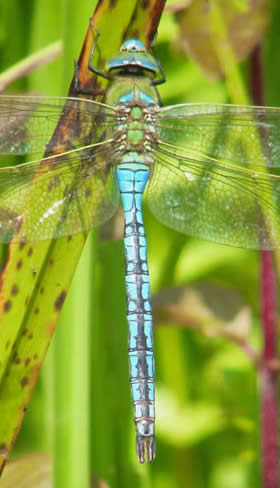
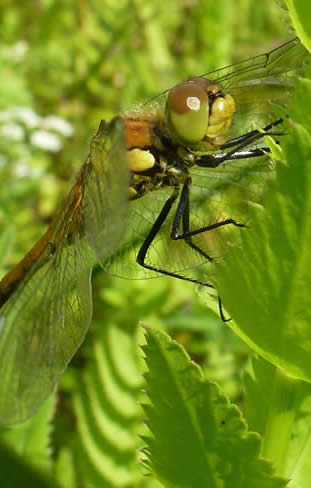
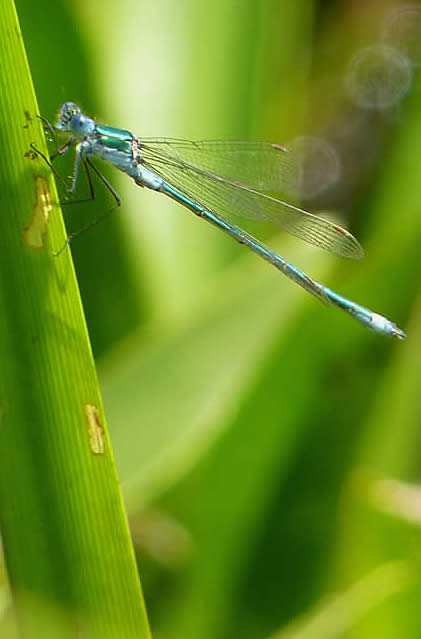
Emperor dragonfly; Ruddy Darter female, just emerged; pair of Ruddy Darters; Emerald Damselfly (= Emerald Spreadwing). Also see NWT blog.
 |
12 July: Norfolk Hawkers still there in good numbers, plus 4 species of damselfles, including Azure. Painted lady on buddleia. Buzzard over, 5 lapwings. Common red soldier beetle Rhagonycha fulva: this red beetle is everywhere on hogweed and other invertebrates, though here on goldenrod. |
11 July: a flock of lapwings over - very autumnal! Oystercatchers, common tern. Lots of summer flowers, but a gloomy day takes away their impact. Emperor dragonfly, 4 x damselfly species. Ringlets in dry, grassy places (photo, right). Evening on guided walk: curlew! Also noctule bat later.
1 July: at least 20 Norfolk Hawkers. Five damselfly species: Common Blue, Large Red-eyed, Blue-tailed, Banded Agrions and my first ever Emerald. Common Emerald Damselfly, female. See also garden tiger moth caterpillar in right hand column. |
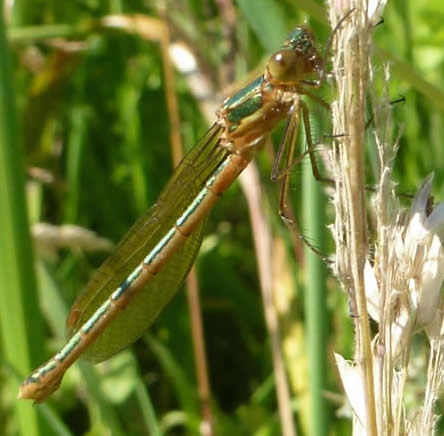 |
23 June: a lot of Norfolk Hawkers. Red-eyed Damselflies and Banded Agrions still on the water-lilies on the river. Evening guided walk: close up views of Norfolk Hawkers; tufted duck with brood of 4 on Broad.
18 June: little egret flying over. Kingfisher on the river; they seem to be flying past fairly regularly, suggesting a nest somewhere on this part of the Yare.
17 June: lots of Norfolk Hawkers. Large skippers. Cuckoos quiet now.
2 June: kingfisher, cuckoo, oystercatchers.
31 May: marsh harrier, kingfisher, Norfolk Hawkers (JE). Early marsh orchid and white ragged robin. Swan with 5 cygnets on the broad.
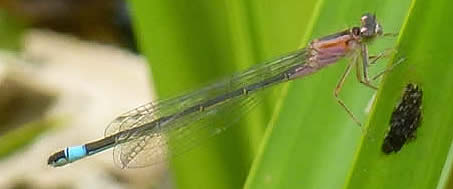
New damselfly for the reserve today: Blue-tailed Damselfly, immature form rufescens. One of six species today: also Large Red (JE), Banded Agrion, Common Blue, Azure, Red-eyed.
26 May: Red-eyed Damselflies - at least 17 - on lily pads on the river (poor photo, R), with Banded Agrions and Common Blue damsels. 2 x shelduck, 2 lapwings, cuckoo singing. |
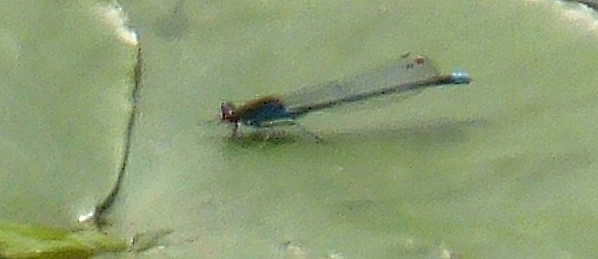 |
19 May, guided walk: 2 hobbies, lots of warblers of 7 species, common sandpiper on river, common tern, 2 oystercatchers. Four species of damselflies, including 4 male Banded Agrions, Hairy Dragonflies, small tortoiseshell caterpillars. Right: large jawed orb web spider Tetragnatha montana with prey, a Common Blue damselfly. |
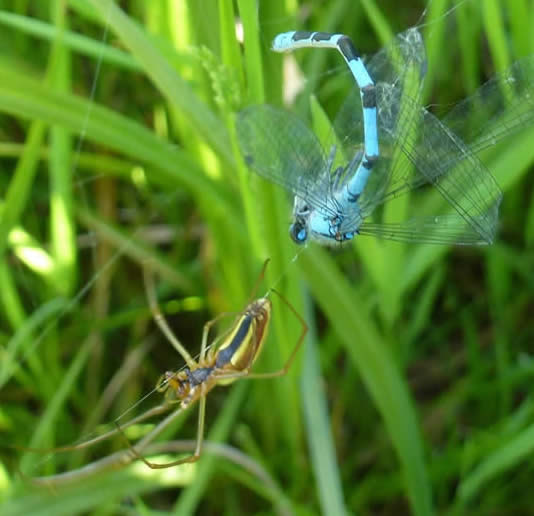 |
18 May: water vole! Azure damselfly and hairy dragonflies, again. Now 5 reed warblers. 2 x shelduck, 2 x common tern (JE).
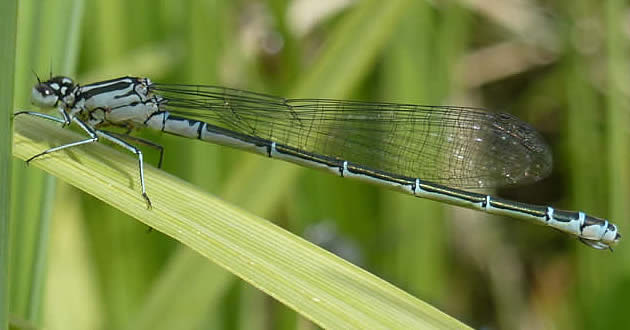
Azure damselfly, 14 May
14 May: now 4 reed warblers, and cuckoo. Four damselfly species today: 100s of common blue, azure, large red and banded demoiselle. Also hairy dragonfly - female, right, with water soldier. |
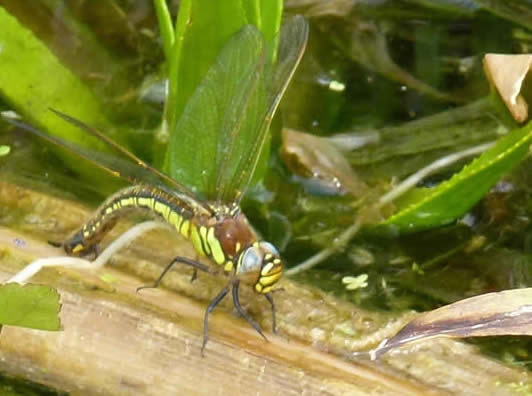 |
11 May: 3 reed warblers singing. Ragged robin and yellow flag iris in flower.
6 May: swifts, bullfinch, garden warbler, oystercatcher. Two broods of greylags (still).
2 May: common sandpiper, oystercatcher, kingfisher. 2 cuckoos (MB).
30 April, guided walk: 2 common sandpipers, 4 lapwings over, 2 buzzards, sparrowhawk. Lots of warblers including garden warbler by the river and lesser whitethroat heard, though it's the vocal whitethroats and sedge warblers that are most obvious. 5 butterfly species, freshly emerged damselflies, 2 unidentified dragonflies. Lady's smock and marsh marigold looking great.
28 April: cuckoo! A female - bubbling call heard. 25 April: whimbrel (RC) 24 April: seven species of warblers, especially lots of sedge warblers & whitethroats and the first reed warbler. Dozens of orange tip butterflies - mostly females laying on lady's smock (see pic, right). 35 tufted ducks. |
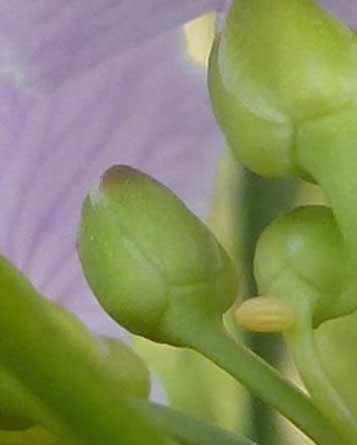 |
10 April: 4 swallows, 3 oystercatchers, 6 lapwings, 105 tufted ducks. Water boatmen in a recently excavated ditch. Lots of butterflies - small tortoiseshells, peacocks, orange-tips. And a rather tame chiffchaff - right.
6 April: sedge warbler singing (also reported earlier this week). Reports of willow warbler, little ringed plover.
30 March: much as two weeks ago: chiffchaffs, lady's smock on one corner, first marsh marigolds if you know where to look.
14 March, guided walk: two chiffchaffs singing, comma as well as small tortoiseshells. Duck numbers (4 species on the Broad) down on yesterday, though a pair of mallards was back on the marshes.
13 March: chiffchaff singing, water rail, buzzard, two pairs of oystercatchers displaying on the recently rotovated shingle. Small tortoiseshells, first lady's smock in flower - and the flowers in the pictures above.
25 February: 164 tufted ducks, but hardly any other wildfowl. 2 jack snipe.
21 February on guided walk: displaying sparrowhawks, c.20 snipe, singing reed bunting, 4 duck species, 4 gull species, 3 great crested grebes in breeding plumage.
19 February: 2 male shovelers on the Broad, 3 meadow pipits.
18 February: two wigeons on the Broad; c100 snipe.
16 February: a seal (probably a grey seal) reported in the river.
13 February: buzzard over the reserve. Pochard numbers have risen to 38, 70 tufted ducks, 10 teal, 55 gadwall. A dog walker reported water vole.
4 February: a sparrowhawk disturbed at least 80 snipe. Gadwalls up to 77 and 5 pochard - mostly not there this winter.
2 February: mild and rather birdless; 59 gadwalls. Ditching underway.
Digger on the permissive path; closed path; after ditching work.20 January: colder
20 January: colder weather, bringing more snipe onto the marshes for weather, bringing more snipe onto the marshes for today's monthly walk. Great crested grebes displaying on the river.
16, 18 & 19 January: goldeneye again, seen to fly to Whitlingham on 18/1. 16/1: Teal calling hidden from view near the permissive path.
10 January: 1 goldeneye with 107 tufted ducks and, briefly, 10 pochards. 57 gadwalls, 8 lapwings and c28 snipe on the edge of the Broad - probably many more hidden from view. Great crested grebe on the river in spring plumage.
3 January: mild weather, and duck numbers remain quite low: 62 gadwalls, 23 tufted ducks. 6 lapwings.
2013
29 December: 110 snipe flushed by a sparrowhawk (Justin Lansdell).
14 December: two peregrines; influx of tufted ducks and pochard when disturbed at Whitlingham CP. (James Emerson)
12 December: c25 snipe (probably many more present) and c25 teal.
6 December: teal flock and many gulls on the flooded marsh. Cetti's warbler singing.
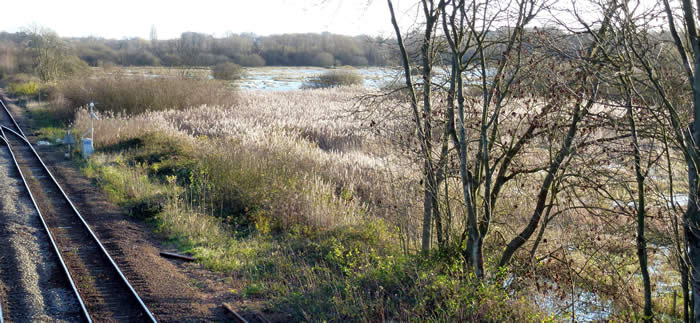
View over NWT Thorpe Marshes from the railway bridge, 6 December.
1 December: 25 teal on flood, several snipe, a few tufted ducks and gadwalls on the broad; 2 water rails calling.
9 November, on guided walk: flock of fieldfares, two water rails heard, several flocks of starlings heading west along the Yare Valley, c20 snipe. How many flower species can you find in November? Find out here.
1 November: redpoll, snipe, but no winter ducks yet. Common darter. Several late lingering flowers, especially hogweed re-growth.
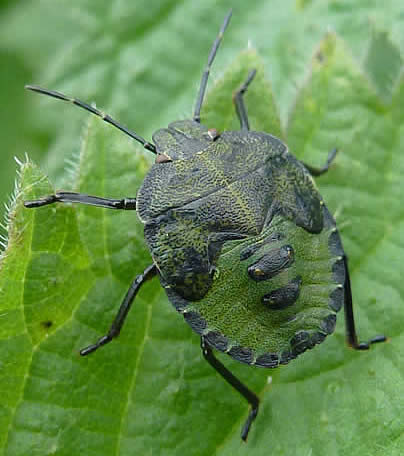 |
14 October: 2 kingfishers; one perched briefly on the gate by the stile. More redwings moving. Goldcrest and treecreeper with mixed tit flock in Whitlingham Lane.
Left: common green shield bug Palomena prasina, 5th instar (larval form), on a stinging nettle, 14 Oct. |
13 October: caddis flies on late-flowering hogweed flowers. First wintering gadwalls: 6 on the flood. Redwings on the move overhead.
6 October: many scores of emerging caddies flies. They appear to be Limnephilus lunatus from the half-moon shape at the wing's end. |
 |
23 September: 70 lapwings, 4-5 snipe, meadow pipit ...all signs of autumn. Buzzard, Cetti's warbler singing, still plenty of migrant hawkers and common darters.
18 September: ruddy darter, lots of migrant hawkers and common darters, 55 lapwings on a much wetter flood.
9 September, on guided walk: ruddy darters mating, common darter, southern and brown hawkers. Willow warbler & whitethroat seen, chiffchaff and Cetti's warbler heard. Kingfisher on the river. It's not the best of photos - digiscoped - but it was exciting to find this pair of ruddy darters on the guided walk. |
 |
23 August: strong bat detector readings at 55kHz shows they are soprano pipistrelles feeding over the marshes.
21 August: ruddy darter (below), emerald damselfly and clouded yellow (Ricky Cleverley & James Emerson). New reserve blog. |
18 August: 18 lapwings on the dry flood. Odonata: brown and southern hawkers, common darter and common blue damselflies. Eight butterfly species: large, small and green-veined white, small tortoiseshells increasing in number and peacocks decreasing, meadow brown, comma, common blue. The semi-parasitic red bartsia is in flower, though tricky to find. |
8 August: two green sandpipers flew over; a male tufted duck as well as the brood on the gravel by the Broad. Southern and brown hawkers, but Norfolk hawkers seem to be gone. Lots of butterflies: small copper an additional species. Twin-lobed deerfly, Chrysops relictus, a type of horse-fly.
4 August: 4 lapwings on the dry flood, a common sandpiper on the Broad's edge and the female tufted duck still has with 6 young on the Broad. Buddleia is alive with butterflies: at least 50 peacocks, painted lady and comma among 10 butterfly species. Red common darters are out; also black-tailed skimmer and emperor dragonflies. |
|
24 July: small tortoiseshell caterpillars on nettles, still lots of Norfolk hawkers. Lots of flowers: white flowers of frogbit in ditches, meadowsweet, marsh woundwort, greater (marsh) birdsfoot trefoil and much more.

Look out for in July: large skipper butterfly, small tortoiseshell caterpillars on stinging nettles and marsh ragwort (but there's also common ragwort on dry paths).
16 July: counted 17 small tortoiseshell butterflies. Whitethroat and reed bunting still singing.
7 July: tufted duck with 6 young on the Broad.
30 June: dragonflies are out, at last. Lots of Norfolk hawkers, hairy dragonfly, emperor, plus banded demoiselle and common blue damselflies in their hundreds. Tree bumblebee - a recent Norfolk colonist - see right. Warblers still singing, including sedge, reed, Cetti's and blackcap and whitethroat and the garden warbler is still there. c10 small tortoisehell butterflies, and 16 lapwings on the dried flood.
Small tortoiseshell butterflies seem to like valerian (30 June).
13 June: garden warbler singing in scrub by the river, and other warblers also singing. Common tern, lapwing (non-breeder or failed breeder?), lots of common blue damselflies.
29 May: fox, oystercatcher and common tern on today's slightly damp walk. Some 50 house martins hawking for insects, mostly over the broad, and lots of warblers in song.
Warblers to look for: reed warbler, whitethroat and blackcap (Paul Davidson).
29 April: several swifts (about 10), and many swallows. Whitethroat, lesser whitethroat and sedge warbler on today's NWT walk, and a Cetti's warbler sang and showed very well by the bridge. Marsh marigolds are superb.
14 April: just one Cetti's warbler singing: it seems likely that this resident warblers has been hit hard by the cold winter. Lots of chiffchaffs and a swallow, but no other warblers yet. First lady's smock (cuckoo flower) in a protected corner and a small tortoiseshell butterfly. Reports in the last week of goldeneye and little ringed plovers.
7 April: 4 shovelers and 88 tufted ducks on the broad, plus a bulky mute swan nest in the reedmace. Male marsh harrier, water rail; 4 green sandpipers and at least 14 teals on the flood. Chiffchaff (at last!) and reed bunting in song.
14 March: ducks numbers have declined – 42 tufted ducks, 19 pochards – and the usual gadwalls are absent, though mallards have appeared on the flooded marshes. (And lower numbers of ducks subsequently.) First coltsfoot and celandines – see pictures above.
2 March: still very good numbers of ducks on the Broad: 134 tufted ducks, 73 pochards, 42 gadwalls and 10 teals on the flood and broad.
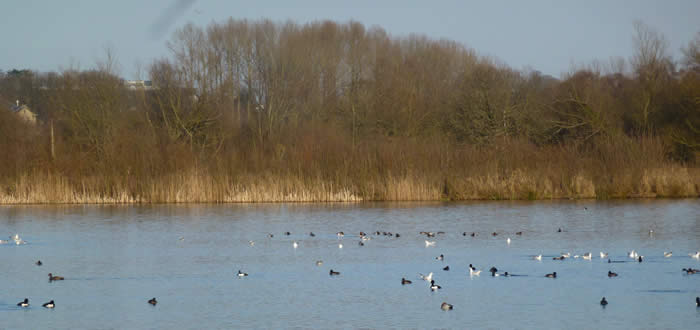
Winter ducks on St Andrews Broad, 2 March.
4 February: about 120 teal on the almost inaccessible marshes (due to flooding).
30 January: 2 male wigeons among many ducks on the broad.
21 January: 2 Chinese water deer; 2 water rails; still a high numbers of ducks on the broad.
20 January: count of 178 of gadwalls, pochards and tufted ducks on the unfrozen Broad. Ringtail hen harrier, water rail, siskins.
11 January: 2 male goldeneyes (below). About 70 teal, mostly males.

9 January: how many snipe are hidden on the marsh? I'd struggled to find nine — three at the back of the Broad and six moving around the flood. Then at 10:45, flocks of birds, so dense that at first they looked like starlings, but were snipe. I estimated 200, including one in the claws of a peregrine, which headed west towards the cathedral, explaining the disturbance causing the snipe to take to the air. A second peregrine showed, very briefly. Then distant skeins of c.70 geese: too distant for a certain ID, but almost certainly pink-feet.
2012
26 December (a.m.): male goosander on the Broad, gone in the afternoon. About 150 siskins and redpolls in a mixed flock.
16 December: female goosander on the Broad. No sign of yesterday's grebe. Note: there's a ring-necked duck (e.g. here) at Whitlingham: will it visit us across the river?
15 December: Slavonian grebe on the Broad (photo in right hand column).
13 December: some nine-tenths of the Broad frozen. Male shoveler and c25 teals have joined the other ducks in the open water. Noisy water rail again, and a marsh tit in the sallows.
11 December: in icy conditions, at least 60 snipe around the frozen flood. Water rail and redpolls close to the railway bridge. Green sandpiper flew into the broad's edge. Tufted ducks (30), gadwalls (21) and one male pochard on the broad.
22 November: not a single duck on the pit. OK, it's mild, but where are they?
13 November: noon, a large bat, probably a noctule, flying at tree-top level over the broad and river, chased by black-headed gulls.
9 November: water rail calling (picture, top right). Keep eyes and ears out for redpolls (the bird, not the cattle!) - see pictures, right.
12 October, guided walk (a wet morning): wigeon flying to Whitlingham, gadwall, teal, tufted duck, redwing. Water stick insect (thanks, Vicki!) Cetti's warbler singing.
10 September: robins and Cetti's warbler singing, tufted duck, great crested grebe and cormorant on the broad.
7 September, guided walk: green sandpiper; common darter, migrant hawker and brown hawker dragonflies, and common damselflies; orange balsam and nodding bur marigold (see photos right and above).
10 August, guided walk: much as yesterday, lapwing count of 50 when they flew, but no green sandpipers; square-stalked St John's-wort and orange balsam in flower (right).
9 August: c.45 lapwings and four green sandpipers on the flood. Dragons & damsels: emperor, 4-spot chaser, black-tailed skimmer, lots of common darters, banded agrion, abundant common blue damsels.
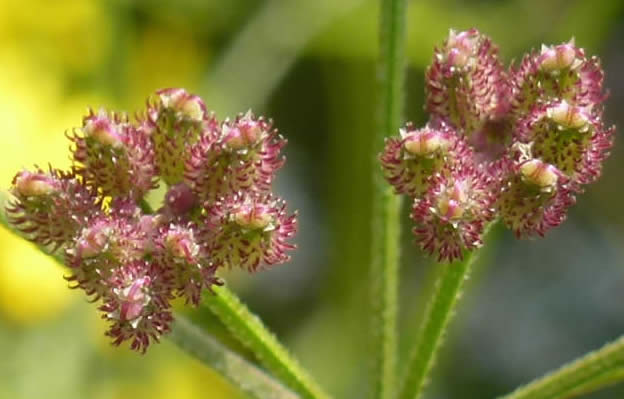
Upright hedge parsley: the fruit have purple hooked bristles (9 August)
27 July: lapwings on the flood, Norfolk hawker still (but for how long?), black-tailed skimmers.

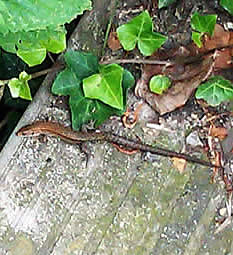

Recent sightings & photos from Julia Weaver: peacock butterfly (30 May); common lizard on railway bridge (10 July); large red damselfly on water soldier (25 July)
9 July: mullein moth caterpillars (see photospot, below), ringlet butterfly, four little ringed plovers, purple loosestrife flowering; grasshopper warblers singing at dusk on NWT walk.
Photospot: mullein moth caterpillars on figwort, 9 July 2012
5 July: little egret, wood sandpiper, lots of dragonflies.
30 June: four dragonfly species (see below) on the NWT open day in national insect week, plus their larvae and other aquatic life found in the pond-dipping, including a stickleback, leech, water boatman and various beetles. Plus water vole!
Dragons and damsels It's the ideal time to see dragonflies and damselflies. Dragonflies: look for the green-eyed Norfolk hawker, big emperors, hairy dragonfly and four-spot chasers, all in and around dykes. Black-tailed skimmers tend to land on stones on the path to the gate/stile (e.g. right). |
Left: male common blue damselfly, often abundant, with browner females. The pink behind is ragged robin. |
26 June: wood sandpiper reported, also on 24/6; little ringed plovers; still lots of bird song, including grasshopper warbler; common tern; dragonflies and damselflies showing, at last (see right).
21 June, on RSPB Norwich local group walk: two singing grasshopper warblers among eight warbler species; a distant flying little egret; common tern.
15 June, on evening NWT walk: wonderful views of barn owl, two marsh harriers, two little ringed plovers, cuckoo singing still.

Grasshopper warbler, 9 June.
7 June, dusk: grasshopper warbler singing by the railway bridge; cuckoo. Barn owl, marsh harrier and garden warbler reported by other birdwatchers. Valerian in flower.
31 May, evening: at least four reed buntings singing, and a barn owl. Yellow flag irises looking gorgeous in the evening light.
23 May: I was lucky enough to see a female orange-tip butterfly laying eggs on lady's smock. She seemed to be selecting those in bud - presumably the freshest and most nutritious for the caterpillar.
Left: the egg is on the stalk of the right hand flower bud. Right: female orange tip taking nectar on early wintercress.
21 May: lots of low-flying feeding house martins and swifts over the broad and the flood on a cool and overcast NWT walk (see full list in the RH column). Right: this slightly tatty eyed hawkmoth Smerinthus ocellata was found by a group member. The 'eye' is just visible on the left hindwing. Larval foodplants include sallow (pussy willow), common on Thorpe Marshes. |
20 May: a cuckoo was seen and heard singing its two-note song with a musical interval of a major third - rather than the classic minor third of a spring cuckoo. Follow the link for more on the minor third in cuckoos, other birds and culture. Two birdwatchers reported a marsh harrier. Sedge, reed, Cetti's and willow warblers, whitethroats and reed buntings all singing.
7 May: reed warblers and whitethroats are in, lots of swifts and house martins. Hobby and yellow wagtail.
20 April: on NWT walk: grasshopper warbler heard, sedge & willow warblers, meadow pipit in song flight, 38 tufted ducks.
17 April: 2 swallows; single sedge & willow warblers singing; 2 male red buntings. Eight tufted ducks, 3 of which were females, on the broad: will any stay to breed or are these a non-breeding group? The cattle are back - this year including red polls, a hardy breed. Later: 2 cuckoos, 2 buzzards over, 6 swallows, 3 little ringed plovers, 2 teal (RC).
8 April: single sedge & willow warblers and a handful of sand martins reported, but main arrivals not yet in (though willow warblers over the river at Whitlingham CP yesterday).
2 April: goldeneye has gone! 5 stock doves (they are regular here).
1 April: male goldeneye still there, gadwalls in display flight.
31 March: 4 little ringed plovers, 6 Cetti's warblers singing, 1st willow warbler heard (MB)
28 March – goldeneye still, 4 oystercatchers (2 on territory, perhaps), first lady's smock flowers. Picnics and BBQs in the warm weather - and why not?
23 March (on guided walk) – several chiffchaffs, goldeneye, brimstone buttterfly, reed buntings and Cetti's warblers singing.
20 March – first chiffchaff singing, first marsh marigold of the year
15 March – 112 tufted ducks, 1 immature male goldeneye, 1 black-tailed godwit, kingfisher.
14 March – 1 avocet swimming on the gravel pit
1 March – 30 lapwings, 47 pochards, 2 oystercatchers, water rail calling, red admiral butterfly.
29 February – 1 green sandpiper, mallards back having been absent all winter.
Fungus feature

James Emerson found and photographed the blackfoot polypore, left, growing on a willow in the wooded area between Bungalow Lane and the river (29 June). He also found a name for the orange rust growing on meadowsweet: it is Triphragmium ulmariae, and it's near the gate (photo 30 June). Other meadowsweet plants have a white mildew on them, best guess Erysiphe ulmariae. (Meadowsweet is Filipendula ulmariae, so the names seem to link well.
Our main Thorpe Marshes page.


